TRENDNET TEW821DAP AC1200 Dual Band PoE Access Point User Manual
TRENDNET, Inc. AC1200 Dual Band PoE Access Point Users Manual
TRENDNET >
Users Manual
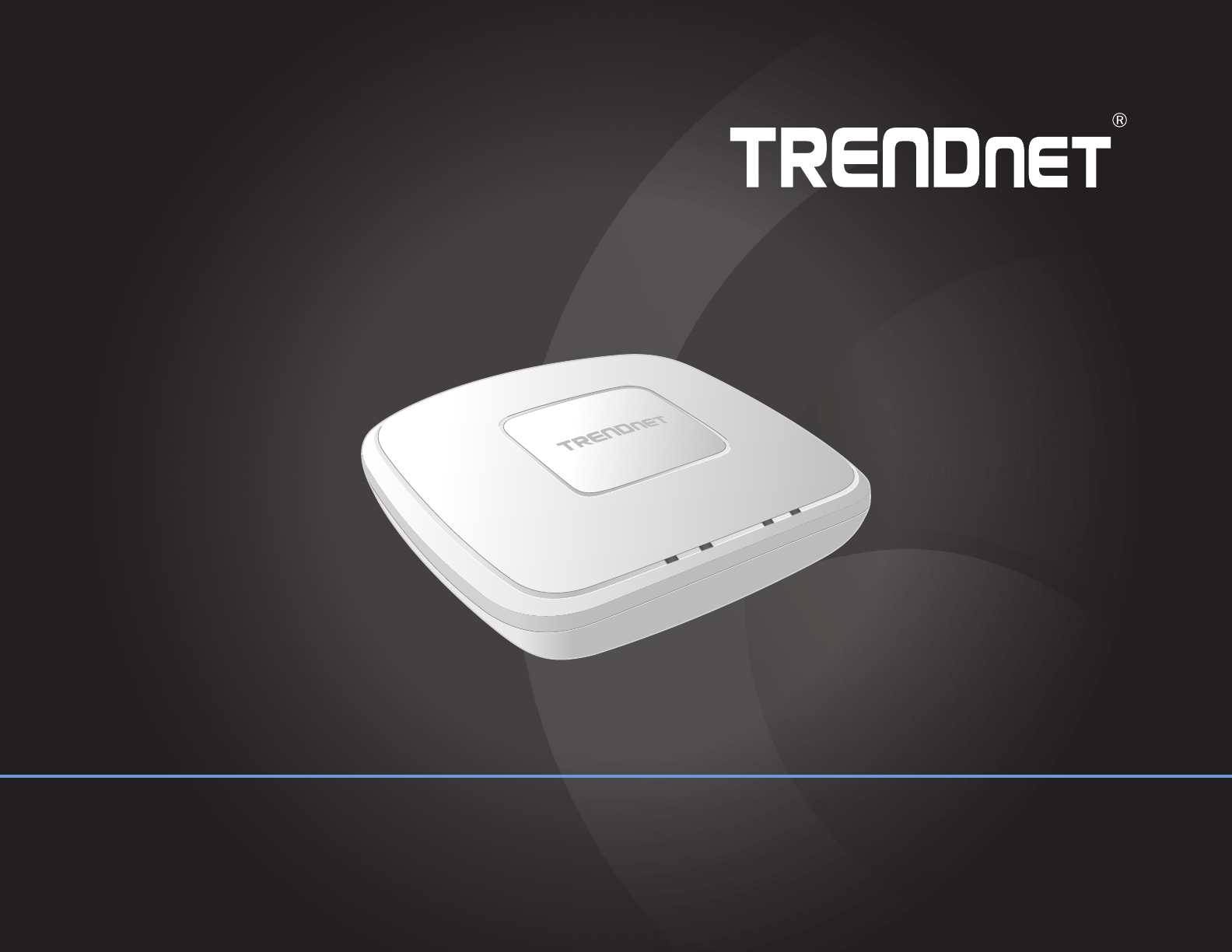
2.4GHz
5GHz
LAN PWR
TEW-821DAP
User’s Guide
Dual Band Wireless Access Point

TRENDnet User’s Guide
Table of Contents
2
© Copyright 2015 TRENDnet. All Rights Reserved.
Table of Contents
Product Overview ............................................................................5
Features .........................................................................................5
Package Content ............................................................................5
Hardware Overview .......................................................................6
Front View ................................................................................6
Rear View .................................................................................6
Wireless Consideraons ................................................................7
Connecon Performance ..........................................................7
Security Checklist ......................................................................7
Installaon ......................................................................................8
Connect the Power ........................................................................8
Connect the Computer ..................................................................8
Check the Connecons ..................................................................8
Ceiling Mounng ............................................................................9
Inial Setup ................................................................................... 10
Congure the Computer ..............................................................10
Windows 7/8/8.1 ...................................................................10
Windows Vista ........................................................................10
Windows XP/2000 ..................................................................10
Log in to Management Page ........................................................10
Default Sengs ......................................................................10
Access the Management Page ...............................................10
Setup Wizard ..........................................................................11
Save / Reload ..........................................................................12
Access Point Mode Management Page Structure ........................13
Client Bridge/AP Repeater Mode Management Page Structure ..13
Basic System Conguraons ..........................................................14
Access Point Mode .......................................................................14
Conguring the Device as Access Point ..................................15
Using Access Point Mode........................................................15
Wireless Networking and Security..........................................17
Choose the Security Type for Wireless Network .....................18
Secure your Wireless Network................................................19
Connect Wireless Devices to your Access Point ......................20
Connect Wireless Devices using WPS .....................................20
Client Bridge Mode ......................................................................21
Conguring the Device as Client Bridge .................................22
Using Client Bridge Mode .......................................................22
Repeater Mode ............................................................................ 22
Conguring the Device as Repeater .......................................23
Using Repeater Mode .............................................................23
Wireless Distribuon System (WDS) ............................................23
WDS Bridge ............................................................................23

TRENDnet User’s Guide
Table of Contents
3
© Copyright 2015 TRENDnet. All Rights Reserved.
Creang a WDS Bridge ........................................................... 25
Using a WDS Bridge ...............................................................25
WDS Access Point ........................................................................26
Creang a WDS Access Point ..................................................26
Using a WDS Bridge ...............................................................26
WDS Staon .................................................................................27
Creang a WDS Staon .......................................................... 28
Using a WDS Staon ..............................................................28
View System Status .......................................................................28
System Informaon ......................................................................28
2.4G Wireless Client List ..............................................................29
5G Wireless Client List .................................................................29
System Log ...................................................................................30
Congure IP Sengs ....................................................................30
Congure Spanning Tree ..............................................................31
Enable Band Steering ................................................................... 31
IPv6 Sengs .................................................................................32
Advanced System Conguraon ....................................................33
Congure Wireless Network Sengs ..........................................33
Basic Network Sengs ........................................................... 33
AP Detecon ...........................................................................34
SSID Sengs ...........................................................................34
Congure MAC Filter Sengs ......................................................35
Congure Wireless Advanced Sengs.........................................36
Connect Wireless Devices Using WPS .......................................... 38
PBC (Soware/Virtual Push Buon) ....................................... 38
PIN (Personal Idencaon Number) .....................................39
Congure Management VLAN Sengs ........................................39
Congure Trac Shaping Sengs ........................................... .....40
Congure SNMP Sengs .............................................................41
Management > SNMP Sengs ....................................................41
Congure Schedule Sengs ........................................................42
Create a Schedule ...................................................................42
Edit a Schedule .......................................................................43
Enable CLI ....................................................................................43
Management .................................................................................44
Change Login Password ...............................................................44
Modify Menu Timeout ........................................... ...................... 44
Change Device Name ................................................................... 45
Set Date and Time ........................................................................45
Congure LED Indicators ..............................................................46
Backup / Restore System Sengs ................................................ 46
Update System Firmware .............................................................47
Congure System Log Server .......................................................47
Execute Diagnoscs Test ..............................................................48
System Reboot .............................................................................49

TRENDnet User’s Guide
Table of Contents
4
© Copyright 2015 TRENDnet. All Rights Reserved.
SmartConsole ................................................................................ 49
Install the SmartConsole .............................................................. 49
SmartConsole Overview ..............................................................50
Using the SmartConsole ..............................................................51
Appendix .......................................................................................52
Specicaons ...............................................................................52
Federal Communicaon Commission Interference Statement ....54
Europe – EU Declaraon of Conformity ....................................... 54
Industry Canada Statement: ........................................................55
Limited Warranty .........................................................................56
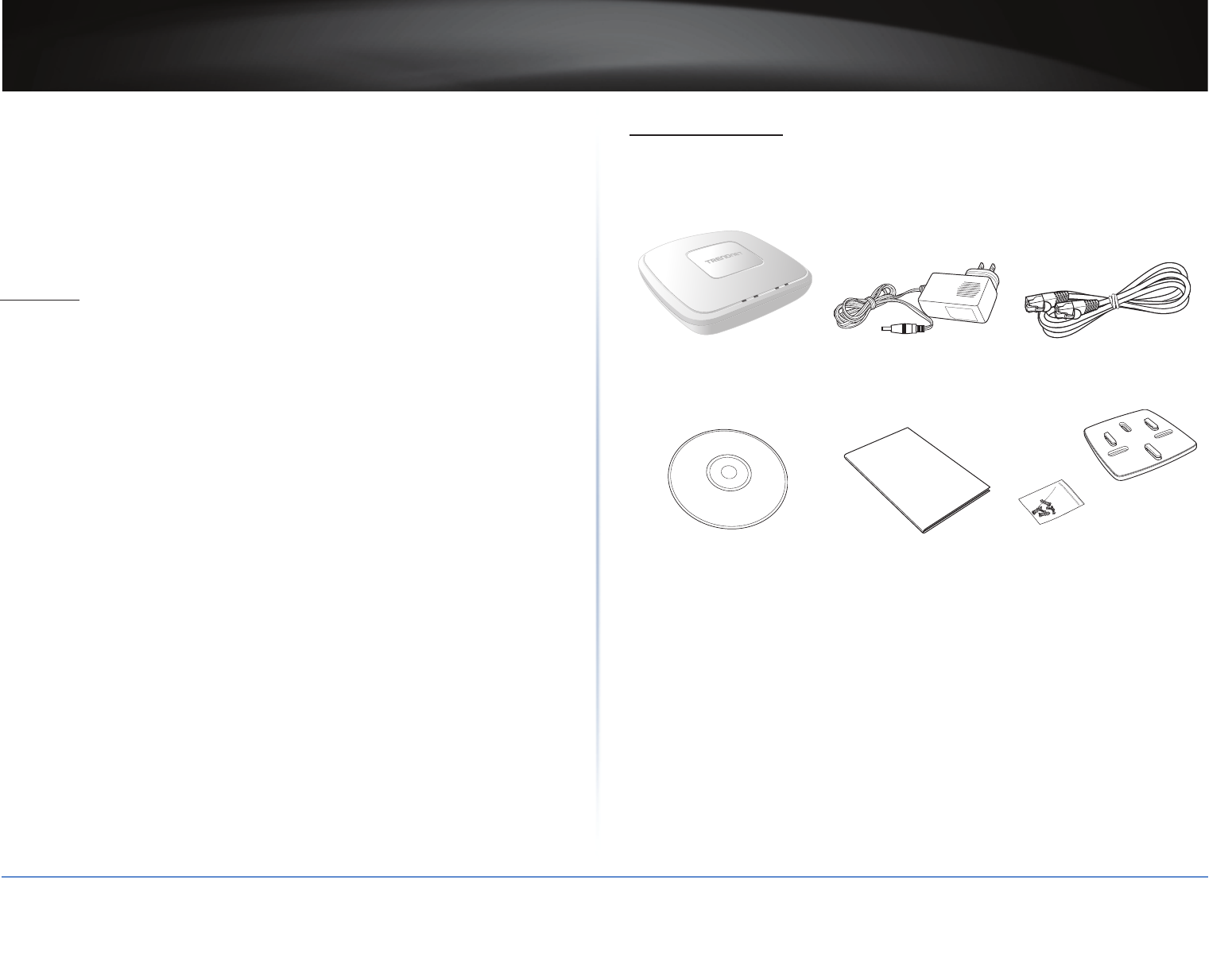
TRENDnet User’s Guide
TEW-821DAP
5
© Copyright 2015 TRENDnet. All Rights Reserved.
Product Overview
TRENDnet’s AC1200 Dual Band PoE Access Point, model TEW-821DAP, supports Access
Point (AP), Wireless Distribuon System (WDS) Bridge, AP + WDS, Client Bridge, and
Repeater mode funconality. A convenient wireless scan feature streamlines the
WDS setup process. Mulple SSIDs are supported for each band. The web-based
management page allows you to congure your Access Point easily.
Features
• Compable with IEEE 802.11ac technology:
2TX/2RX wireless speed up to 866Mbps data rate
• Compable with IEEE 802.11n high rate standard to provide wireless speed of
300Mbps data rate
• Compable with IEEE 802.11g high rate standard to provide wireless speed of
54Mbps data rate
• Compable with IEEE 802.3at PoE
• Simultaneously transmit both 2.4 GHz and 5 GHz wireless networks
• IEEE 802.11b/g/n/ac Infrastructure operang modes
• 1 x 10/100/1000Mbps Gigabit Ethernet port with PoE funcon
• Supports Mulple Input Mulple Output(MIMO) technology with 2TX/2RX(11a/b/
g/n/ac)
• Allow auto fallback data rate for opmized reliability, throughput and transmission
range
• Supports wireless data encrypon with 64/128-bit WEP standard for security
• Supports enhance security for WPA-PSK, WPA2-PSK, WPA and WPA2
• Advance wireless security of up to WPA2-RADIUS
• Web-based conguraon tools and management via WEB Browser
• Supports WPS (Wi-Fi Protected Setup Specicaon Windows)
• Supports stascs informaon
• Supports Wireless Distribuon System (WDS) for wireless network bridging
Package Content
Check if your package contains the following items. If any item is missing or appears
damaged, contact your dealer.
2.4GHz
5GHz
LAN PWR
Access Point Power Adapter (12V, 1A) RJ-45 Ethernet cable
Quick Start Guide
CD-ROM (User’s Guide) Quick Start Guide Mounng kit
(incl. bracket + screws)
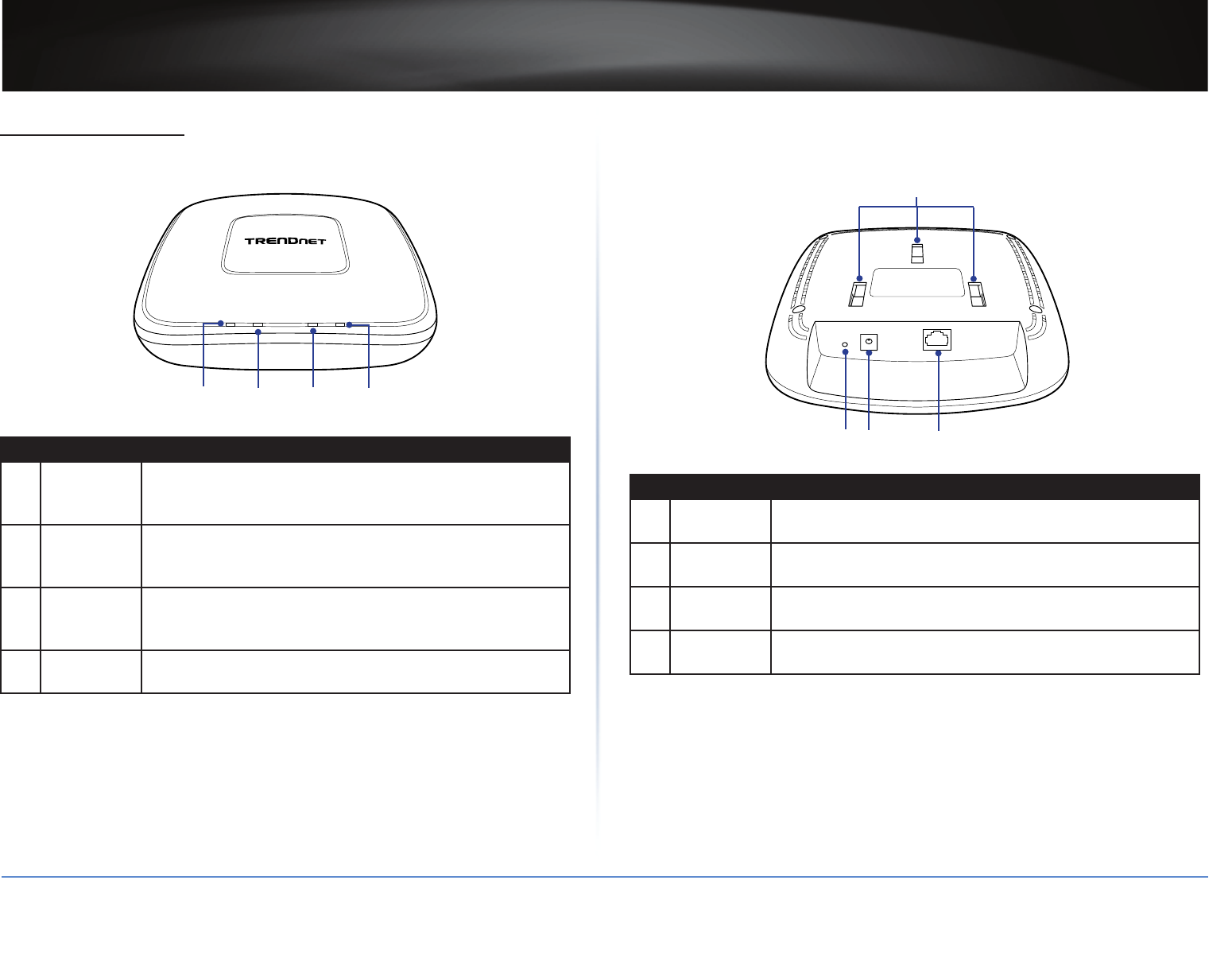
TRENDnet User’s Guide
TEW-821DAP
6
© Copyright 2015 TRENDnet. All Rights Reserved.
Hardware Overview
Front View
LAN PWR
5GHz
2.4GHz
j k l m
No. Item Descripon
1 2.4G LED The indicator turns on solid green when the wireless is enabled
on your access point. This LED blinks green during data
transmission.
2 5G LED The indicator turns on solid green when the wireless is enabled
on your access point. This LED blinks green during data
transmission.
3LAN LED The indicator turns on solid green when the wireless is enabled
on your access point. This LED blinks green during data
transmission.
4 POWER LED A solid green light indicates a proper connecon to the power
supply.
Rear View
LANDC INRESET
jkl
m
No. Item Descripon
1Reset Buon Use a sharp tool to press and hold this buon for 10 seconds to
reset the access point.
2 Power
connector
Connect the power adapter from your access point power port
to an available power outlet.
3LAN Port Connect the Ethernet cable (also called network cables) from
your access point to your router and wired network devices.
4Mounng
holes
Aach the mounng plate here.

TRENDnet User’s Guide
TEW-821DAP
7
© Copyright 2015 TRENDnet. All Rights Reserved.
Wireless Consideraons
Connecon Performance
A number of factors aect the performance of wireless connecon. Consider the
following guidelines to ensure high-range and stable connecvity.
9Adjust your wireless devices so that the signal is traveling in a straight path, rather
than at an angle. The more material the signal has to pass through the more signal
you will lose.
9Keep the number of obstrucons to a minimum. Each obstrucon can reduce
the range of a wireless device. Posion the wireless devices in a manner that will
minimize the amount of obstrucons between them.
9Building materials can have a large impact on your wireless signal. In an indoor
environment, try to posion the wireless devices so that the signal passes through
less dense material such as dry wall. Dense materials like metal, solid wood, glass or
even furniture may block or degrade the signal.
9Antenna orientaon can also have a large impact on your wireless signal. Use the
wireless adapter’s site survey tool to determine the best antenna orientaon for
your wireless devices.
9Interference from devices that produce RF (radio frequency) noise can also impact
your signal. Posion your wireless devices away from anything that generates RF
noise, such as microwaves, radios and baby monitors.
9Any device operang on the 2.4GHz frequency will cause interference. Devices
such as 2.4GHz cordless phones or other wireless remotes operang on the 2.4GHz
frequency can potenally drop the wireless signal. Although the phone may not be
in use, the base can sll transmit wireless signal. Move the phone’s base staon as
far away as possible from your wireless devices.
If you are sll experiencing low or no signal consider reposioning the wireless devices
or installing addional access points. The use of higher gain antennas may also provide
the necessary coverage depending on the environment.
Security Checklist
Wireless networks are easy to install and convenient to use. However, wireless network
signals can also be intercepted easily.
To prevent unauthorized users from connecng to your wireless network, follow the
guidelines below.
9Change the default wireless network name
Your device has a default Service Set Idener (SSID) which is the wireless network
name. Change the SSID with a unique name to idenfy your network. The SSID can be
up to 32 characters in length.
9Change the default password
Your device has a default password. You have to enter this password to change your
network sengs. Change the password to prevent unauthorized users from hacking
into your network and changing the sengs.
9Enable MAC address ltering
Your device supports Media Access Control (MAC) address ltering. You can assign a
MAC address on each computer that you want to connect to your wireless network.
When MAC address ltering is enabled, only the computers with the specied MAC
addresses are allowed access.
9Enable encrypon
Your device supports Wired Equivalent Privacy (WEP), and Wi-Fi Protected Access
(WAP/WPA2) encrypon. To ensure a high level of security, enable the highest
security encrypon and use strong passphrases, avoid using words that can be found
in the diconary.
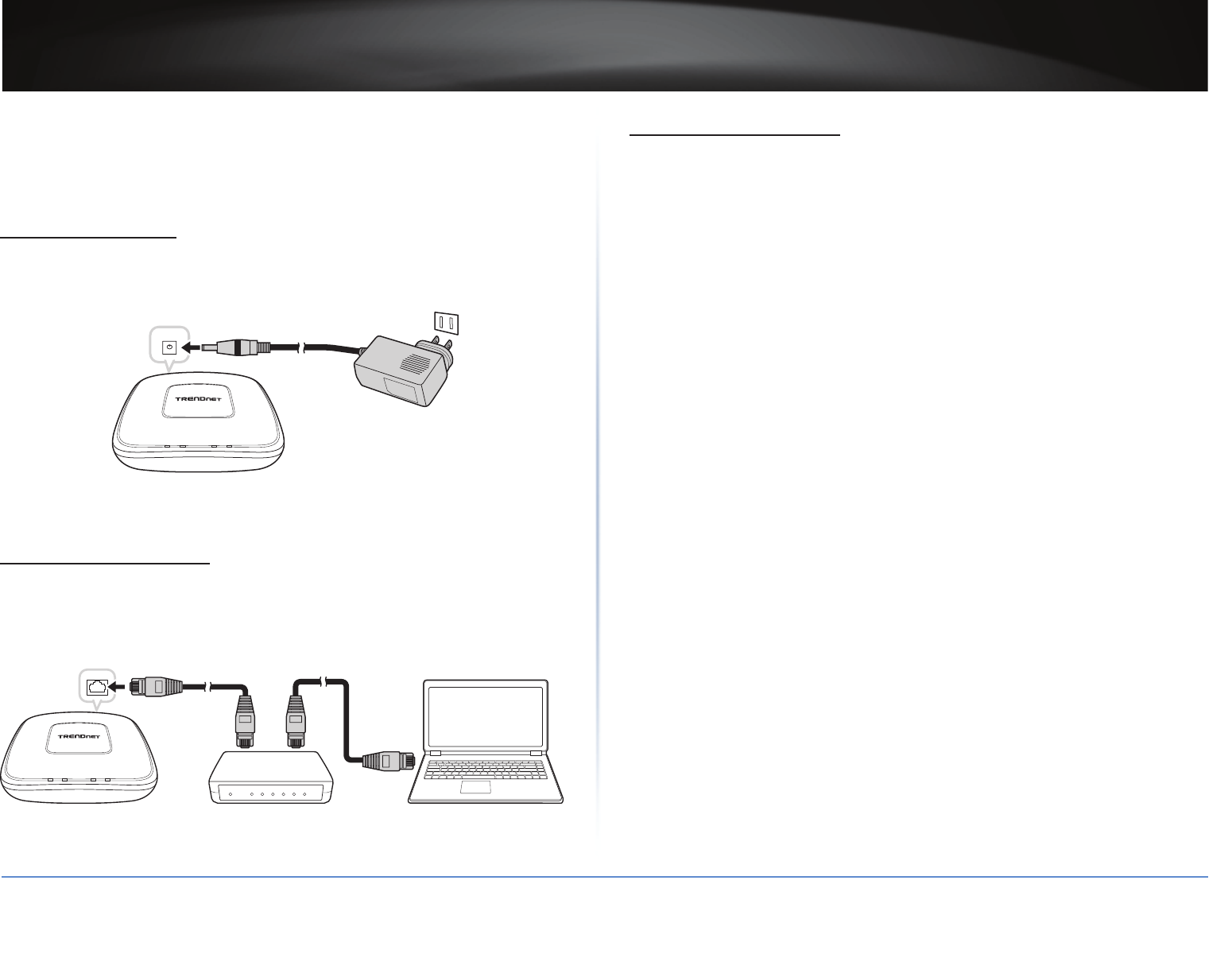
TRENDnet User’s Guide
TEW-821DAP
8
© Copyright 2015 TRENDnet. All Rights Reserved.
Installaon
Make sure that all devices are powered o before starng installaon.
Connect the Power
1 Connect the power adapter to the power port of your access point.
2 Plug the power adapter to a power outlet.
The access point powers up automacally.
DC IN
LAN PWR
5GHz
2.4GHz
ÍNote: Use only the supplied power adapter. Using other power adapters may cause
damage to the device.
Connect the Computer
1 Connect one end of the rst RJ-45 cable to the Ethernet port of your access point.
2 Connect the other end of the rst RJ-45 cable to the PoE switch.
3 Connect one end of the second RJ-45 cable to the PoE switch.
4 Connect the other end of the second RJ-45 cable to the LAN port of your computer.
LAN PWR
5GHz
2.4GHz
LAN
TEW-821DAP PoE switch Computer
Check the Connecons
To ensure that all devices are properly connected, check the LED indicators on the front
of your access point. For basic installaon, the following LED must be lit:
9Power LED
9LAN LED
92.4G LED
95G LED
The lighted LED indicators vary depending on the type of connecon that you make. Refer
to “Front View” on page 6 for more informaon on LED indicators.
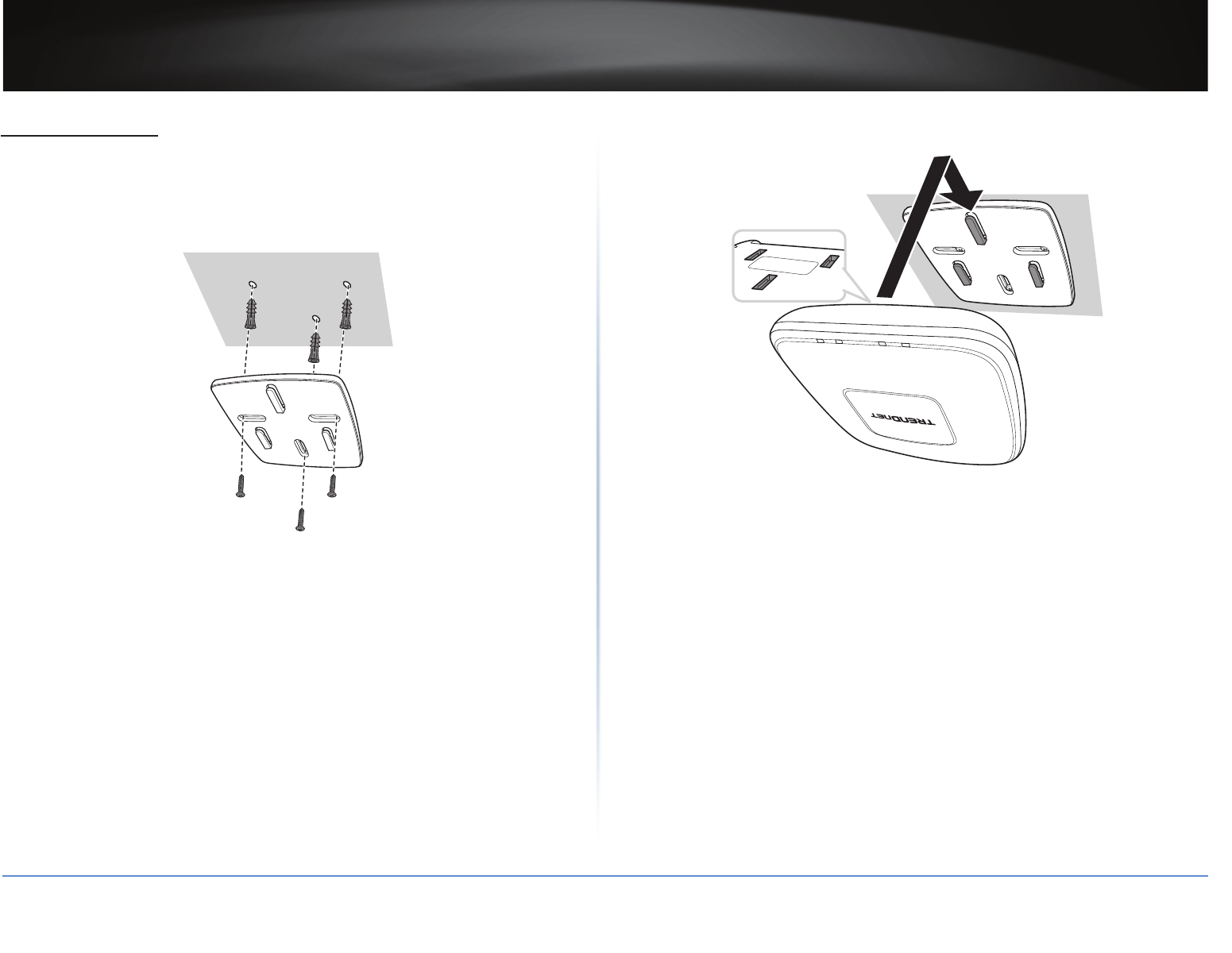
TRENDnet User’s Guide
TEW-821DAP
9
© Copyright 2015 TRENDnet. All Rights Reserved.
Ceiling Mounng
To ceiling mount the access point, do the following:
1 Drill three small holes on the mounng locaon and insert the plasc washers into the
holes.
2 Then place the three supplied screws into the three holes at the ceiling bracket, and
secure them into the holes on the ceiling.
3 Align and hook the TEW-821DAP to the ceiling bracket, and then push down to secure
it into place.
LAN
PWR
5GHz
2.4GHz
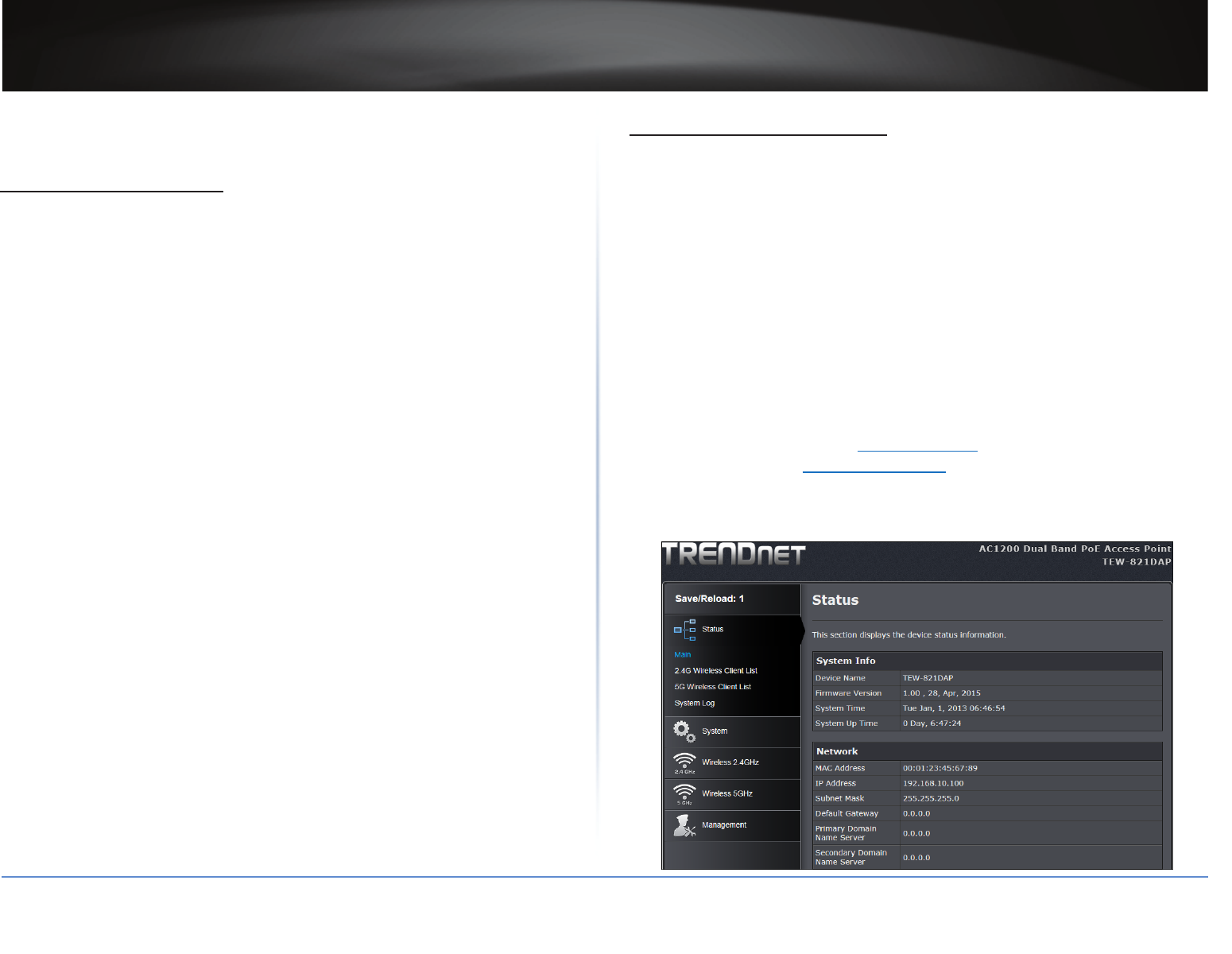
TRENDnet User’s Guide
TEW-821DAP
10
© Copyright 2015 TRENDnet. All Rights Reserved.
Inial Setup
Congure the Computer
Below are procedures on how to congure your computer according to the operang
system you are using:
Windows 7/8/8.1
1 Click Start > Control Panel > Network and Sharing Center > Change Adapter Sengs.
2 Right-click the Local Area Connecon icon.
3 Click Properes. Then click Internet Protocol Version 4 (TCP/IPv4).
4 Select Use the following IP address.
5 Enter the required IP address and Subnet mask.
6 Click OK.
Windows Vista
1 Click Start > Control Panel > Network and Internet > Manage Network Connecons.
2 Right-click the Local Area Connecon icon, and then click Properes.
3 Click Internet Protocol Version 4 (TCP/IPv4), and then click Properes.
4 Select Use the following IP address.
5 Enter the required IP address and Subnet mask.
6 Click OK.
Windows XP/2000
1 Click Start > Control Panel. Then double-click the Network Connecons icon.
2 Right-click the Local Area Connecon icon, and then click Properes.
3 Click Internet Protocol (TCP/IP), and then click Properes.
4 Select Use the following IP address.
5 Enter the required IP address and Subnet mask.
6 Click OK.
Log in to Management Page
Default Sengs
Before accessing the web-based management page, congure the IP address and subnet
mask of your computer to the following:
Management IP: 192.168.10.x
Subnet mask: 255.255.255.0
Administrator name: admin
Administrator password: admin
Default SSID: (printed on pre-set label)
Default SSID passphrase: (printed on pre-set label)
Access the Management Page
1 Open your web browser and do one of the following:
• enter the URL/domain name hp://tew-821dap, or
• enter the IP address hp://192.168.10.100.
2 Enter the default user name and password, select your preferred language, and then
click Login.
The main screen appears.
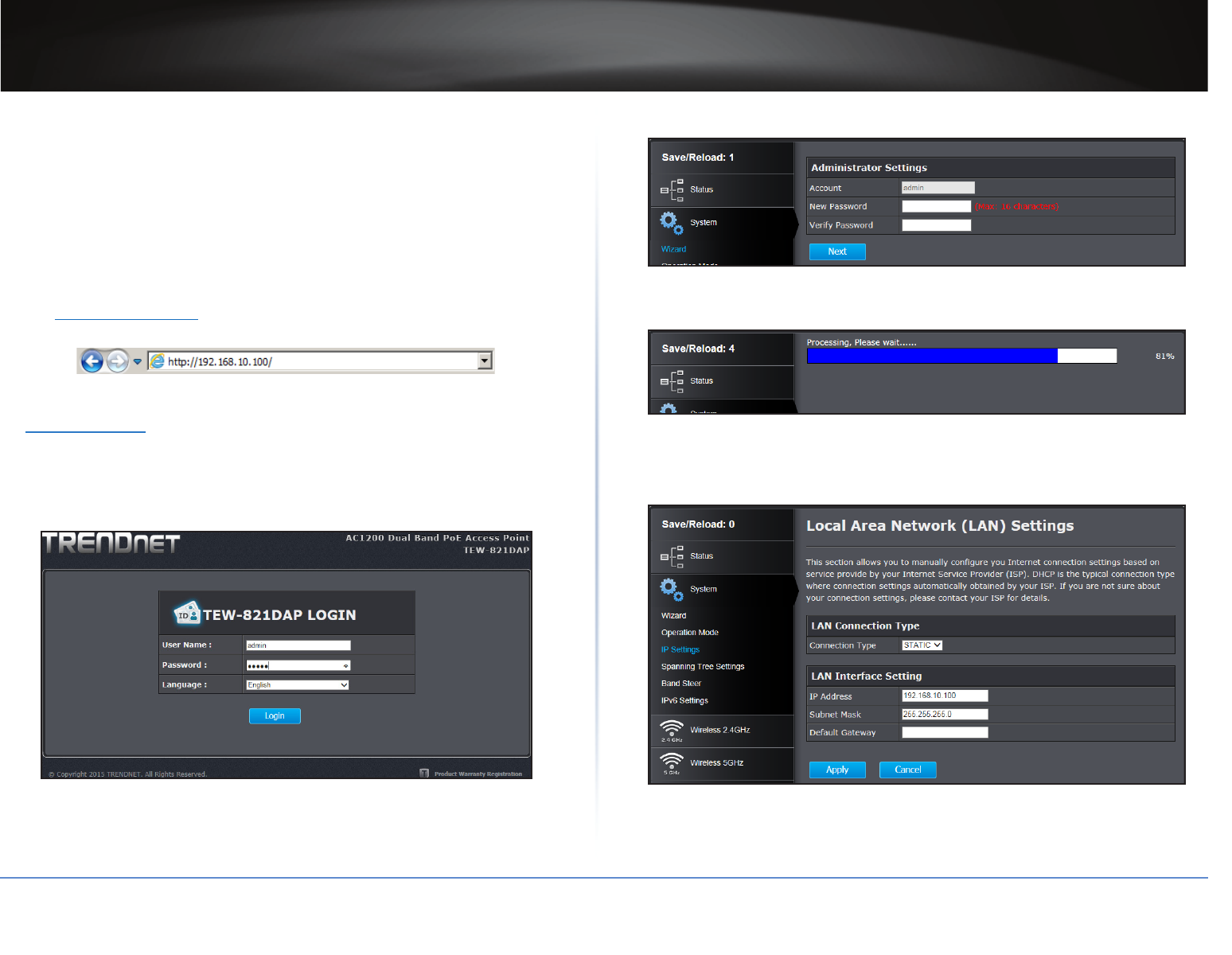
TRENDnet User’s Guide
TEW-821DAP
11
© Copyright 2015 TRENDnet. All Rights Reserved.
ÍNote:
• If you have changed the password in the Setup Wizard, you will need to login using
the new password.
• User name and Password are case sensive.
Setup Wizard
Setup wizard is provided as part of the web conguraon ulity. It sets up the basic
administrator password and management IP address.
1 Open your web browser (i.e. Internet Explorer, Firefox, Safari, Chrome, or Opera) and
enter hp://192.168.10.100. Your access point will prompt you for a user name and
password.
ÍNote: You can also access the device using the following URL/domain name:
hp://tew-821dap.
2 Enter the default user name and password, select your preferred language, and then
click Login.
Default User Name: Admin
Default Password: admin
ÍNote: User name and Password are case sensive.
3 Click System > Wizard. The following screen will appear.
4 Enter your new administrator password and then click Next to connue.
5 TEW-821DAP will apply password change and the Local Area Network (LAN) Sengs
page opens.
6 Set the Connecon Type as “STATIC”. Enter the management IP address for this
TEW-821DAP. The default IP address is 192.168.10.100. Set it up in your network
management subnet with a unique IP address. You can leave it set on default IP if you
have only one TEW-821DAP on network. Click Apply.
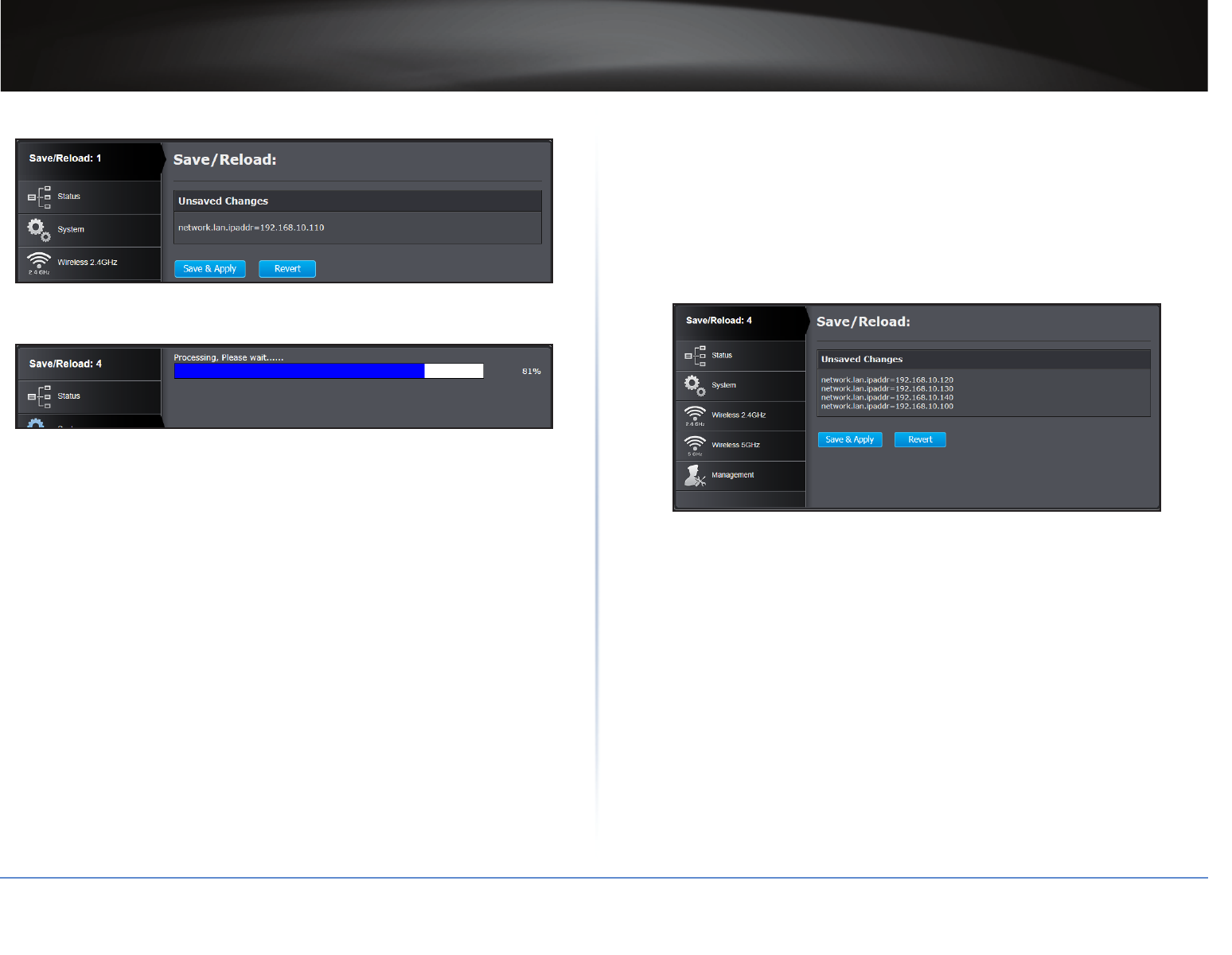
TRENDnet User’s Guide
TEW-821DAP
12
© Copyright 2015 TRENDnet. All Rights Reserved.
7 Click Save & Apply.
8 TEW-821DAP will apply IP address change and then reboot. Login, using the new IP
address and/or new password.
Save / Reload
The TEW-821DAP is a commercial grade wireless access point. To make mulple network
sengs change at the same me and minimum the interrupon of producon network,
all network conguraons have to be changed in two stages.
When you change a network seng, the change command will be saved in a queue.
When you nish all the seng changes, click Save & Apply. If you want to cancel the
changes, click Revert.
The number that follows Save/Reload is a reminder that shows how many changes are in
the queue waing to be applied.

TRENDnet User’s Guide
TEW-821DAP
13
© Copyright 2015 TRENDnet. All Rights Reserved.
Access Point Mode Management Page Structure
Status
• Main
• 2.4G Wireless Client List
• 5G Wireless Client List
• System Log
System
• Wizard
• Operaon Mode
• IP Sengs
• Spanning Tree Sengs
• Band Steer
• IPv6 Sengs
Wireless 2.4GHz
• Wireless Network
• Wireless MAC Filter
• Wireless Advanced Sengs
• WPS
Wireless 5GHz
• Wireless Network
• Wireless MAC Filter
• Wireless Advanced Sengs
• WPS
Management
• Administraon
• Management VLAN
• Wireless Trac Shaping
• SNMP Sengs
• Backup/Restore Sengs
• Upload Firmware
• Time and Date Sengs
• Schedule
• CLI Sengs
• Log
• Diagnoscs
• LED Control
Client Bridge/AP Repeater Mode Management Page Structure
Status
• Main
• 2.4G Wireless Client List
• 5G Wireless Client List
• System Log
System
• Wizard
• Operaon Mode
• IP Sengs
• Spanning Tree Sengs
• Band Steer
• IPv6 Sengs
Wireless 2.4GHz
• Wireless Network
• Wireless Advanced Sengs
Wireless 5GHz
• Wireless Network
• Wireless Advanced Sengs
Management
• Administraon
• Management VLAN
• Wireless Trac Shaping
• SNMP Sengs
• Backup/Restore Sengs
• Upload Firmware
• Time and Date Sengs
• Schedule
• CLI Sengs
• Log
• Diagnoscs
• LED Control
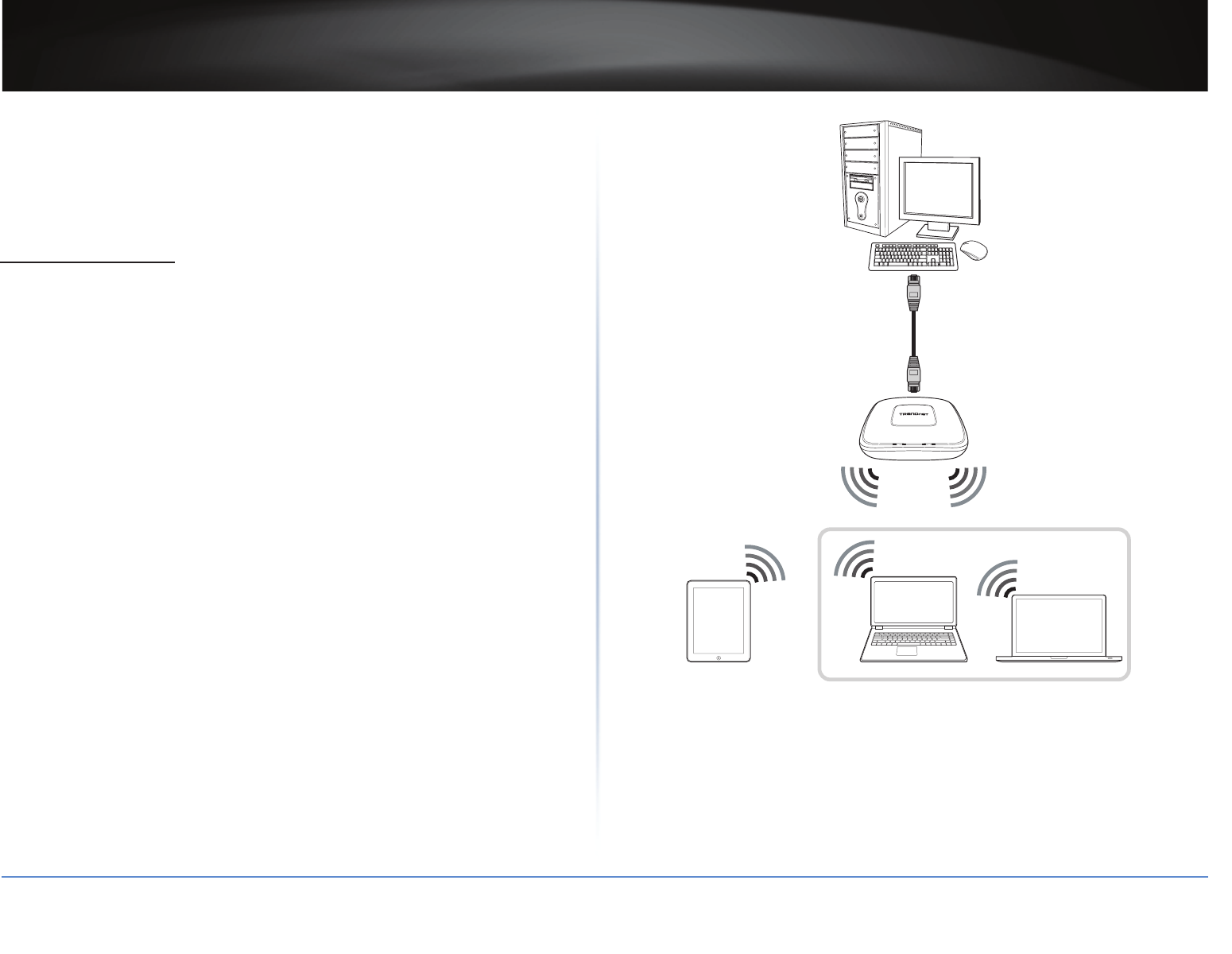
TRENDnet User’s Guide
TEW-821DAP
14
© Copyright 2015 TRENDnet. All Rights Reserved.
Basic System Conguraons
There are four operang modes provided by TEW-821DAP, Access Point, Client Bridge,
WDS and Repeater. Congure the TEW-821DAP to dierent operaon mode which
service the best in your network.
Access Point Mode
This is the default operaon mode. TEW-821DAP service wireless end points in this
mode. You can setup local or remote wireless authencaon, setup up to 8 sets of SSIDs
in 2.4GHz band and 5GHz band, total 16 SSIDs and separate SSID or STA trac.
ÍNote: This device has dual band wireless capability allowing the access point to
broadcast a wireless network name on two separate bands, 2.4GHz and 5GHz.
Wireless clients can connect to your access on either band depending on the wireless
band supported by your wireless client. The 2.4GHz band is more commonly used and
supported for general applicaons such as Internet access and web browsing. The
5GHz band is less commonly used and supported which can be more useful for higher
or stable bandwidth applicaon requirements such as media streaming as this band
may be less likely aected by neighboring wireless networks operang on the 5GHz
band.
LAN PWR
5GHz
2.4GHz
Access Point
Mulple SSID
SSID/STA isolaon
• Total 16 SSIDs (8 SSIDs per
band) for dierent users
grouping.
• Selectable SSID or staon
(wireless client) isolaon.
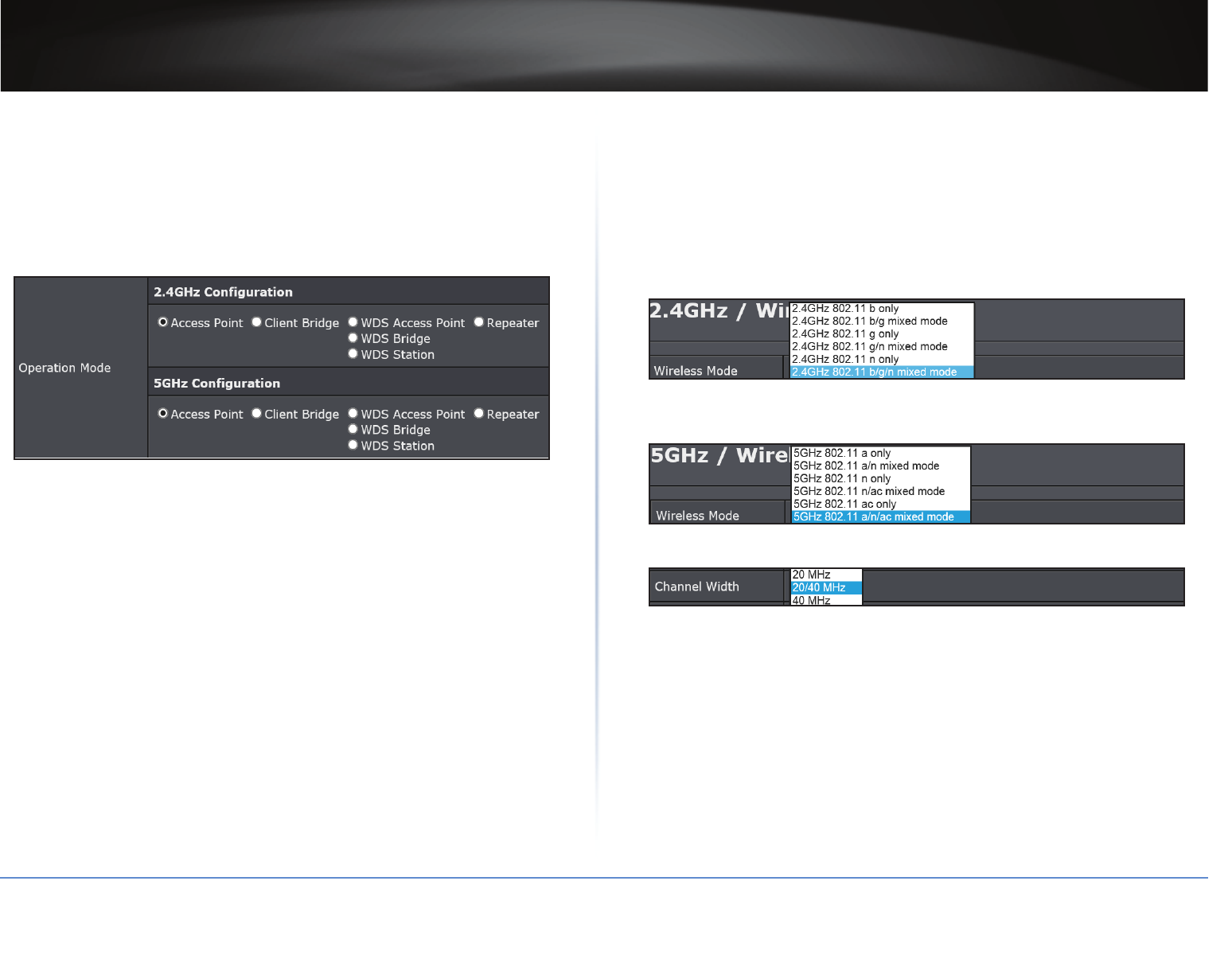
TRENDnet User’s Guide
TEW-821DAP
15
© Copyright 2015 TRENDnet. All Rights Reserved.
Conguring the Device as Access Point
System > Operaon Mode
ÍNote: By default, the device funcon is set to Access Point mode.
1 Log into your access point management page (refer to “Log in to Management Page”
on page 10).
2 Click System > Operaon Mode.
3 In Operaon Mode secon, select Access Point.
4 Click Apply to save changes.
ÍNote: To discard the changes, click Cancel.
Using Access Point Mode
Wireless 2.4GHz or Wireless 5GHz > Wireless Network
1 Log into your access point management page (refer to “Log in to Management Page”
on page 10).
2 Congure the following sengs, click Apply when nished.
• Wireless Mode: Choose between N only, G only, B only, B/G mixed, or B/G/N
mixed mode. The rule of the thumb is to choose single mode if your devices all
work in the same mode. Mixed mode increases compability, but somemes
lowers the data speed.
or
• Channel Width: Select the appropriate channel width for your wireless network.
20 MHz: This mode operates using a single 20MHz channel for wireless
devices connecng at 802.11n on both 2.4GHz and 5GHz. This seng may
provide more stability than Auto 20/40MHz for connecvity in busy wireless
environments where there are several neighboring wireless networks in the
area.
Auto 20/40MHz: When Auto 20/40MHz is acve, this mode is capable of
providing higher performance only if the wireless devices support the channel
bandwidth sengs. Enabling Auto 20/40MHz typically results in substanal
performance increases when connecng an 802.11n client.
The 40 MHz channel width allows for twice the usable radio spectrum to
transmit data, doubling performance compared to a normal 20 MHz channel
width.
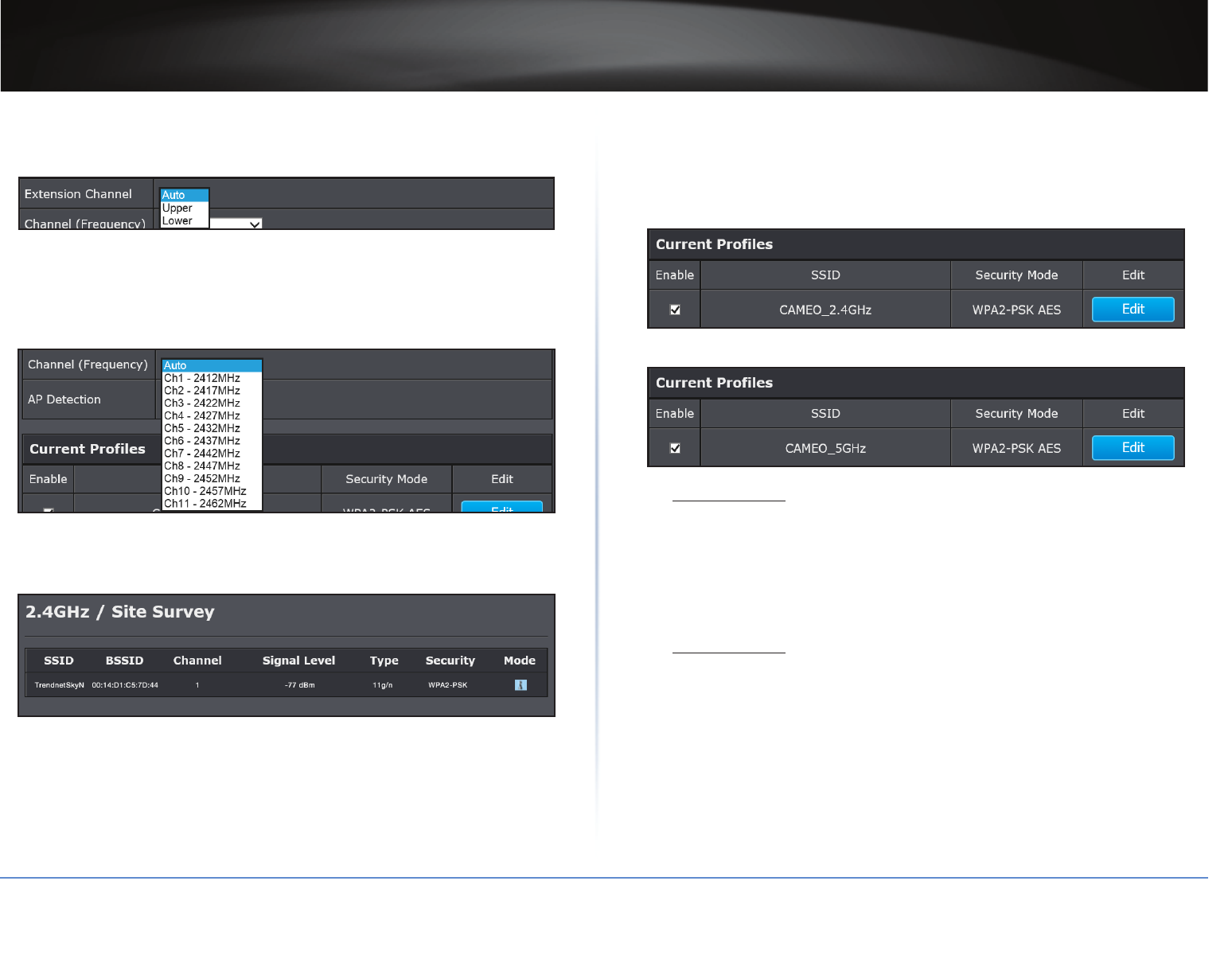
TRENDnet User’s Guide
TEW-821DAP
16
© Copyright 2015 TRENDnet. All Rights Reserved.
• Extension Channel: When you choose manual channel selecon and 20/40MHz
or 40MHz in channel width, you can choose which neighbour channel you want to
combine, upper channel or lower channel, or auto to let the device to decide.
• Channel (Frequency): If you want to setup xed channel, choose a channel
number to switch your radio frequency. Otherwise, check auto to select the
channel automacally which is selected by default. (When you choose 20/40MHZ
or 40MHz channel HT mode, the channel selecon list is shorter. Four marginal
channels are reserved for channel expansion.)
• AP Detecon: Before you setup your TEW-821DAP wireless sengs, you may want
to know what signal are currently broadcasng. Click Scan to do a site survey and
list the running access points around you.
• Current Prole: General setups opons for your 2.4GHz / 5GHz wireless
connecon. You can setup up to eight SSIDs for dierent groups of users. Do any
of the following:
Click the Enable checkbox to enable the wireless prole.
Click Edit to modify the sengs and aer modicaons are done, click Apply.
or
Wireless Sengs:
SSID: Select the human readable SSID to be easily idened. You can choose
any combinaon with 1 to 32 leers.
Hide SSID: Select this checkbox to hide the SSID in the outgoing beacon frame
so a staon cannot obtain the SSID through scanning using a site survey tool.
Separate Staons: If you enable staon separaon, wireless clients (a.k.a.
STAs) associated with this SSID cannot communicate to each other directly
even if they are in the same wireless group.
Wireless Security:
Security Mode: Choose between WEP-OPEN, WEP-SHARED, WEP-AUTO, WPA-
Personal, WPA2-Personal, WPA2-Personal Mixed, WPA-Enterprise, WPA2-
Enterprise Mixed. Please see more in “Wireless Networking and Security” on
page 17.
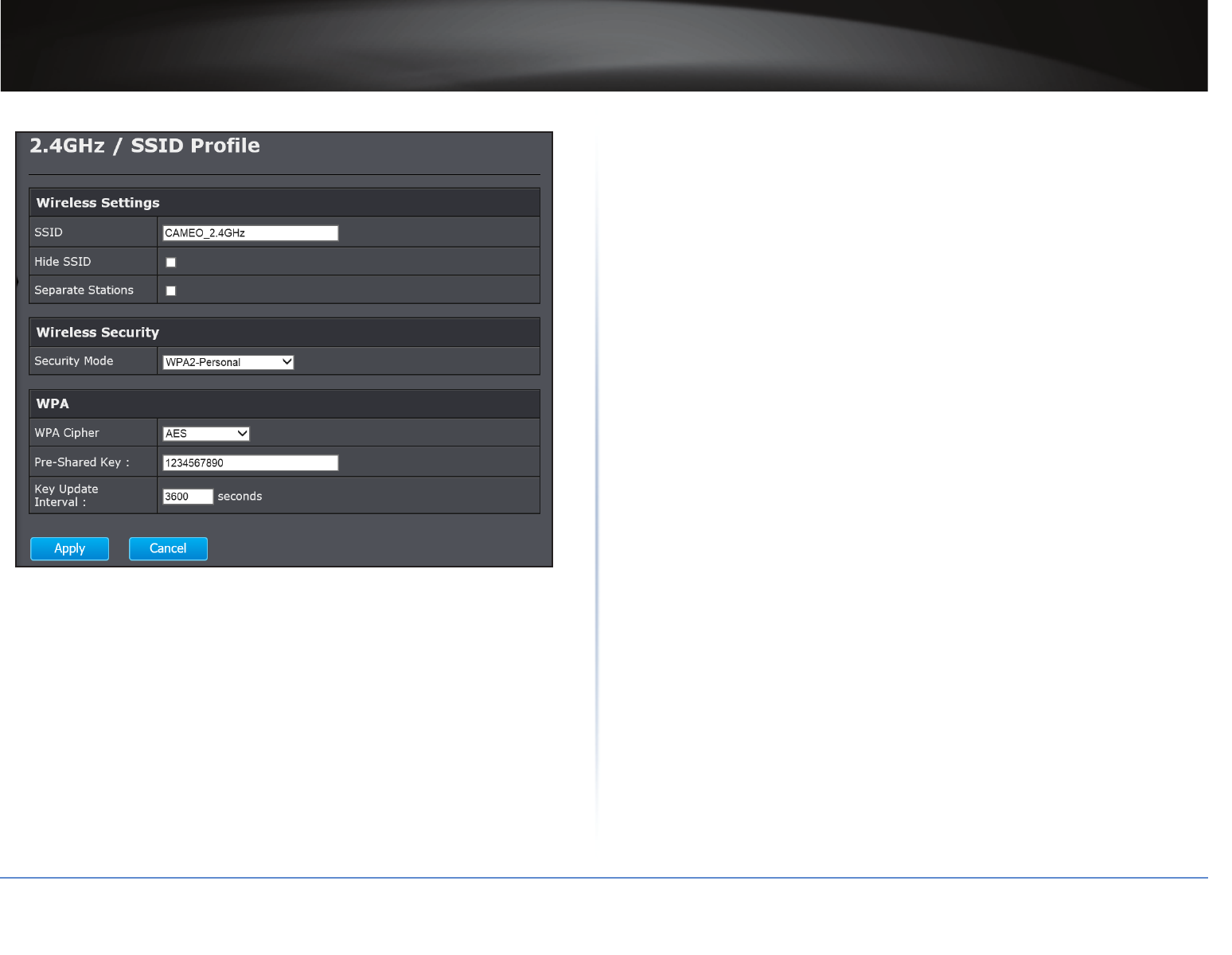
TRENDnet User’s Guide
TEW-821DAP
17
© Copyright 2015 TRENDnet. All Rights Reserved.
Wireless Networking and Security
Tips to Improve Wireless Recepon
There are a number of factors that can impact the range of wireless devices. Follow these
ps to help improve your wireless connecvity:
• Keep the number of obstrucons to a minimum. Each obstrucon can reduce
the range of a wireless device. Posion the wireless devices in a manner that will
minimize the amount of obstrucons between them.
9For the widest coverage area, install your access point near the center of your
home, and near the ceiling, if possible.
9Avoid placing the access point on or near metal objects (such as le cabinets and
metal furniture), reecve surfaces (such as glass or mirrors), and masonry walls.
9Any obstrucon can weaken the wireless signal (even non-metallic objects), so the
fewer obstrucons between the access point and the wireless device, the beer.
9Place the access point in a locaon away from other electronics, motors, and
uorescent lighng.
9Many environmental variables can aect the access point’s performance, so if
your wireless signal is weak, place the access point in several locaons and test
the signal strength to determine the ideal posion.
• Building materials can have a large impact on your wireless signal. In an indoor
environment, try to posion the wireless devices so that the signal passes through
less dense material such as dry wall. Dense materials like metal, solid wood, glass or
even furniture may block or degrade the signal.
• Antenna orientaon can also have a large impact on your wireless signal. Use the
wireless adapter’s site survey tool to determine the best antenna orientaon for your
wireless devices.
• Interference from devices that produce RF (radio frequency) noise can also impact
your signal. Posion your wireless devices away from anything that generates RF
noise, such as microwaves, radios and baby monitors.
If possible, upgrade wireless network interfaces (such as wireless cards in computers)
from older wireless standards to 802.11n or 802.11ac. If a wirelessly networked device
uses an older standard, the performance of the enre wireless network may be slower.
If you are sll experiencing low or no signal consider reposioning the wireless devices,
installing addional access points or wireless extenders.
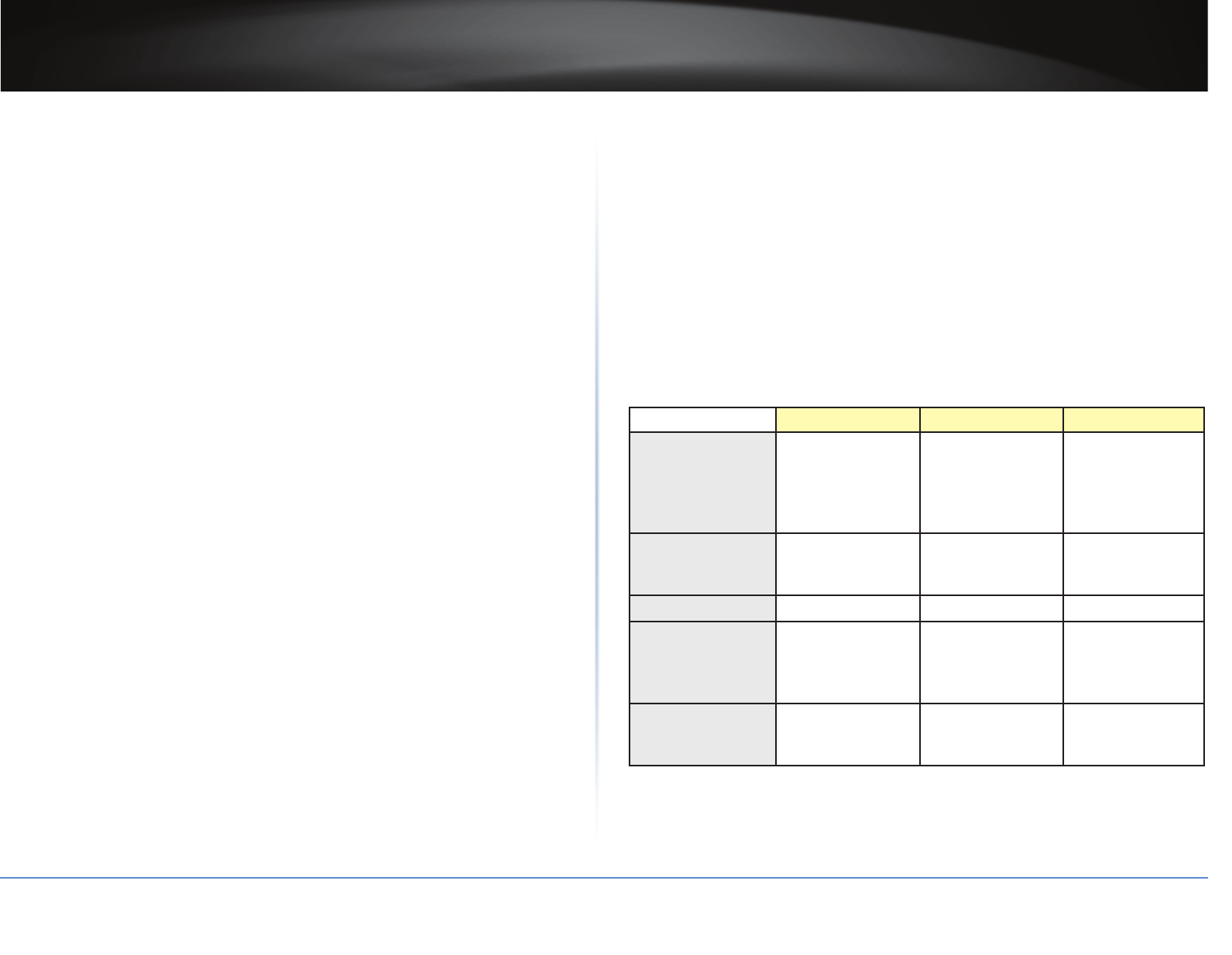
TRENDnet User’s Guide
TEW-821DAP
18
© Copyright 2015 TRENDnet. All Rights Reserved.
Choose the Security Type for Wireless Network
Seng up wireless security is very important. Leaving your wireless network open and
unsecure could expose your enre network and personal les to outsiders. TRENDnet
recommends reading through this enre secon and seng up wireless security on your
new access point.
There are a few dierent wireless security types supported in wireless networking each
having its own characteriscs which may be more suitable for your wireless network
taking into consideraon compability, performance, as well as the security strength
along with using older wireless networking hardware (also called legacy hardware).
It is strongly recommended to enable wireless security to prevent unwanted users from
accessing your network and network resources (personal documents, media, etc.).
In general, it is recommended that you choose the security type with the highest strength
and performance supported by the wireless computers and devices in your network.
Please review the security types to determine which one you should use for your
network.
Wireless Encrypon Types
• WEP: Legacy encrypon method supported by older 802.11b/g hardware. This is the
oldest and least secure type of wireless encrypon. It is generally not recommended
to use this encrypon standard, however if you have old 802.11 b or 802.11g wireless
adapters or computers with old embedded wireless cards(wireless clients), you may
have to set your access point to WEP to allow the old adapters to connect to the
access point.
ÍNote:
• This encrypon standard will limit connecon speeds to 54Mbps.
• WPA: This encrypon is signicantly more robust than the WEP technology. Much of
the older 802.11g hardware was been upgraded (with rmware/driver upgrades) to
support this encrypon standard. Total wireless speeds under this encrypon type
however are limited to 54Mbps.
• WPA-Auto: This seng provides the access point with the ability to detect
wireless devices using either WPA or WPA2 encrypon. Your wireless network
will automacally change the encrypon seng based on the rst wireless device
connected. For example, if the rst wireless client that connects to your wireless
network uses WPA encrypon your wireless network will use WPA encrypon. Only
when all wireless clients disconnect to the network and a wireless client with WPA2
encrypon connects your wireless network will then change to WPA2 encrypon.
ÍNote:
• WPA2 encrypon supports 802.11n speeds and WPA encrypon will limit your
connecon speeds to 54Mbps.
• WPA2: This is the most secure wireless encrypon available today, similar to WPA
encrypon but more robust. This encrypon standard also supports the highest
connecon speeds. TRENDnet recommends seng your access point to this
encrypon standard. If you nd that one of your wireless network devices does not
support WPA2 encrypon, then set your access point to either WPA or WPA-Auto
encrypon.
ÍNote:
• Check the specicaons of your wireless network adapters and wireless appliances
to verify the highest level of encrypon supported.Below is brief comparison chart of
the wireless security types and the recommended conguraon depending on which
type you choose for your wireless network.
Security Standard WEP WPA WPA2
Compable
Wireless Standards
IEEE 802.11a/b/g
(802.11n devices
will operate at
802.11g to connect
using this standard)
IEEE 802.11a/b/g
(802.11n devices
will operate at
802.11g to connect
using this standard)
IEEE 802.11a/b/g/n
Highest
Performance Under
This Seng
Up to 54Mbps Up to 54Mbps Up to 300Mbps
Encrypon Strength Low Medium High
Addional Opons Open System or
Shared Key,
HEX or ASCII,
Dierent key sizes
TKIP or AES,
Preshared Key or
RADIUS
TKIP or AES,
Preshared Key or
RADIUS
Recommended
Conguraon
Open System ASCII
13 characters
TKIP
Preshared Key
8-63 characters
AES
Preshared Key
8-63 characters
* Dependent on the maximum 802.11n data rate supported by the device (150Mbps,
300Mbps)
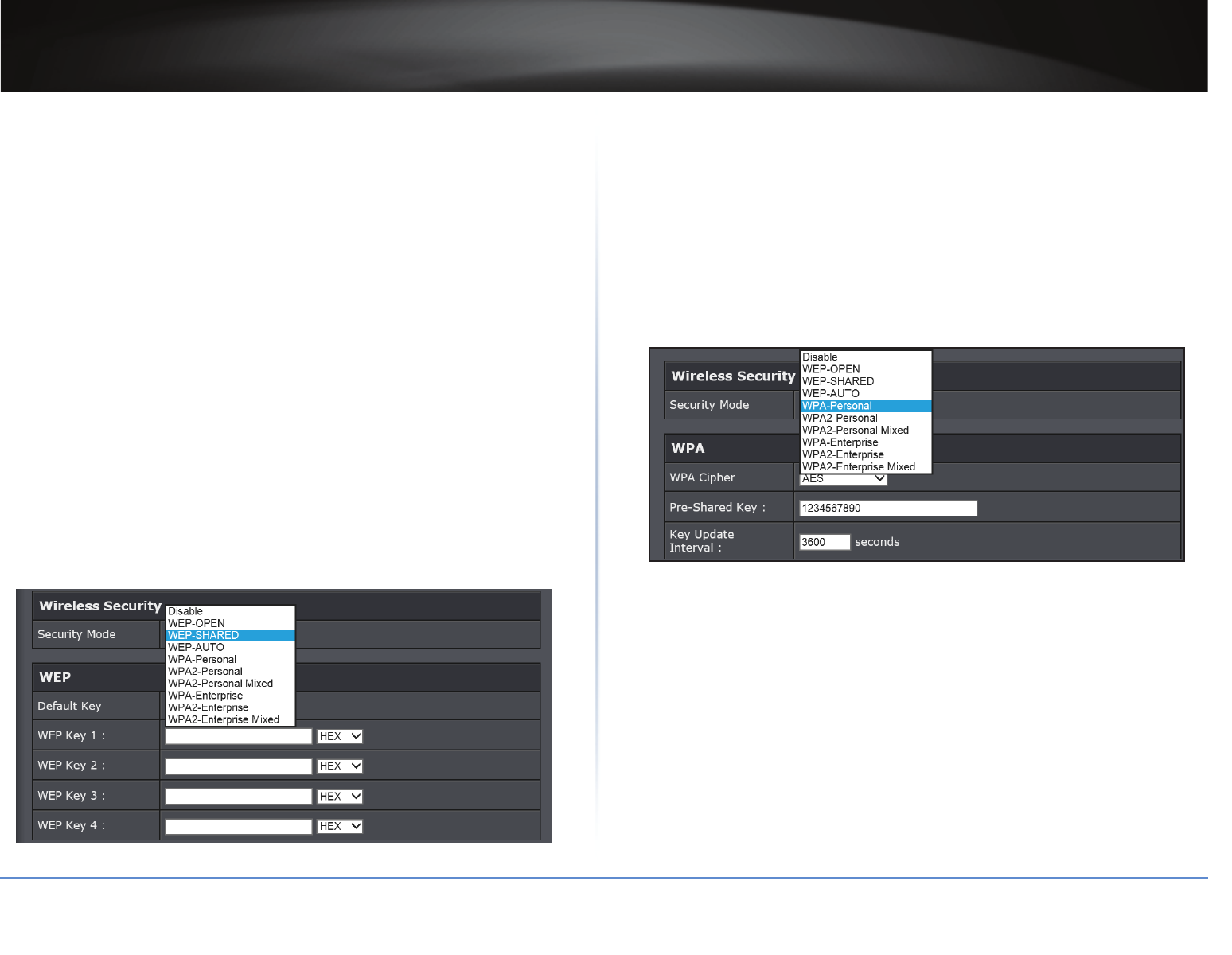
TRENDnet User’s Guide
TEW-821DAP
19
© Copyright 2015 TRENDnet. All Rights Reserved.
Secure your Wireless Network
Wireless 2.4GHz or Wireless 5GHz > Wireless Network
Aer you have determined which security type to use for your wireless network (refer to
“Choose the Security Type for Wireless Network” on page 18), you can set up wireless
security.
ÍNote: By default, your access point is congured with a predened wireless network
name (SSID) and security key using WPA-Personal. The predened wireless network
name and security can be found on the scker on the side of the access point or on the
device label at the boom of the access point.
1 Log into your access point management page (refer to “Log in to Management Page”
on page 10).
2 In Current Prole secon, click Edit next to the wireless prole to select the wireless
security type.
3 In Wireless Security secon, select the preferred Security Mode:
• Select between WPA-OPEN, WPA-SHARED, or WPA-AUTO. WPA-OPEN system
allows any client to authencate as long as it conforms to any MAC address
lter policies that may have been set. All authencaon packets are transmied
without encrypon. WPA-SHARED Key sends an unencrypted challenge text string
to any device aempng to communicate with the AP. The device requesng
authencaon encrypts the challenge text and sends it back to the access point.
If the challenge text is encrypted correctly, the access point allows the requesng
device to authencate. It is recommended to select WPA-AUTO if you are not sure
which authencaon type is used. Click Apply to save the changes.
Default Key: You may choose one of your four dierent WEP keys from below.
WEP Key 1 to 4: Enter the WEP key. This is the password or key that is used
to connect your computer to this access point wirelessly. You can enter four
dierent WEP keys.
HEX / ASCII: Select your key format to be in hexadecimal or ASCII codes. Keys
are dened by entering in a string in HEX (hexadecimal - using characters
0-9, A-F) or ASCII (American Standard Code for Informaon Interchange -
alphanumeric characters) format. ASCII format is provided so you can enter a
string that is easier to remember.
• If the security type is set to WPA-Personal, review the WPA-Personal sengs to
congure and click Apply to save the changes.
Security Mode: Select the WPA security type.
WPA Cipher: Select the encrypon algorithm used to secure the data
communicaon. TKIP (Temporal Key Integrity Protocol) provides per-packet key
generaon and is based on WEP. AES (Advanced Encrypon Standard) is a very
secure block based encrypon. With the “TKIP and AES” opon, the device
negoates the cipher type with the client, and uses AES when available.
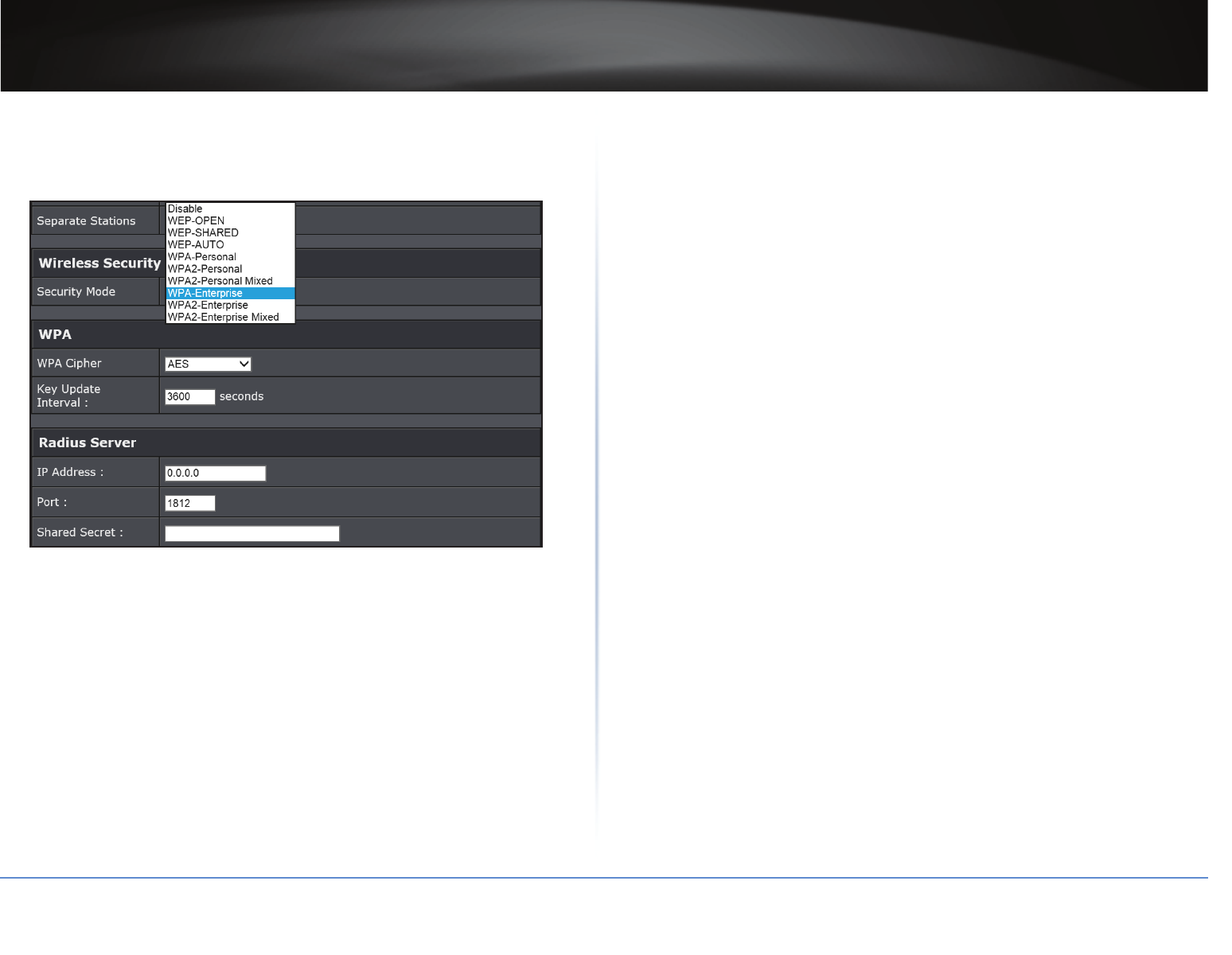
TRENDnet User’s Guide
TEW-821DAP
20
© Copyright 2015 TRENDnet. All Rights Reserved.
• If the security type is set to WPA-Enterprise, review the WPA-Enterprise sengs
to congure and click Apply to save the changes. This security type is also known
as EAP (Extensible Authencaon Protocol) or Remote Authencaon Dial-In User
Service or RADIUS.
ÍNote: This security type requires an external RADIUS server, Shared Secret only
requires you to create a passphrase.
Key Update Interval: Specify how oen the wireless key should be
renegoated. Shorter me intervals are more secure, but cause more
overhead.(Default: 3600 seconds/ 1 hour).
IP Address: Enter the IP address of the RADIUS server. (i.e. 192.168.10.250)
Port: Enter the port your RADIUS server is congured to use for RADIUS
authencaon.
ÍNote: It is recommended to use port 1812 which is typical default RADIUS
port.
Shared Secret: Enter the shared secret used to authorize your access point
with your RADIUS server.
Connect Wireless Devices to your Access Point
A variety of wireless network devices can connect to your wireless network such as:
• Gaming Consoles
• Internet enabled TVs
• Network media players
• Smart Phones
• Wireless Laptop computers
• Wireless IP cameras
Each device may have its own soware ulity for searching and connecng to available
wireless networks, therefore, you must refer to the User’s Manual/Guide of your wireless
client device to determine how to search and connect to this access point’s wireless
network.
Connect Wireless Devices using WPS
WPS (Wi-Fi Protected Setup) is a feature that makes it easy to connect devices to your
wireless network. If your wireless devices support WPS, you can use this feature to easily
add wireless devices to your network.
ÍNote: You will not be able to use WPS if you set the SSID Broadcast seng to Disabled
or if you are using WEP security. Please note that WPS funconality will only be
available when the Device Mode is set to Access Point mode under Main > Device
Mode.
There are two methods the WPS feature can easily connect your wireless devices to your
network.
• Push Buon Conguraon (PBC) method (“PBC (Soware/Virtual Push Buon)” on
page 38).
• PIN (Personal Idencaon Number) method (“PIN (Personal Idencaon Number)”
on page 39).
ÍNote: Refer to your wireless device documentaon for details on the operaon of
WPS.
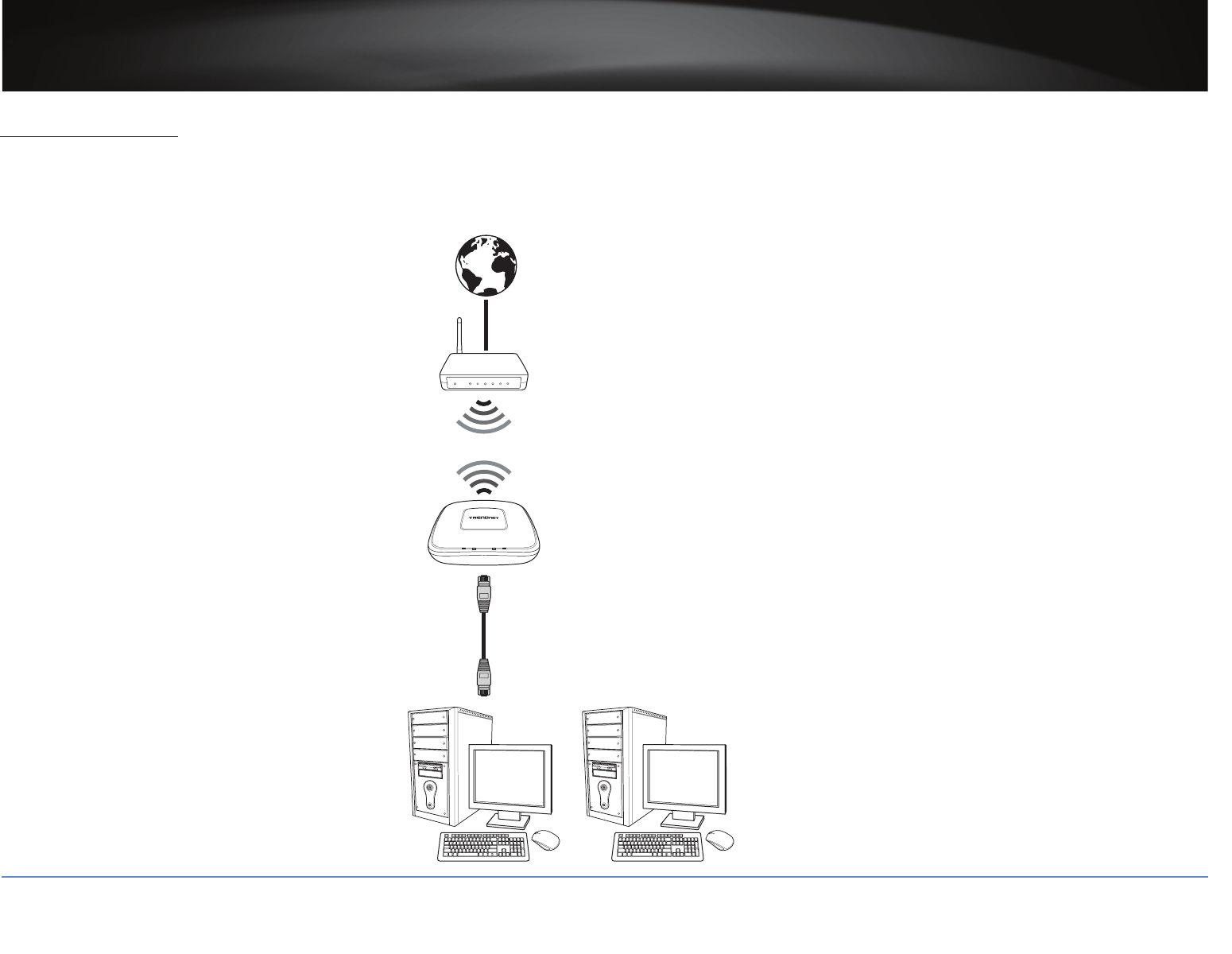
TRENDnet User’s Guide
TEW-821DAP
21
© Copyright 2015 TRENDnet. All Rights Reserved.
Client Bridge Mode
Client Bridge mode allows the device to act as a wireless client device to connect to your wireless network and bridge the wireless connecon from the wireless network to the LAN port
located on the back of the device. Client devices with wired network capability such as in a media or entertainment center (ex. Smart TV, Game Console, DVR, etc.) can connect to the
LAN port using an Ethernet cable to establish wired connecvity to your network. When using this mode, please note that Client Bridge mode can only funcon using one band at a me,
2.4GHz or 5GHz and other modes cannot be used simultaneously.
LAN PWR
5GHz
2.4GHz
• Connects to any 802.11
wireless AP.
• Connects two networks
wirelessly
Client Bridge
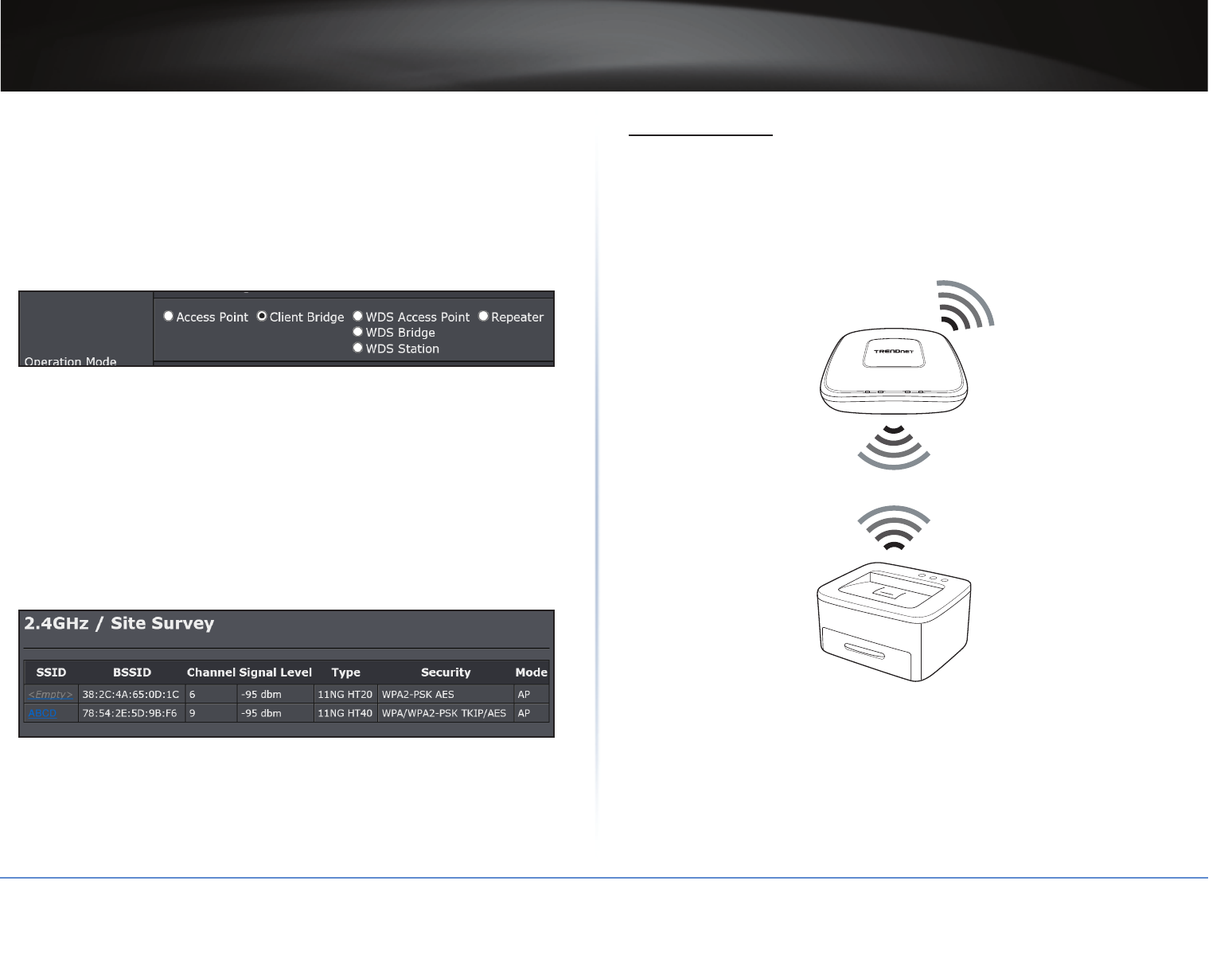
TRENDnet User’s Guide
TEW-821DAP
22
© Copyright 2015 TRENDnet. All Rights Reserved.
Conguring the Device as Client Bridge
System > Operaon Mode
1 Log into your access point management page (refer to “Log in to Management Page”
on page 10).
2 Click System > Operaon Mode.
3 In Operaon Mode secon, select Client Bridge.
ÍNote: In the following example the Client Bridge mode is selected for 2.4GHz wireless
prole.
4 To save changes, click Apply.
ÍNote: To discard the changes, click Cancel.
Using Client Bridge Mode
Wireless 2.4GHz or Wireless 5GHz > Wireless Network
1 Log into your access point management page (refer to “Log in to Management Page”
on page 10).
2 In Wireless 2.4GHz or Wireless 5GHz > Wireless Network > SSID secon, specify the
stac SSID manually or click Wireless 2.4GHz or Wireless 5GHz > Wireless Network >
Site Survey.
3 The available networks are listed. Select a network to connect to.
ÍNote: If you are unable to nd your wireless network in the list, click Refresh to rescan
for the available networks.
4 Click on the SSID eld to connect to the selected wireless network.
5 Click Apply to save the wireless network.
Repeater Mode
When Repeater Mode is selected, the selected wireless interface funcons as a wireless
repeater and is able to repeat the wireless signal of an access point. This feature is used
to expand your exisng wireless network on places your current access point is unable
to reach. Make sure all the sengs on selected interface of the TEW-821DAP matches
the wireless access points you want to repeat in same wireless sengs including SSID,
channel and wireless encrypon sengs.
LAN PWR
5GHz
2.4GHz
Repeater
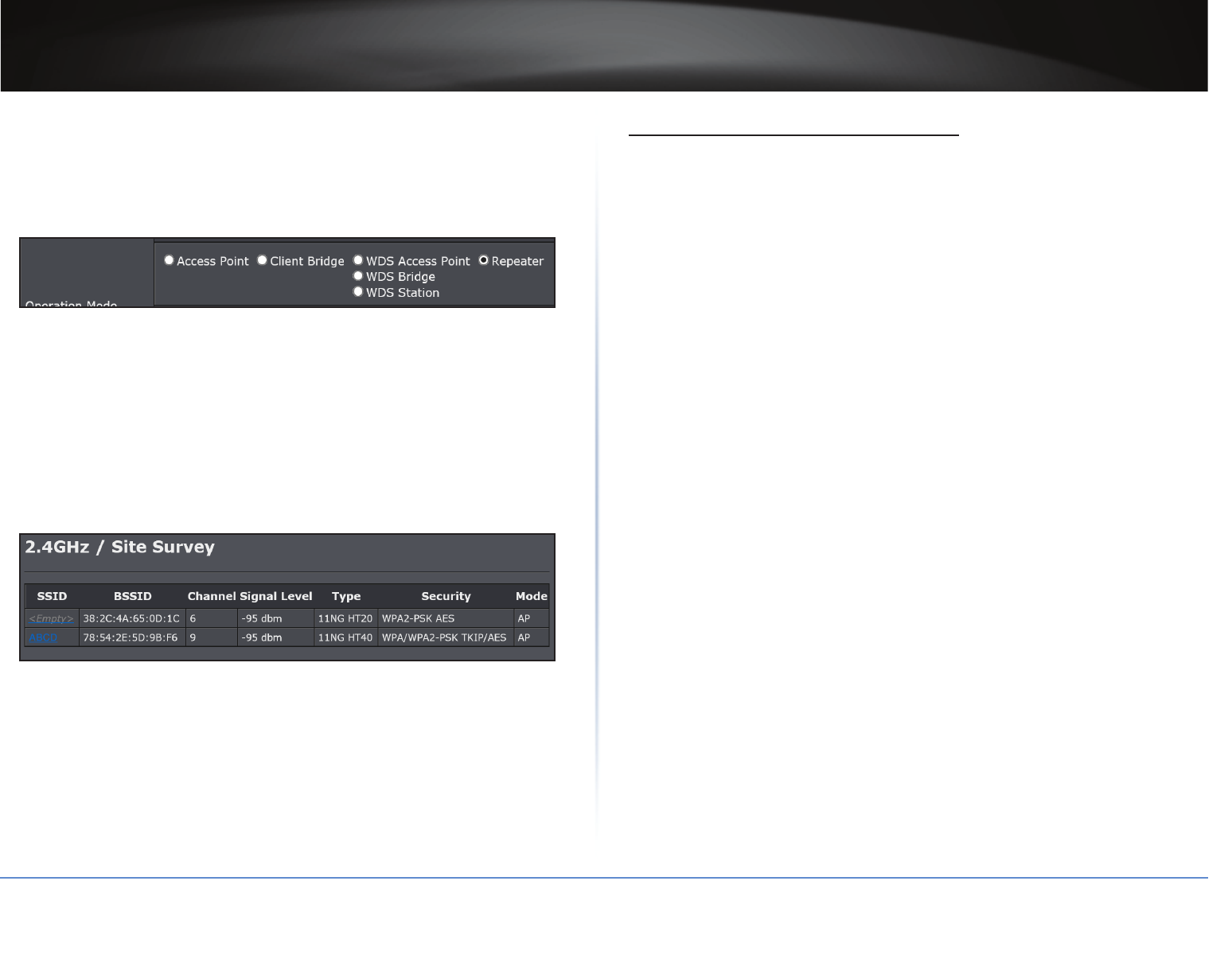
TRENDnet User’s Guide
TEW-821DAP
23
© Copyright 2015 TRENDnet. All Rights Reserved.
Conguring the Device as Repeater
System > Operaon Mode
1 Log into your access point management page (refer to “Log in to Management Page”
on page 10).
2 Click System > Operaon Mode.
3 In Operaon Mode secon, select Repeater.
4 Click Apply to save changes or Cancel to discard the changes.
Using Repeater Mode
Wireless 2.4GHz or Wireless 5GHz > Wireless Network
1 Log into your access point management page (refer to “Log in to Management Page”
on page 10).
2 In Wireless 2.4GHz or Wireless 5GHz > Wireless Network > SSID secon, specify the
stac SSID manually or click Wireless 2.4GHz or Wireless 5GHz > Wireless Network >
Site Survey.
3 The available networks are listed. Select a network to connect to.
ÍNote: If you are unable to nd your wireless network in the list, click Refresh to rescan
for the available networks.
4 Click on the SSID eld to connect to the selected wireless network.
5 Click Apply to save the wireless network.
Wireless Distribuon System (WDS)
IMPORTANT: Deploy ONLY mulple TEW-821DAPs in a single DS (distribuon system).
WDS may not work with other products due to its non-standard nature.
WDS stands for Wireless Distribuon System, a non-standard extension to the IEEE
802.11 standard to allow transparent Ethernet bridging on the staon and to implement
seamingless hand-over for wireless clients roaming between dierent access points.
WDS links create transparent bridges facilitate layer 2 seamless communicaon. You
don’t have to use WDS if you don’t need layer 2 services passing through TEW-821DAP,
such as MAC ltering, and 802.1X authencaon. You can simply use AP, Client Bridge,
and Repeater mode to t most of your network plan.
The 802.11 standard only uses three MAC addresses for frames transmied between the
Access Point and the Staon. Frames transmied from the staon to the AP don’t include
the Ethernet source MAC address of the requesng host and response frames are missing
the desnaon Ethernet MAC to address the target host behind the client bridge.
WDS AP and WDS Staon uses the 4 MAC address including complete source, desnaon,
WDS AP, and WDS Staon addresses. Data frame arriving WDS AP or WDS Staon will be
translated back to 802.3 data frame with real source address instead of WDS AP or WDS
Staon address. The 4 addresses design keeps the original data frame intact bridging to
the other side transparently.
You have to use mulple TEW-821DAPs to build WDS AP - WDS Staon pair or WDS
bridge mesh groups. Dierent model with same or dierent brand name may NOT work
together because of the dierent WDS implementaon details.
WDS Bridge
In this mode, the selected interface wirelessly communicate to other WDS bridges
to make a wireless backbone. You can make a simple mesh network with these WDS
bridges. To build a WDS link, you have to list the neighbor’s BSSID (the MAC address)
as next hop packet forwarding. Your neig, vice versa, has to list your BSSID (the MAC
Address) as its next hop. Make sure all access points are congured with the same SSID as
a single DS (distribuon system), wireless channel and wireless encrypon sengs have
to be the same as well.
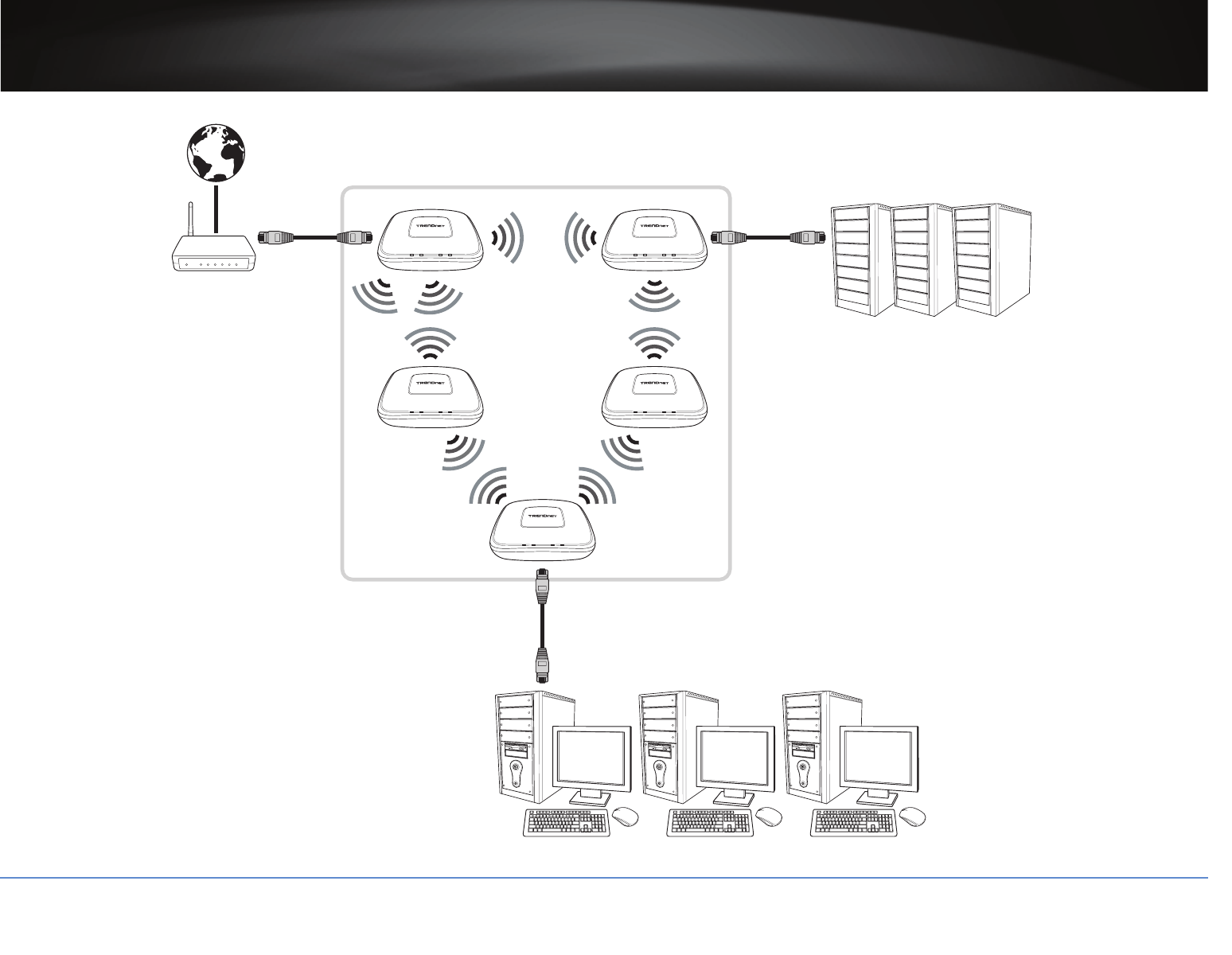
TRENDnet User’s Guide
TEW-821DAP
24
© Copyright 2015 TRENDnet. All Rights Reserved.
LAN PWR
5GHz
2.4GHz LAN PWR
5GHz
2.4GHz
LAN PWR
5GHz
2.4GHz
LAN PWR
5GHz
2.4GHz
LAN PWR
5GHz
2.4GHz
WWW
WDS
Bridge
Wireless Distribuon System
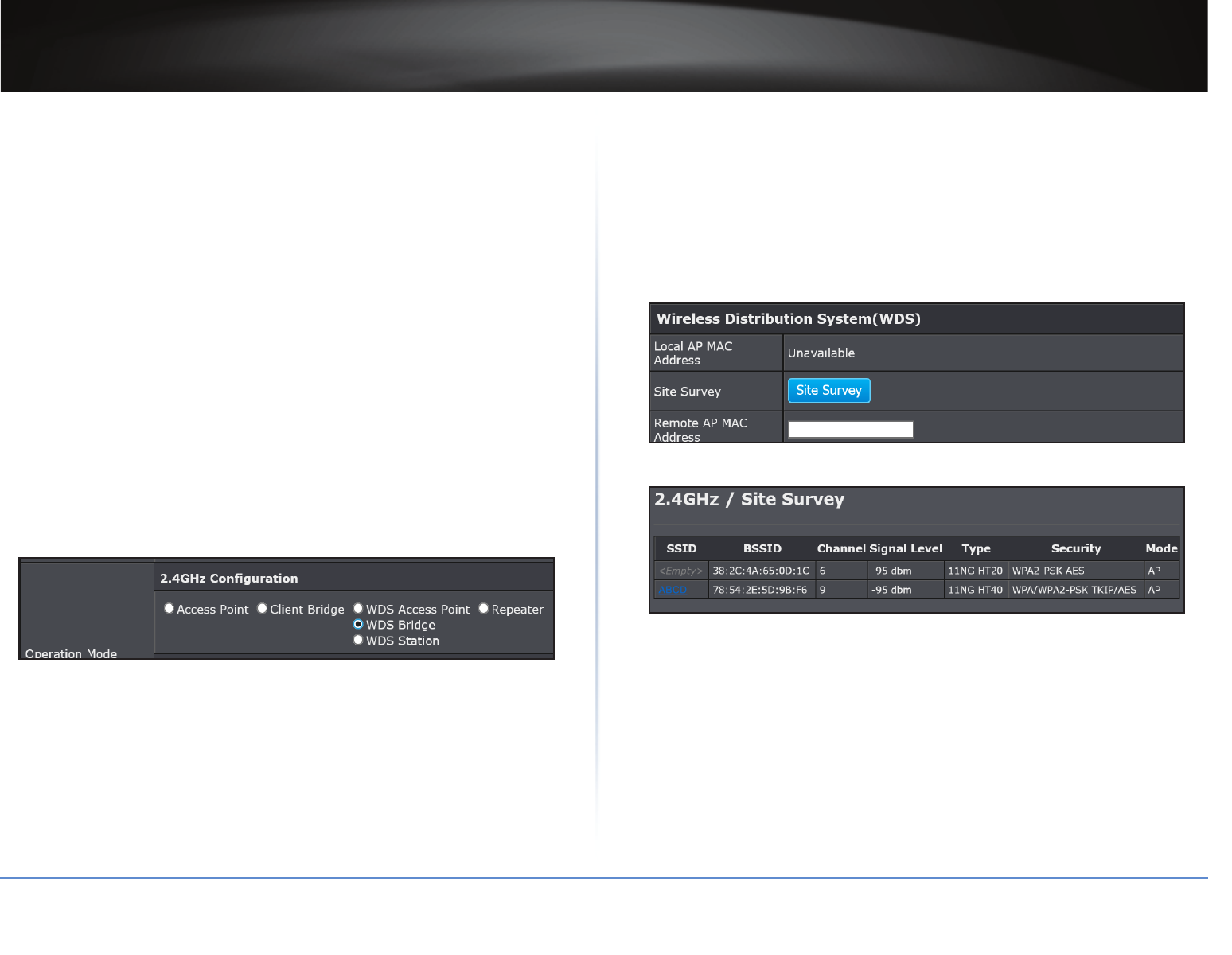
TRENDnet User’s Guide
TEW-821DAP
25
© Copyright 2015 TRENDnet. All Rights Reserved.
Creang a WDS Bridge
System > Operaon Mode
ÍNote: By default, your access point is congured with a predened wireless network
name (SSID) and security key using WPA-Personal. The predened wireless network
name and security can be found on the scker on the side of the access point or on the
device label at the boom of the access point.
To congure a WDS bridge between two TEW-821DAP access points:
• Make note of the wireless MAC address of both access points. Refer to “System
Informaon” on page 28 for checking the status page.
ÍNote: Please note that 2.4GHz and 5GHz bands will have two dierent MAC
addresses. If using the 2.4GHz band wireless MAC address, please use the 2.4GHz
wireless MAC address for all other WDS supported devices to bridge and if using the
5GHz band wireless MAC address, use the 5GHz wireless MAC address for all other
WDS supported devices to bridge.
• Make sure the IP address on each WDS supported access is point is dierent and on
the same IP network/subnet. Please refer to “Congure IP Sengs” on page 30 for
changing access point IP address.
1 Log into your access point management page (refer to “Log in to Management Page”
on page 10).
2 Click System > Operaon Mode.
3 On Operaon Mode secon, select WDS Bridge.
4 Click Apply to save changes or Cancel to discard the changes.
Using a WDS Bridge
Wireless 2.4GHz or Wireless 5GHz > WDS Link Sengs
1 Log into your access point management page (refer to “Log in to Management Page”
on page 10).
2 In Wireless 2.4GHz or Wireless 5GHz > Wireless Link Sengs > Remote AP MAC
Address secon, do on of the following:
• Specify the remote AP MAC address manually, and click Apply or
• Click Wireless 2.4GHz or Wireless 5GHz > Wireless Link Sengs > Site Survey.
3 The available networks are listed. Select a network to connect to.
ÍNote: If you are unable to nd your wireless network in the list, click Refresh to rescan
for the available networks.
4 Click on the SSID eld to connect to the selected wireless network.
5 Click Apply to save the wireless network.
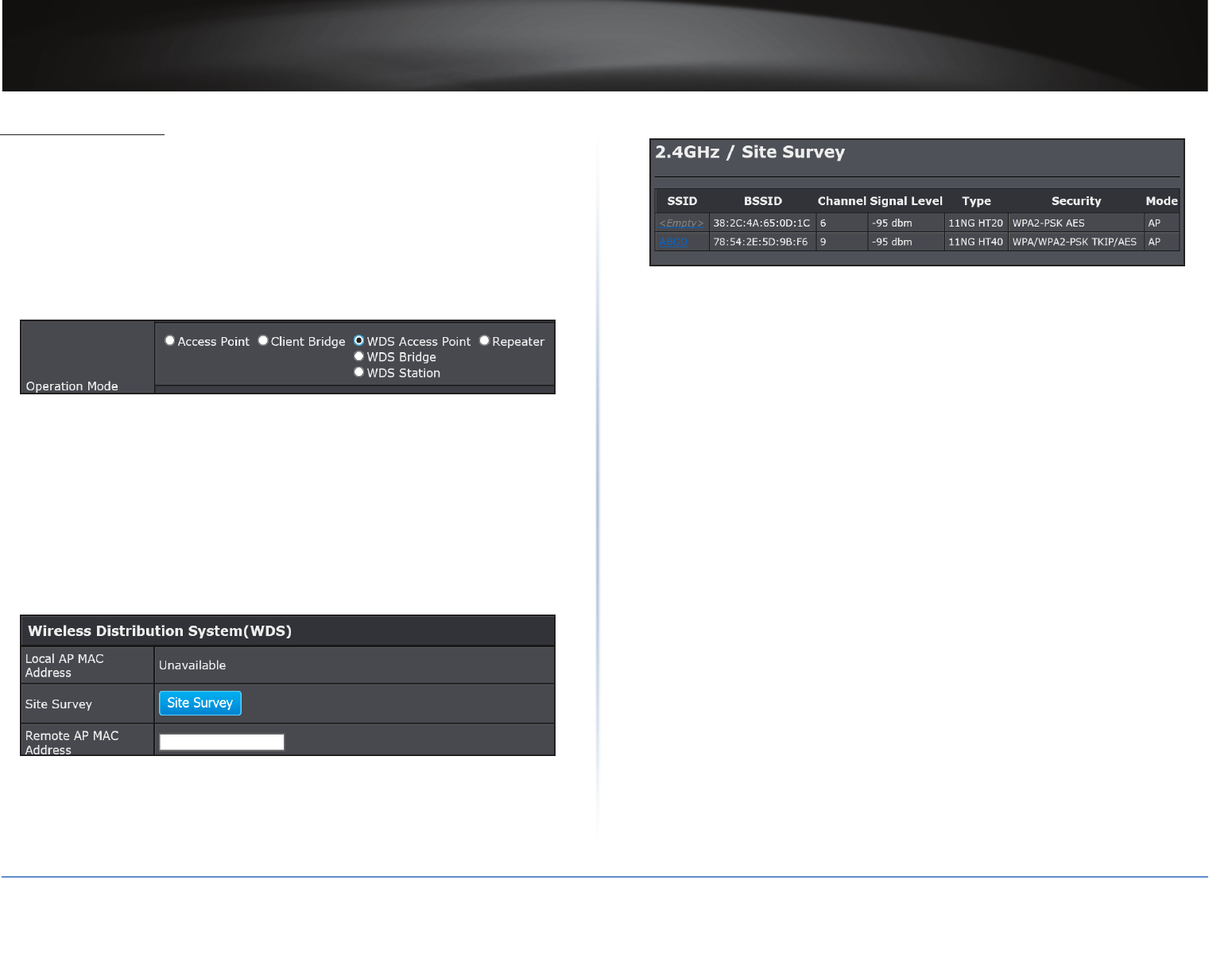
TRENDnet User’s Guide
TEW-821DAP
26
© Copyright 2015 TRENDnet. All Rights Reserved.
WDS Access Point
WDS AP is an outlet of a DS. Pairing with a WDS Staon you can build a transparent
bridge between two DS or from DS to STA.
Creang a WDS Access Point
System > Operaon Mode
1 Log into your access point management page (refer to “Log in to Management Page”
on page 10).
2 Click System > Operaon Mode.
3 On Operaon Mode secon, select WDS Access Point.
4 Click Apply to save changes or Cancel to discard the changes.
Using a WDS Bridge
Wireless 2.4GHz or Wireless 5GHz > WDS Link Sengs
1 Log into your access point management page (refer to “Log in to Management Page”
on page 10).
2 In Wireless 2.4GHz or Wireless 5GHz > Wireless Link Sengs > Remote AP MAC
Address secon, do one of the following:
• Specify the remote AP MAC address manually and click Apply or
• Click Wireless 2.4GHz or Wireless 5GHz > Wireless Link Sengs > Site Survey.
3 The available networks are listed. Select a network to connect to.
ÍNote: If you are unable to nd your wireless network in the list, click Refresh to rescan
for the available networks.
4 Click on the SSID eld to connect to the selected wireless network.
5 Click Apply to save the wireless network.
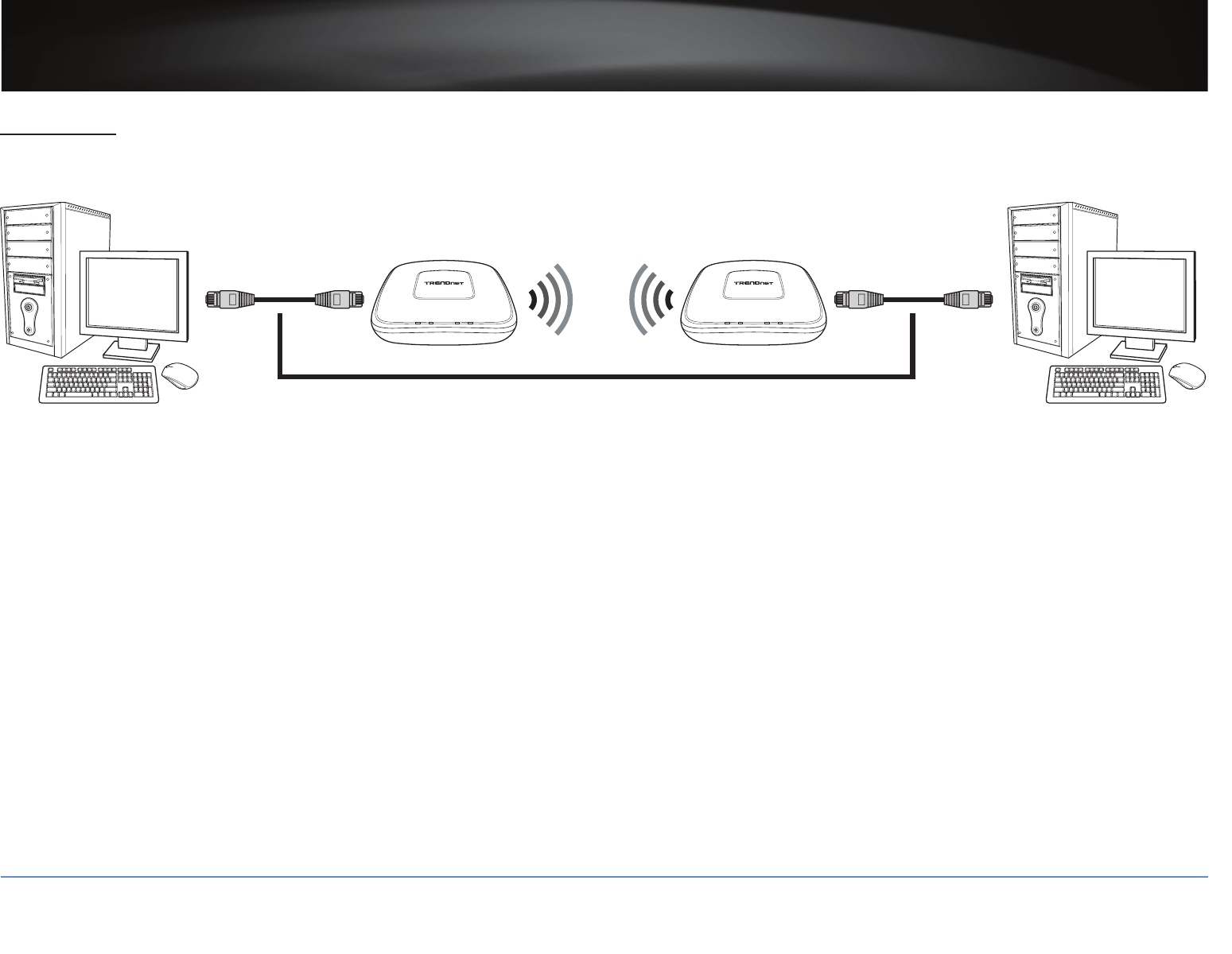
TRENDnet User’s Guide
TEW-821DAP
27
© Copyright 2015 TRENDnet. All Rights Reserved.
WDS Staon
Pair with WDS AP, you can build a transparent bridge for layer 2 requirements.
LAN PWR
5GHz
2.4GHz LAN PWR
5GHz
2.4GHz
WDS AP WDS Staon
Transparent Bridge
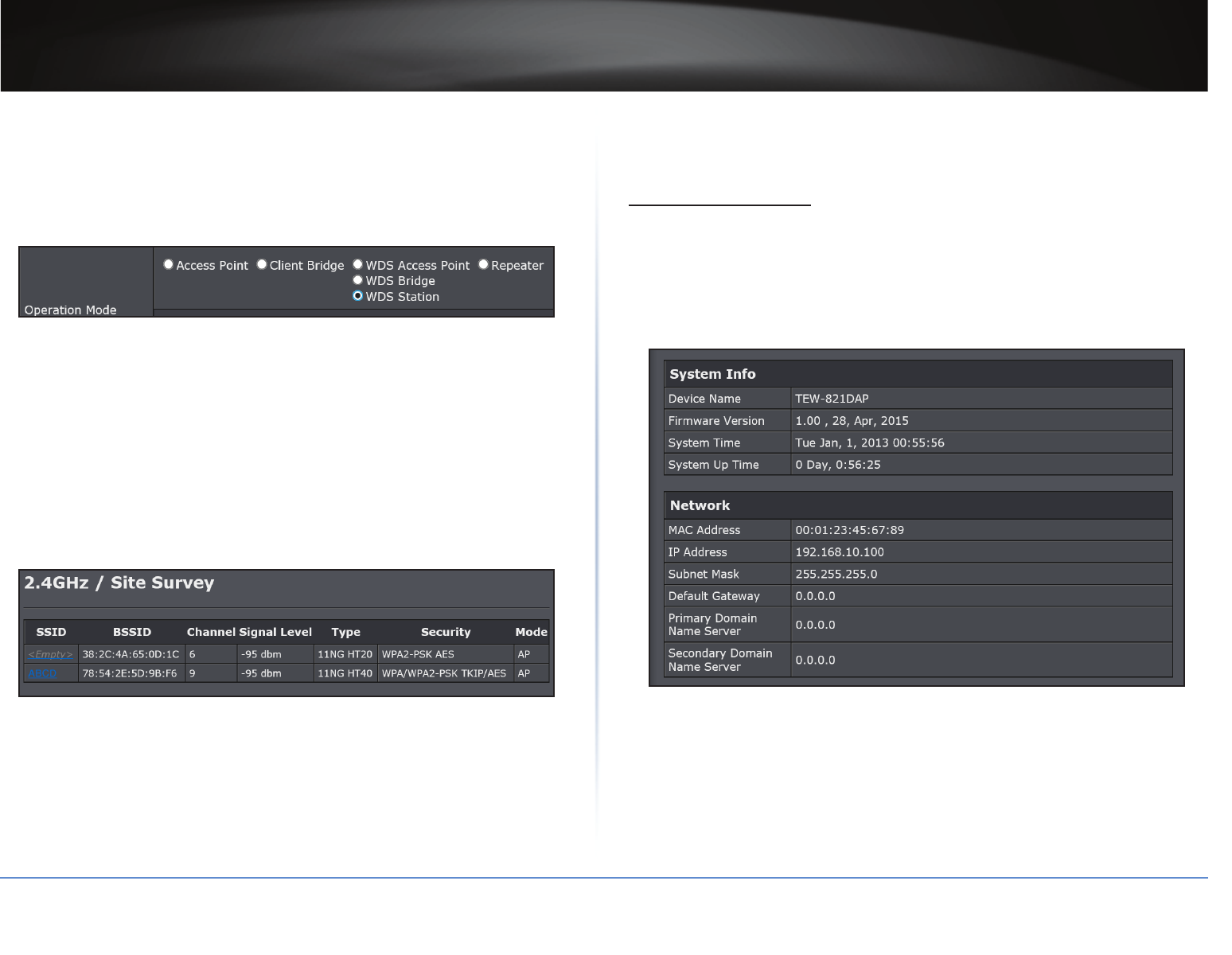
TRENDnet User’s Guide
TEW-821DAP
28
© Copyright 2015 TRENDnet. All Rights Reserved.
Creang a WDS Staon
System > Operaon Mode
1 Log into your access point management page (refer to “Log in to Management Page”
on page 10).
2 Click System > Operaon Mode.
3 On Operaon Mode secon, select WDS staon.
4 Click Apply to save changes or Cancel to discard the changes.
Using a WDS Staon
Wireless 2.4GHz or Wireless 5GHz > Wireless Network
1 Log into your access point management page (refer to “Log in to Management Page”
on page 10).
2 In Wireless 2.4GHz or Wireless 5GHz > Wireless Network > SSID secon, do one of the
following:
• Specify the stac SSID manually and click Apply or
• Click Wireless 2.4GHz or Wireless 5GHz > Wireless Network > Site Survey.
3 The available networks are listed. Select a network to connect to.
ÍNote: If you are unable to nd your wireless network in the list, click Refresh to rescan
for the available networks.
4 Click on the SSID eld to connect to the selected wireless network.
5 Click Apply to save the wireless network.
View System Status
System Informaon
Status > Main
View the device informaon, and LAN and Wireless LAN conguraon.
1 Log into your access point management page (refer to “Log in to Management Page” on
page 10).
2 Click Status > Main.
• In the System Info secon:
Device Name: Display name of this device that is recognized by other network
devices such as SNMP.
Firmware Version: Display currently run rmware version.
System Time: Display the current me is important for schedule control and
log accuracy.
System Up Time: Display how long the system has been running without
reboot.
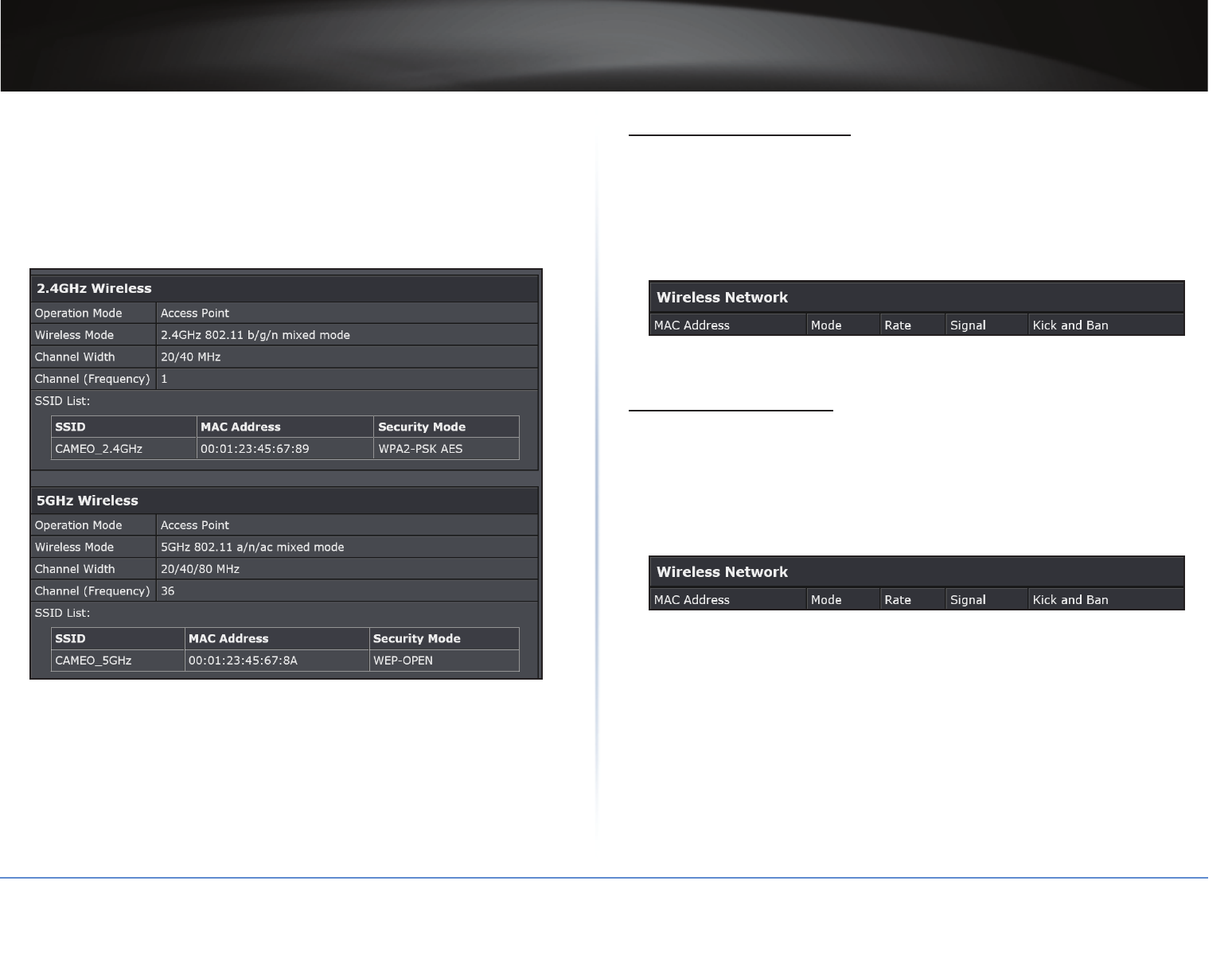
TRENDnet User’s Guide
TEW-821DAP
29
© Copyright 2015 TRENDnet. All Rights Reserved.
• In the Network secon:
MAC Address: Display the MAC address of the access point.
IP Address: Display address of the TEW-821DAP.
Subnet Mask: Display network range of IP address.
Default Gateway: Display the default route going further from TEW-821DAP subnet.
Primary Domain Name Server: Display primary domain server address.
Secondary Domain Name Server: Display secondary domain server address.
• On the 2.4GHz / 5GHz Wireless secon:
Operaon Mode: Display which wireless mode the 2.4GHz / 5GHz interface is
set to.
Wireless Mode: Display which 802.11 wireless mode is set and running on the
2.4GHz / 5GHz interface.
Channel Width: Wireless Channel Bandwidth.
Channel (Frequency): Display which 2.4GHz / 5GHz wireless channel (and
frequency) is in use.
SSID List: Display informaon on SSID, MAC address, and security mode.
2.4G Wireless Client List
Status > 2.4G Wireless Client List
To view all wireless clients connected to the 2.4GHz interface, do the following:
1 Log into your access point management page (refer to “Log in to Management Page”
on page 10).
2 Click Status > 2.4G Wireless Client List.
The list of connected wireless clients is displayed on the screen.
3 Click Kick and Ban to send this client to MAC address lter list.
5G Wireless Client List
Status > 5G Wireless Client List
To view all wireless clients connected to the 5GHz interface, do the following:
1 Log into your access point management page (refer to “Log in to Management Page”
on page 10).
2 Click Status > 5G Wireless Client List.
The list of connected wireless clients is displayed on the screen.
3 Click Kick and Ban to send this client to MAC address lter list.
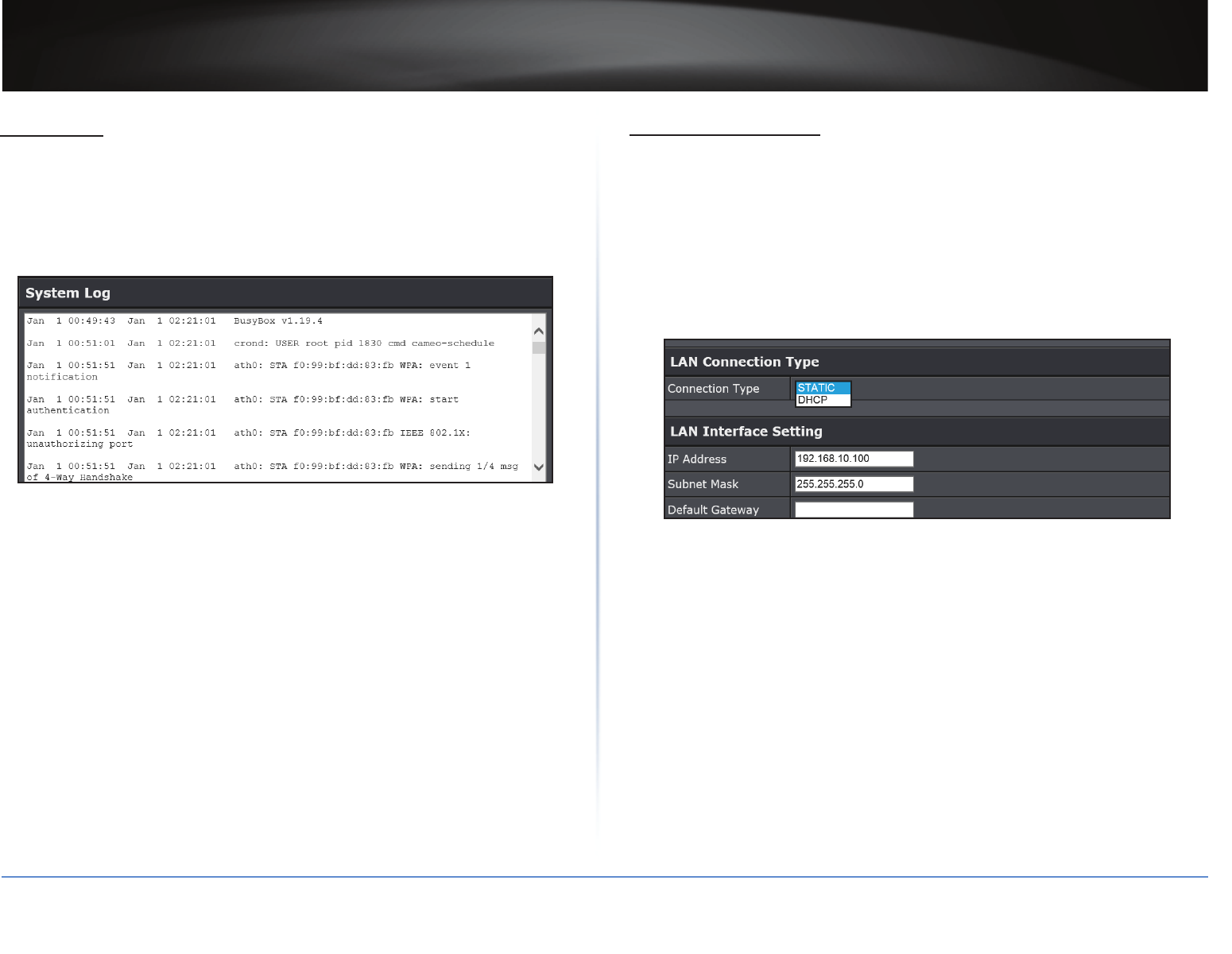
TRENDnet User’s Guide
TEW-821DAP
30
© Copyright 2015 TRENDnet. All Rights Reserved.
System Log
Status > System Log
To view a running log of the access point’s system stascs, events and acvies, do the
following:
1 Log into your access point management page (refer to “Log in to Management Page”
on page 10).
2 Click Status > System Log.
Congure IP Sengs
Status > IP Sengs
The TEW-821DAP has a stac IP (192.168.10.100) set for management purposes. You
can change this IP address to t your network plan or manage mulple TRENDnet access
points. You can also set the TEW-821DAP to DHCP client to accept an IP dynamically.
ÍNote: You can change the IP sengs also using the System > Wizard menu.
To start changing the IP sengs, do the following:
1 Log into your access point management page (refer to “Log in to Management Page”
on page 10).
2 Click System > IP Sengs.
3 Modify the following LAN Connecon Type eld:
• Connecon Type: Choose one of the following:
Stac to manually congure the IP address sengs of the access point.
DHCP to set the access point to automacally obtain IP address sengs from a
DHCP server.
4 Modify any of the following LAN Interface Seng elds:
• IP Address: Specify an IP address.
• Subnet Mask: Specify a subnet mask for the IP address.
• Default Gateway: Default route for the TEW-821DAP.
5 Click Apply to save the LAN sengs or Cancel to discard the changes.
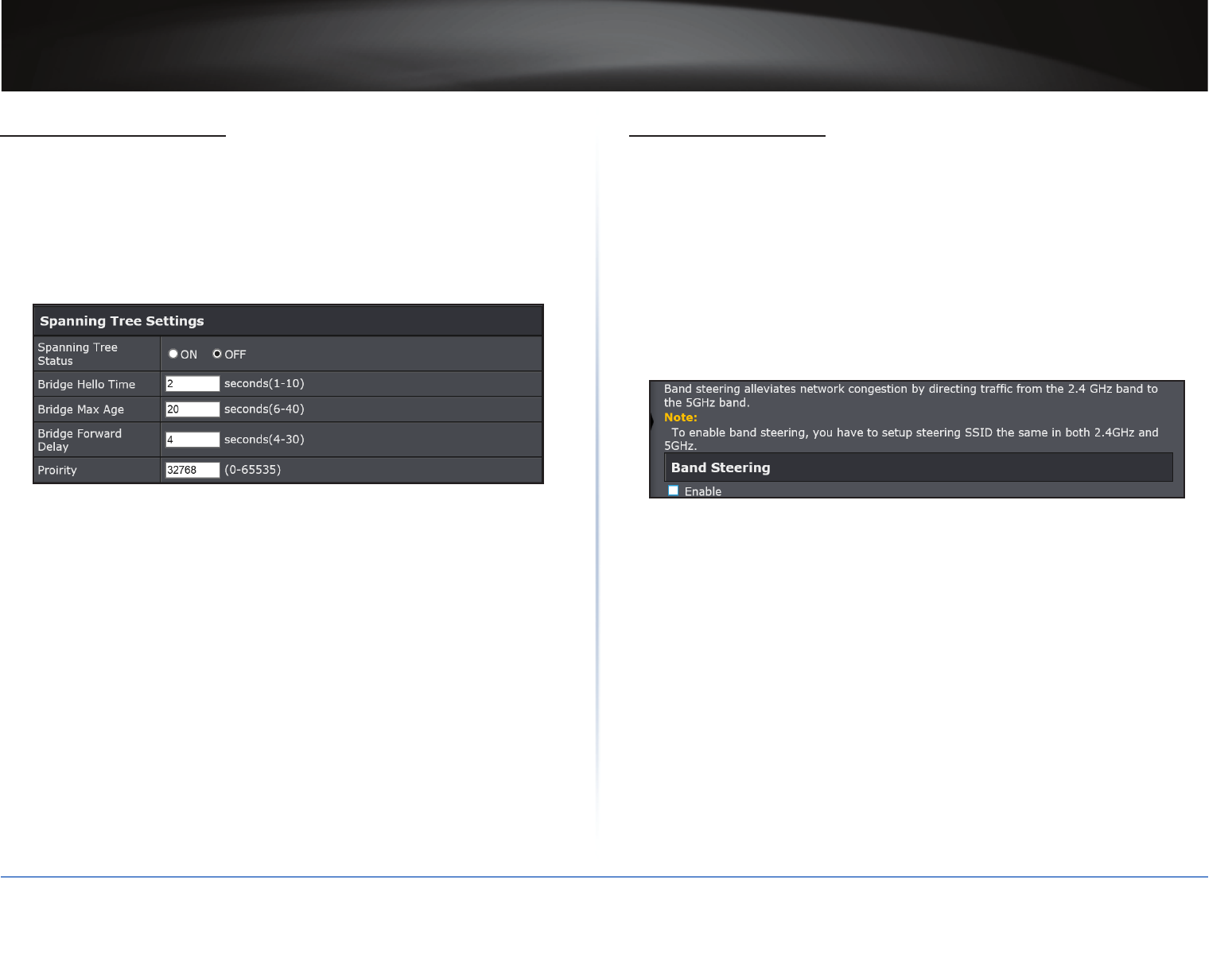
TRENDnet User’s Guide
TEW-821DAP
31
© Copyright 2015 TRENDnet. All Rights Reserved.
Congure Spanning Tree
System > Spanning Tree Sengs
The TEW-821DAP is designed for end point access as well as backbone connecon. To
avoid network looping, you can enable 802.1d spanning tree protocol.
To congure the spanning tree, do the following:
1 Log into your access point management page (refer to “Log in to Management Page”
on page 10).
2 Click System > Spanning Tree Sengs.
3 Modify any of the following Spanning Tree Sengs elds:
• Spanning Tree Status: Enable or disable 802.1d spanning tree protocol to avoid
network looping.
• Bridge Hello Time: The me between each bridge protocol data unit (BPDU).
Default: 2 sec.
• Bridge Max Age: Maximum me a BPDU kept in bridge. Default: 20 sec.
• Bridge Forward Delay: The me to be spent in listen and learning state. Default: 4
sec.
• Priority: Priority number for root bridge selecon. (MAC number is listed on
Status > Main menu).
4 Click Apply to save the spanning tree sengs or Cancel to discard the changes.
Enable Band Steering
System > Band Steer
In the oce, the 2.4GHz is always crowded than 5GHz. There are fewer non-overlapping
channels and more legacy devices in 2.4GHz compare to the 5GHz band. The TEW-
753DAP is equipped with 2.4GHz and 5GHz wireless interfaces. When your client device
can work on both 2.4GHz and 5GHz wireless, Band Steer will choose 5GHz as primary
band over 2.4GHz. Trac will mainly stays on 5GHz in stead of 2.4GHz. To setup band
steer, you have to setup the same SSIDs on both the 2.4GHz and the 5GHz interfaces.
To enable Band Steering, do the following:
1 Log into your access point management page (refer to “Log in to Management Page”
on page 10).
2 Click System > Band Steer.
3 Check Enable opon to allow band steering.
4 Click Save to save the seng or Cancel to discard the changes.
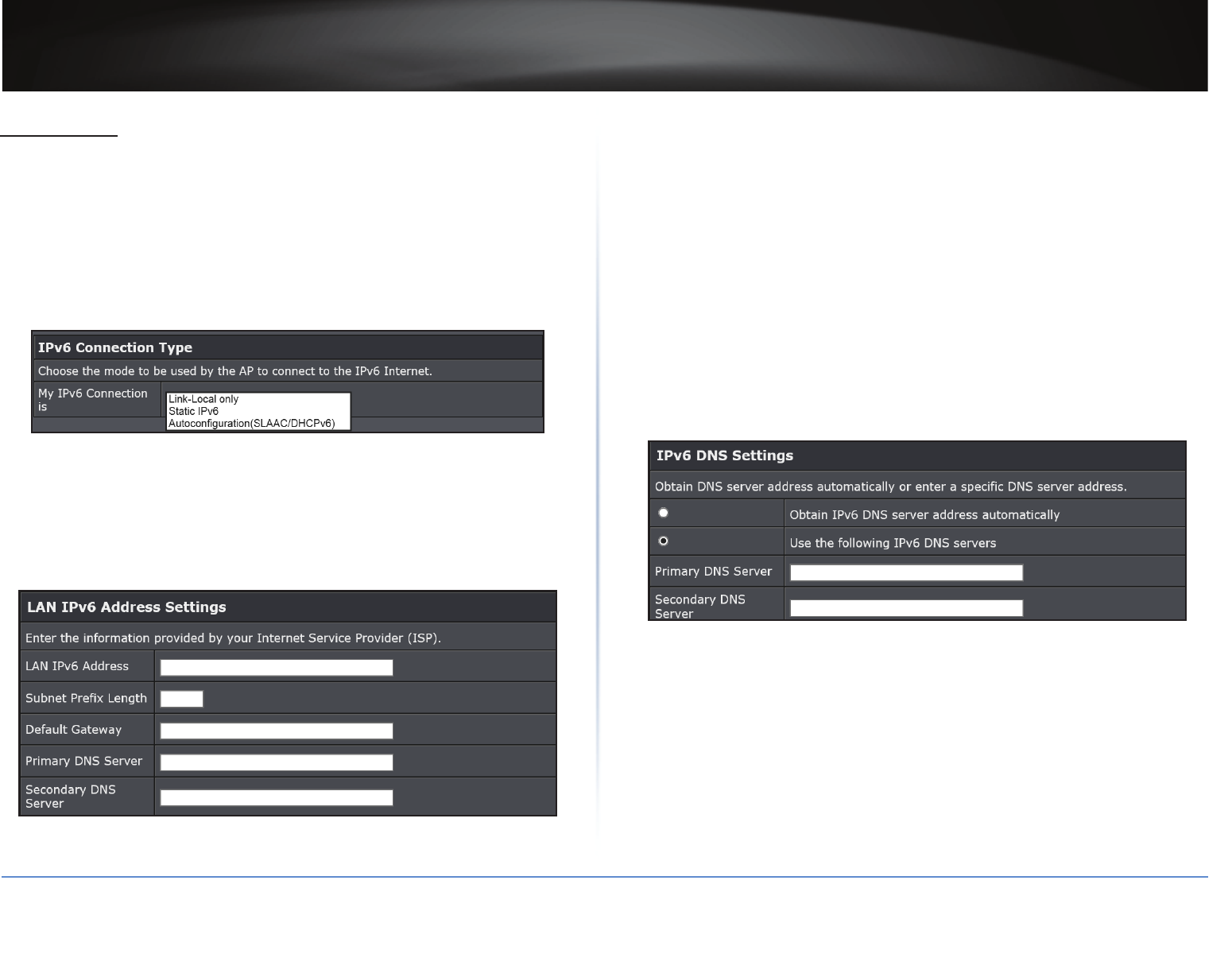
TRENDnet User’s Guide
TEW-821DAP
32
© Copyright 2015 TRENDnet. All Rights Reserved.
IPv6 Sengs
System > IPv6 Sengs
Use this secon if you are connecng this device to an IPv6 network and require this
device to use IPv6 addressing. IPv6 is a updated IP addressing protocol which oers
advanced capabilies and improvements over the more commonly used IP address
standard (IPv4).
1 Log into your access point management page (refer to “Log in to Management Page”
on page 10).
2 Click System > IPv6 Sengs.
3 Select the mode to be used by the access point to connect to an IPv6 network.
• Link-Local Only: The link-local address is used to communicate to neighboring IPv6
capable network devices that are connected to the same network segment. This is
similar to the funcon automac network IP addressing (APIPA) if a device cannot
pull IPv4 address sengs automacally from a network DHCP server.
• Stac IPv6: Use this opon to manually congure the IPv6 address sengs of the
device for connecvity to your IPv6 network.
Congure the following sengs:
LAN IPv6 Address: Enter the stac IPv6 address to assign to your device (i.e.
1234:5678:90ab:cdef::a or 1234:5678:90ab:cdef:0000:0000:0000:000a).
Subnet Prex Length: Enter the IPv6 subnet prex length(1-128, 64 is typically
the standard prex).
Default Gateway: Enter the IPv6 default gateway address (i.e.
1234:5678:90ab:cdef::1 or 1234:5678:90ab:cdef:0000:0000:0000:0001).
Primary DNS Server: Enter the primary IPv6 DNS server address (i.e.
1234:5678:90ab:cdef::1 or 1234:5678:90ab:cdef:0000:0000:0000:0001,
2001:4860:4860::8888 2001:4860:4860::8844).
Secondary DNS Server: Enter the secondary IPv6 DNS server address (i.e.
1234:5678:90ab:cdef::1 or 1234:5678:90ab:cdef:0000:0000:0000:0001,
2001:4860:4860::8888 2001:4860:4860::8844).
• Autoconguraon (SLAAC)/DHCPv6): Use this opon to congure the device to
obtain IPv6 address sengs automacally from a DHCPv6 server on your network.
Congure the following sengs:
Obtain IPv6 DNS server address automacally: Select this opon to congure
the device to obtain the IPv6 DNS server addresses automacally from the
DHCPv6 server on your network.
Use the following IPv6 DNS Servers: Select this opon to manually congure
which IPv6 DNS server addresses the device will use.
4 Click Apply to save changes or Cancel to discard the changes.
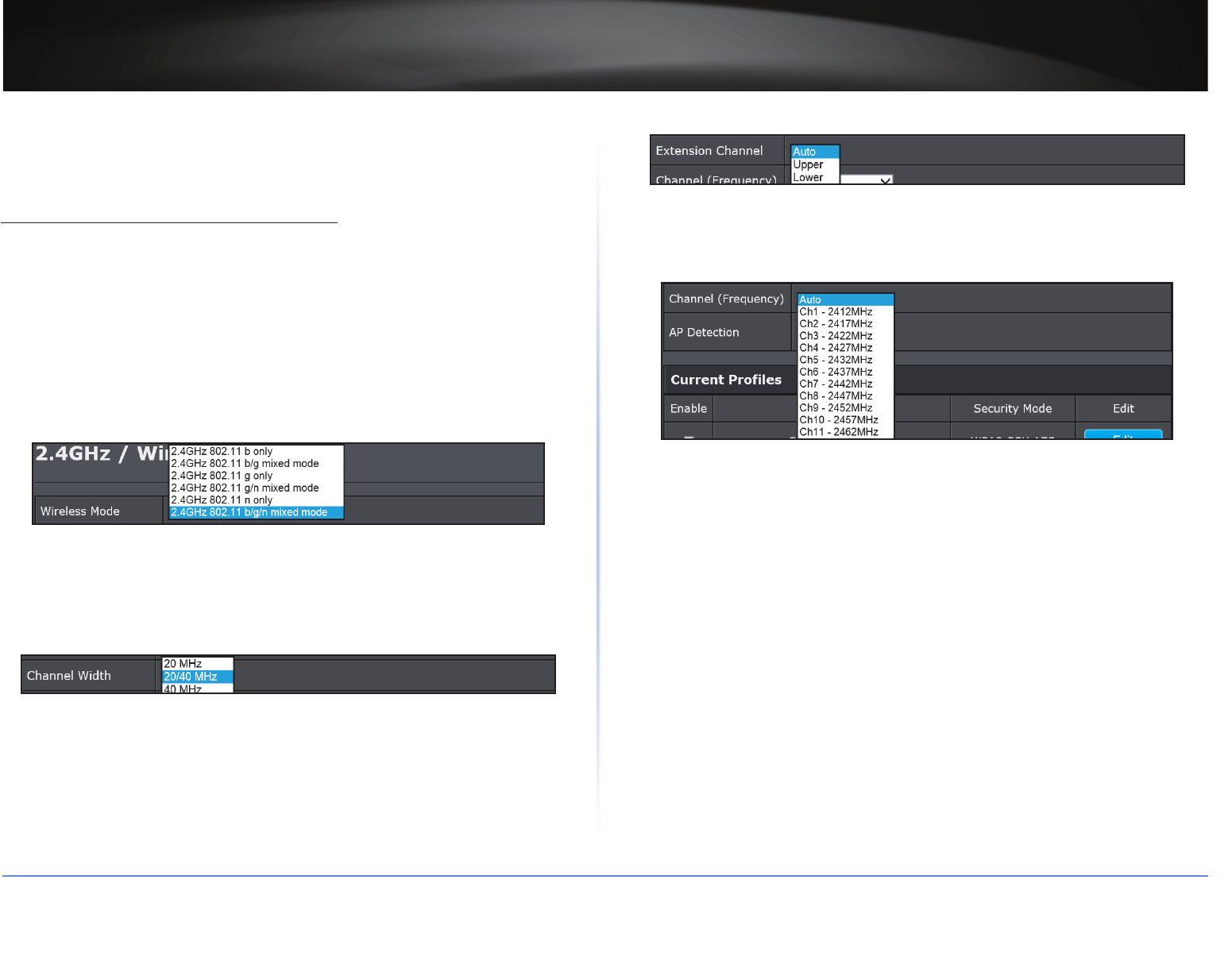
TRENDnet User’s Guide
TEW-821DAP
33
© Copyright 2015 TRENDnet. All Rights Reserved.
Advanced System Conguraon
This secon will guide you through conguring several advanced sengs.
Congure Wireless Network Sengs
Basic Network Sengs
Wireless 2.4GHz > Wireless Network
General setups opons for your 2.4GHz wireless connecon. You can setup up to eight
SSIDs for dierent groups of users.
To congure the basic network sengs, do the following:
1 Log into your access point management page (refer to “Log in to Management Page”
on page 10).
2 Click Wireless 2.4GHz > Wireless Network.
3 Select the network mode.
ÍNote: Choose between N only, G only, B only, B/G mixed, G/N mixed, or B/G/N mixed
mode. The rule of the thumb is to choose single mode if your devices all work in the
same mode. Mixed mode increases compability, but somemes lowers the data
speed.
4 Select the channel width.
ÍNote: The latest 802.11 protocol can combine channels for beer wireless
performance. You can choose xed 20MHz or 40MHz, or automacally select 20MHz or
40MHz channels.
5 Select the extension channel.
ÍNote: When you choose manual channel selecon and 20/40MHz or 40MHz in
channel HT mode, you can choose which neighbor channel you want to combine,
upper channel or lower channel.
6 Select the channel frequency.
ÍNote: If you want to setup xed channel, choose a channel number to switch your
radio frequency. Otherwise, check auto to select the channel automacally which
is selected by default. (When you choose 20/40MHZ or 40MHz channel HT mode,
the channel selecon list is shorter. Four marginal channels are reserved for channel
expansion.)
7 Click Apply to save the changes or Cancel to discard the changes.
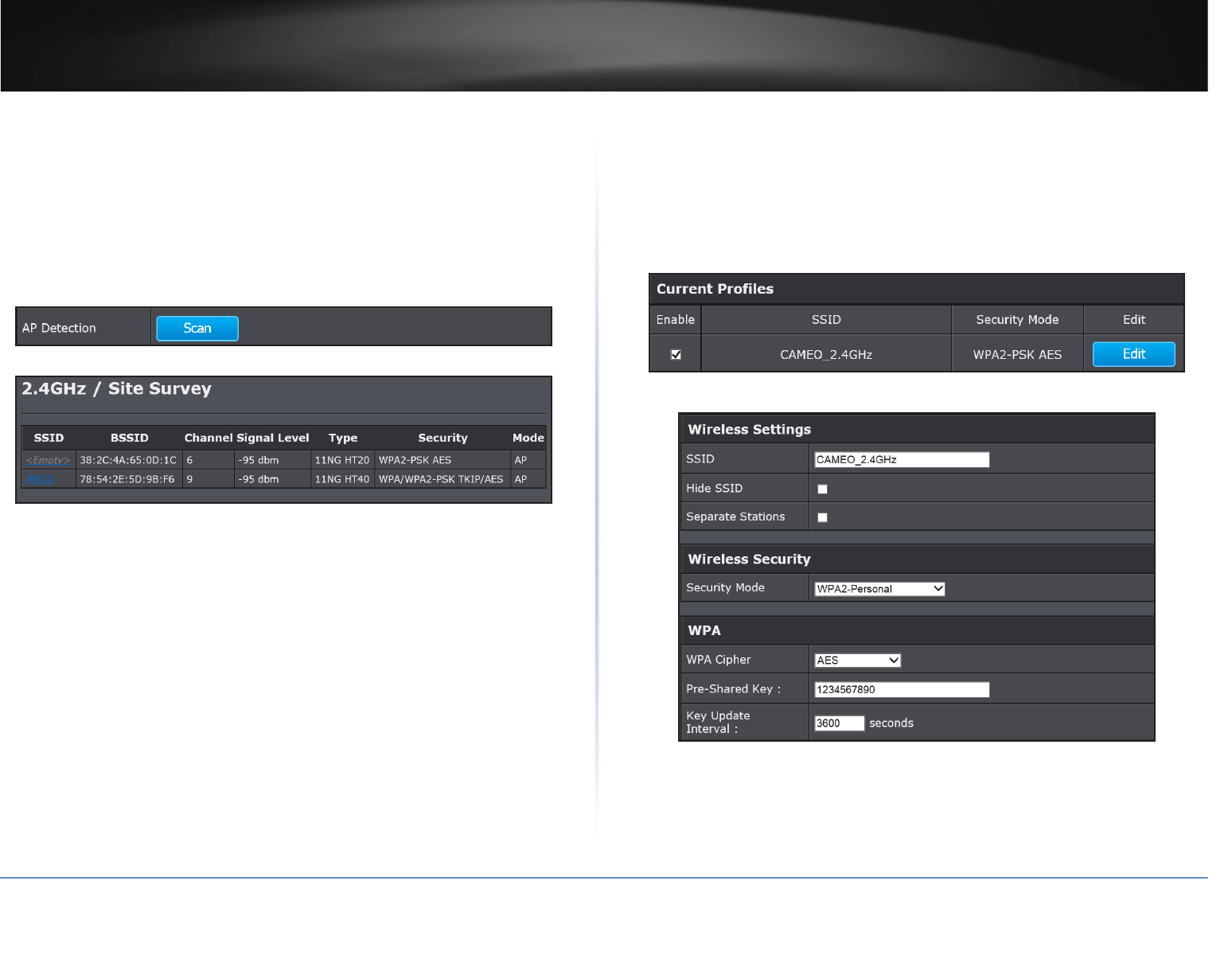
TRENDnet User’s Guide
TEW-821DAP
34
© Copyright 2015 TRENDnet. All Rights Reserved.
AP Detecon
Wireless 2.4GHz > Wireless Network
Before you setup your TEW-821DAP wireless sengs, you may want to know what signal
are currently broadcasng.
To view the site survey and list the running access points around you, do the following:
1 Log into your access point management page (refer to “Log in to Management Page”
on page 10).
2 Click Wireless 2.4GHz > Wireless Network.
3 Click Scan next to the AP Detecon eld.
The site survey page opens.
In site survey you can see the following informaon:
• SSID: Service Set Idener. This SSID is human readable and performs as ESSID to
setup wireless groups.
• BSSID: Basic SSID. This is strictly unique SSID to idenfy a wireless access point,
WAP. It is also the MAC address of the wireless interface.
• Channel: 2.4GHz wireless channel number.
• Signal Level: The signal strength from the access point.
• Type: The 802.11 wireless mode this access point provides.
• Security: Which wireless security was set to use.
• Mode: This wireless source works on infrastructure mode or ad hoc mode.
4 Click Refresh to renew the informaon.
SSID Sengs
Wireless 2.4GHz > Wireless Network
To congure the SSID sengs, do the following:
1 Log into your access point management page (refer to “Log in to Management Page”
on page 10).
2 Click Wireless 2.4GHz > Wireless Network.
3 Select the prole from Current Prole secon and click Edit next to the prole.
The SSID prole page opens.
4 Modify the following parameters:
• SSID: Select the human readable SSID to be easily idened. You can choose any
combinaon with 1 to 32 leers .
• Hide SSID: Check this box to hide SSID broadcasng. Your wireless network name
is broadcast to anyone within wireless signal range. When this is box is checked,
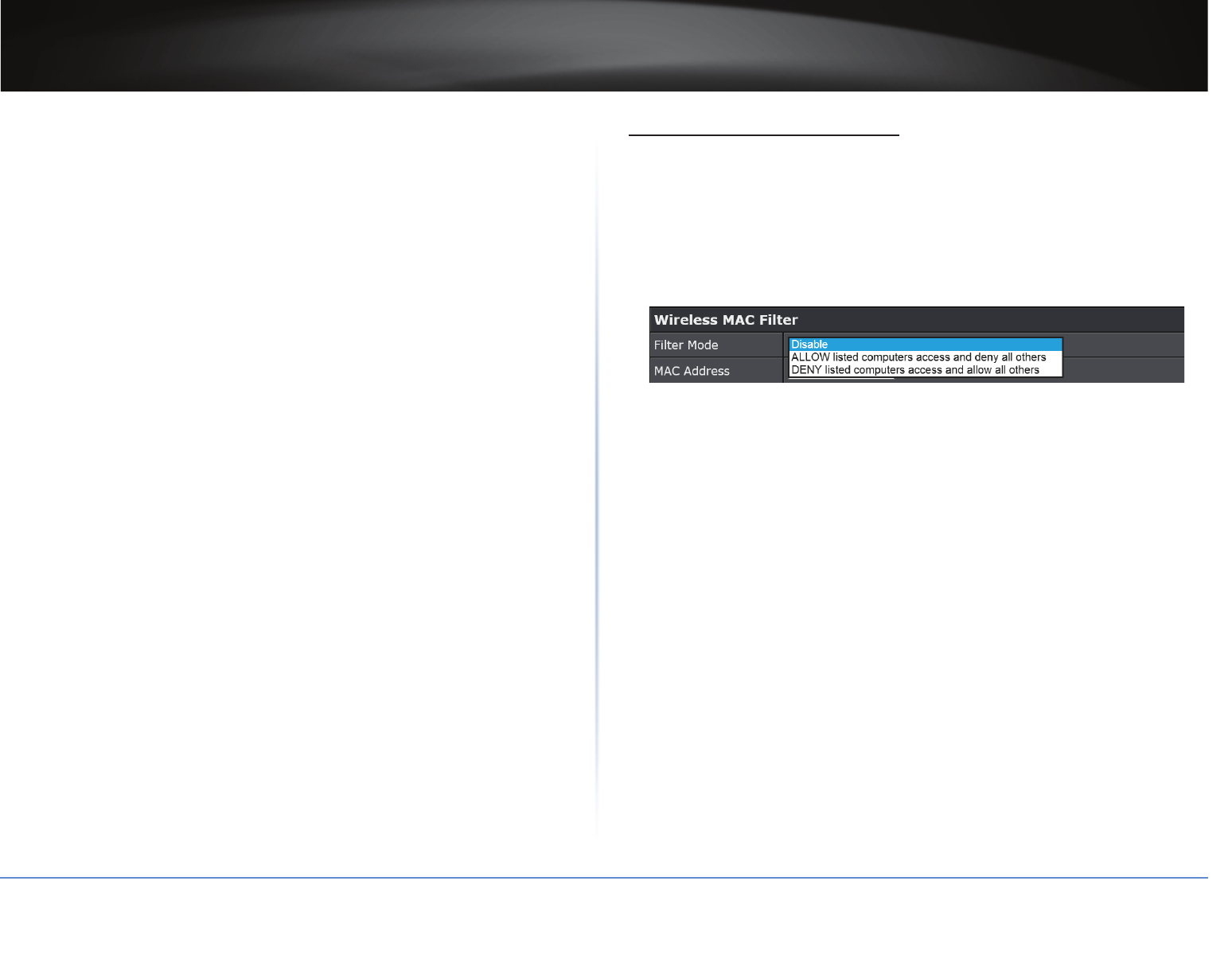
TRENDnet User’s Guide
TEW-821DAP
35
© Copyright 2015 TRENDnet. All Rights Reserved.
you must enter the Wireless Network Name (SSID) on the client manually to
connect to the network.
• Separate Staons: If you enable staon separaon, wireless clients (a.k.a. STAs)
associated with this SSID cannot communicate to each other directly even if they
are in the same wireless group.
• Security Mode: Please refer to
5 Click Apply to save the SSID informaon.
Congure MAC Filter Sengs
Wireless 2.4GHz > Wireless MAC Filter
Every network device has a unique, 12-digit MAC (Media Access Control) address. Using
MAC lters, you can allow or deny specic computers and other devices from using this
access point’s wireless network. You can enter up to 24 MAC address entries.
1 Log into your access point management page (refer to “Log in to Management Page”
on page 10).
2 Click Wireless 2.4GHz > Wireless Network.
3 On Filter Mode below, select one of the MAC lter funcon.
• Disable: Select this opon to disable the MAC address lter.
• ALLOW listed computers access and deny all others: Select this opon to only
allow computers/devices with MAC addresses listed to access the access point
management page and the Internet. Deny all others.
• DENY listed computers access and allow all others: Select this opon to only
deny computers/devices with MAC addresses listed to access to the access point
management page and the Internet. Allow all others.
ÍNote: MAC lter can be congured to allow access to the listed MAC address and
deny all others unlisted or vice versa. The recommended funcon is to choose to
only allow access to the MAC addresses listed and deny all others unlisted because
it is easier to determine the MAC addresses of devices in your network then to
determine which MAC addresses you do not want to allow access.
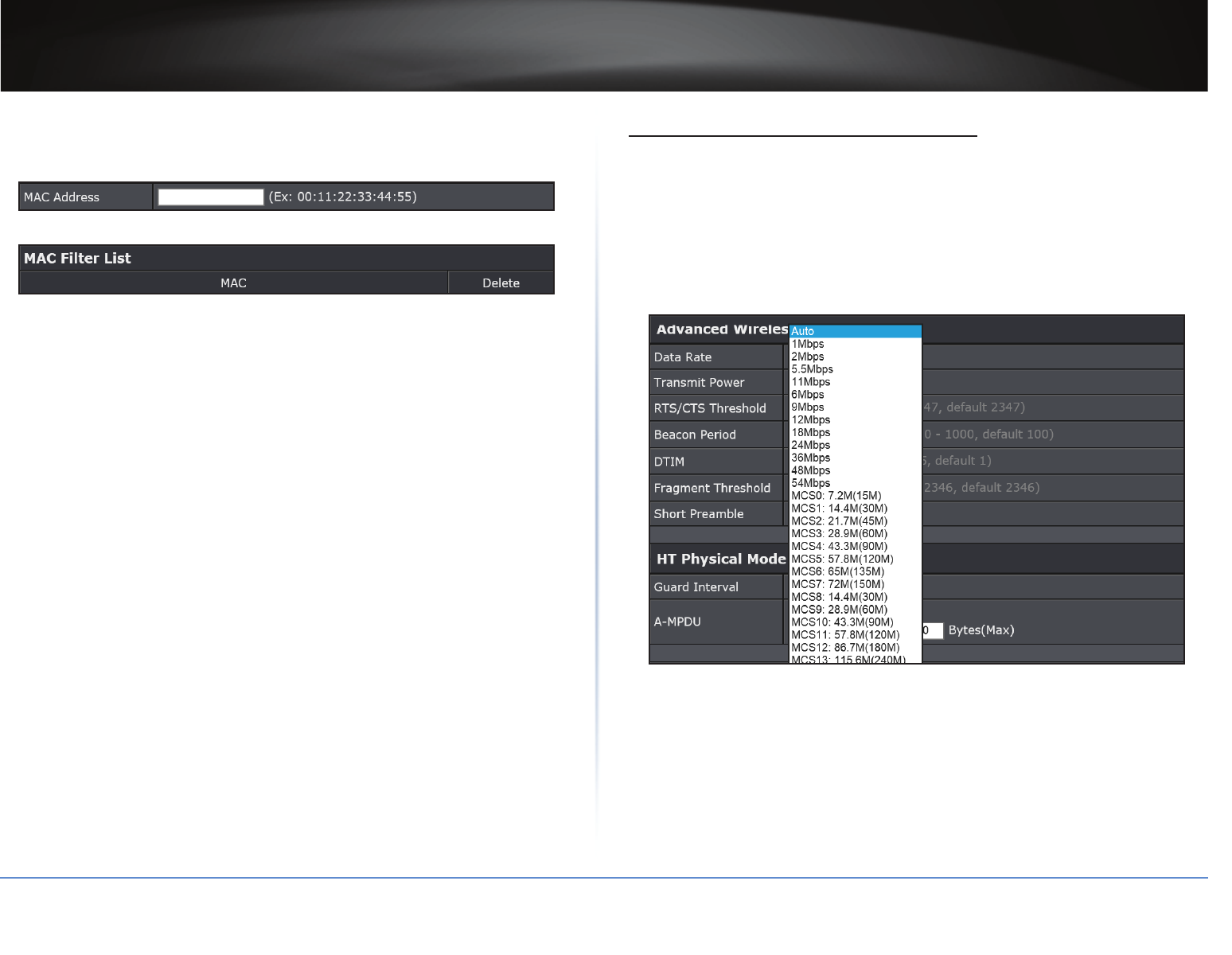
TRENDnet User’s Guide
TEW-821DAP
36
© Copyright 2015 TRENDnet. All Rights Reserved.
4 Enter the MAC address you wish to allow or deny depending on the Filter Mode
opon. The MAC address needs to be lled in in the hexadecimal format. For example,
00:11:22:33:44:55.
You can review the added MAC addresses in MAC Filter List table.
ÍNote: To remove the MAC address from the MAC Filter List, click Delete next to the
chosen MAC address.
5 Click Apply to save the changes or Cancel to discard the sengs.
Congure Wireless Advanced Sengs
Wireless 2.4GHz > Wireless Advanced Sengs
Fine tune your wireless sengs on this page.
1 Log into your access point management page (refer to “Log in to Management Page”
on page 10).
2 Click Wireless 2.4GHz > Wireless Advanced Sengs.
3 In Advanced Wireless secon, modify any of the following parameters:
• Data Rate: Choose a xed data rate for 802.11b and g mode and MCS number for
802.11n, or choose Auto for automac rate adapng. The default seng is Auto.
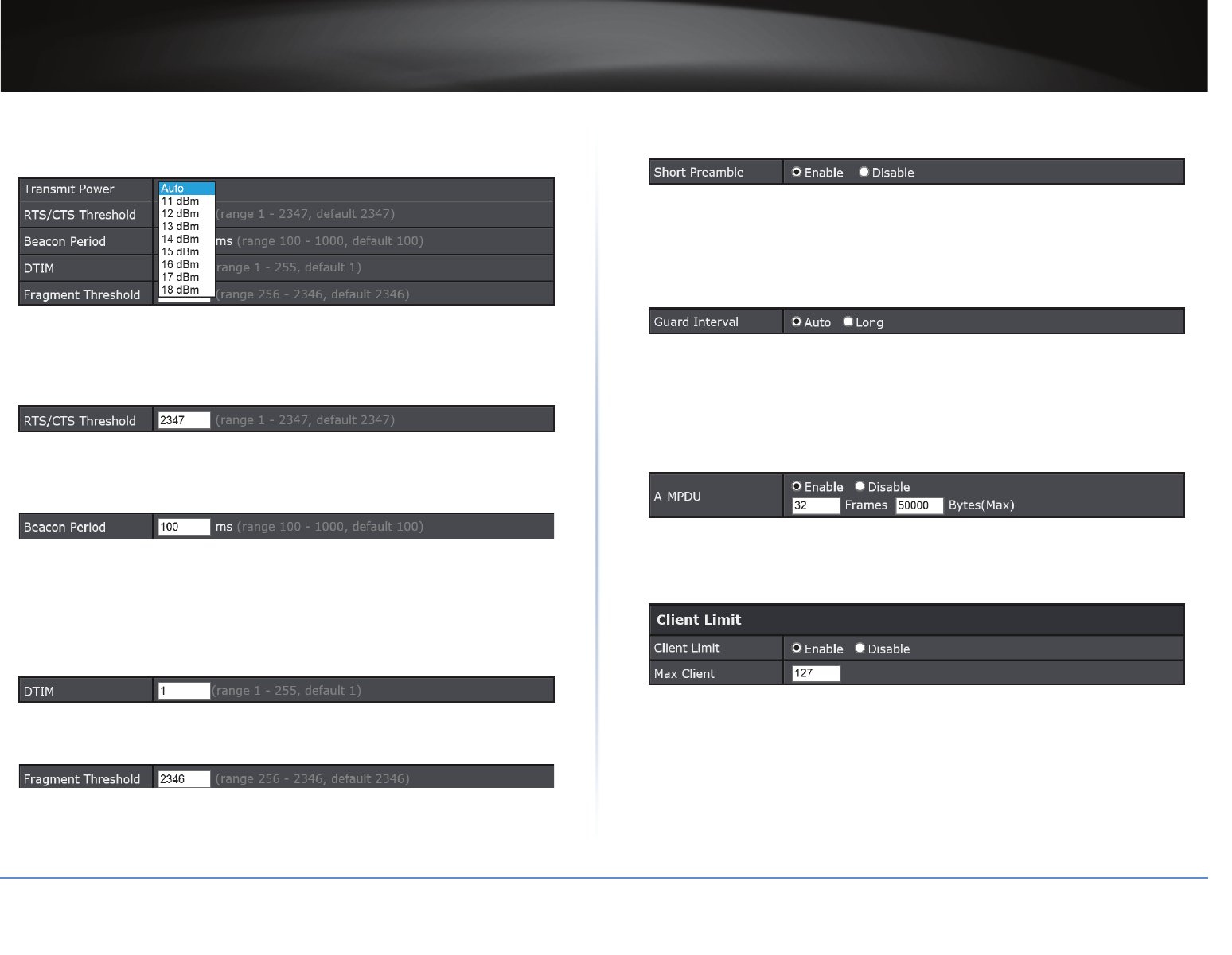
TRENDnet User’s Guide
TEW-821DAP
37
© Copyright 2015 TRENDnet. All Rights Reserved.
• Transmit Power: Wireless signal transmission power. Seng transmission power
to an appropriate value can make your mulple AP deployment easier. The default
value is 18 dBm. Valid sengs are between 11 and 18 (both FCC and CE).
• RTC/CTS Threshold: Packets over the specied size will use the RTS/CTS
mechanism to maintain performance in noisy networks and to prevent hidden
nodes from degrading the performance. Specify a value between 1 and 2346. The
default value is 2346.
• Beacon Period: Beacons are packets sent by the access point to synchronize
wireless devices. Specify a Beacon Period value between 100 and 1000. The
default value is set to 100 milliseconds.
• DTIM: A DTIM is a countdown informing clients of the next window for listening to
broadcast and mulcast messages. When the access point has buered broadcast
or mulcast messages for associated clients, it sends the next DTIM with a
DTIM Interval value. Wireless clients detect the beacons and awaken to receive
the broadcast and mulcast messages. The default value is 1. Valid sengs are
between 1 and 255.
• Fragment Threshold: This seng should remain at its default value of 2346.
Seng the Fragmentaon value too low may result in poor performance.
• Short Preamble: Disable this feature if you do not want the access point to use it
at data transfer.
4 In HD Physical Mode secon, modify any of the following parameters:
• Guard Interval: Using a short (400ns) guard interval can increase throughput.
However, it can also increase error rate in some installaons, due to increased
sensivity to radio-frequency reecons. Select the opon between Auto and
Long that works best for your installaon.
• A-MPDU: MPDU aggregaon also collects Ethernet frames to be transmied
to a single desnaon, but it wraps each frame in an 802.11n MAC header.
Normally this is less ecient than MSDU aggregaon, but it may be more ecient
in environments with high error rates, because of a mechanism called block
acknowledgement. This mechanism allows each of the aggregated data frames to
be individually acknowledged or retransmied if aected by an error
5 In Client Limit secon, check Enable if you want to limit the number of clients and set
the maximum number of clients that can connect to TEW-821DAP. If you do not want
to use this feature, check Disable.
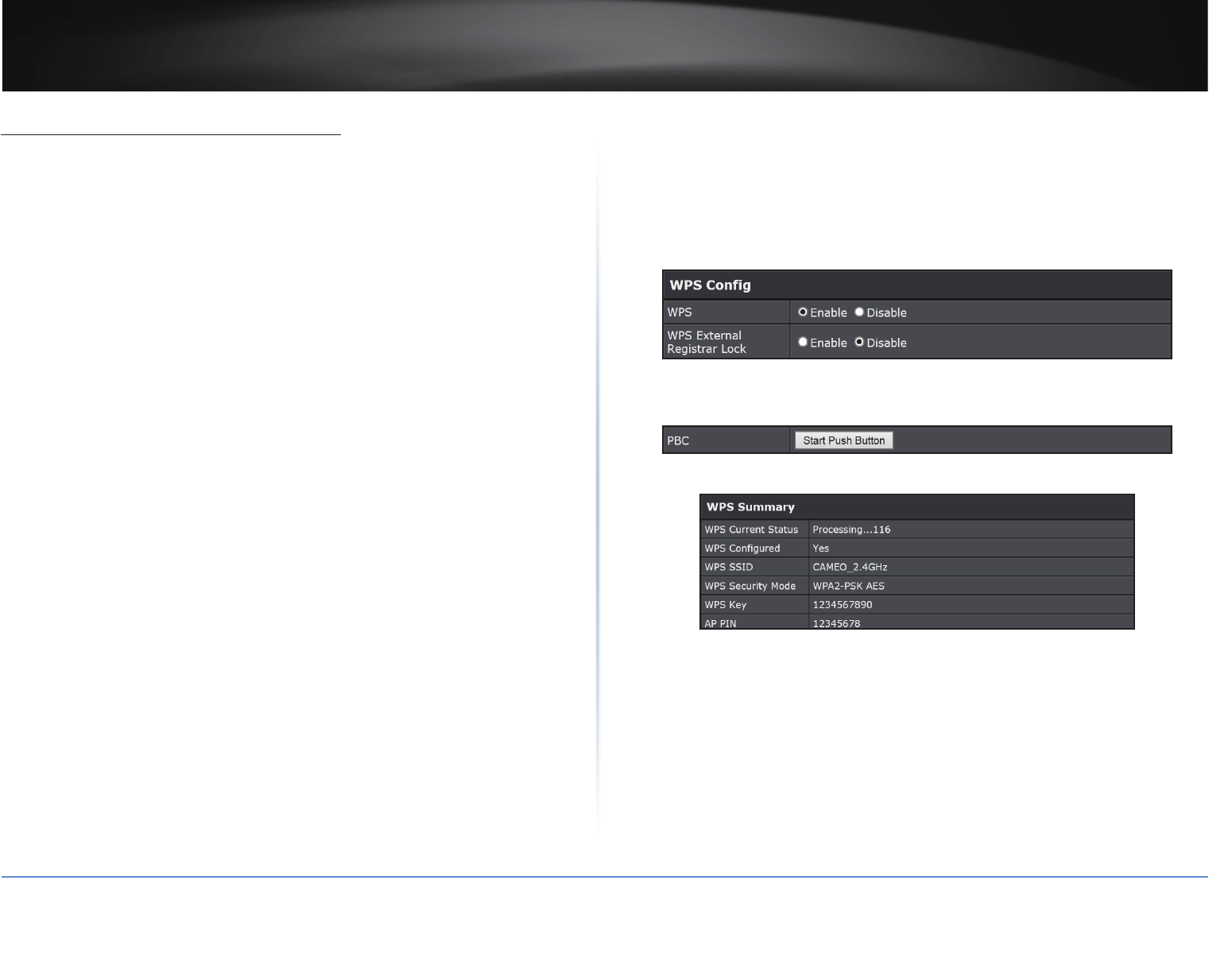
TRENDnet User’s Guide
TEW-821DAP
38
© Copyright 2015 TRENDnet. All Rights Reserved.
Connect Wireless Devices Using WPS
WPS (Wi-Fi Protected Setup) is a feature that makes it easy to connect devices to your
wireless network. If your wireless devices support WPS, you can use this feature to easily
add wireless devices to your network.
ÍNote: You will not be able to use WPS if you set the SSID Broadcast seng to Disabled
or if you are using WEP security. Please note that WPS funconality will only be
available when the Device Mode is set to Access Point mode under Main > Device
Mode.
There are two methods the WPS feature can easily connect your wireless devices to your
network.
• Push Buon Conguraon (PBC) method
• PIN (Personal Idencaon Number) method
ÍNote: Refer to your wireless device documentaon for details on the operaon of
WPS.
PBC (Soware/Virtual Push Buon)
Wireless 2.4GHz > WPS
1 Log into your access point management page (refer to “Log in to Management Page”
on page 10).
2 Click Wireless 2.4GHz > WPS.
3 In WPS Cong secon enable the WPS feature.
4 Enable or disable the WPS External Registrar Lock.
5 In the WPS Acon secon, click Start Push Buon to add a wireless device to your
network.
6 Wait for your access point to nish the WPS process.
The procedure is complete when the WPS Current Status in WPS Summary secon
becomes “Idle”.
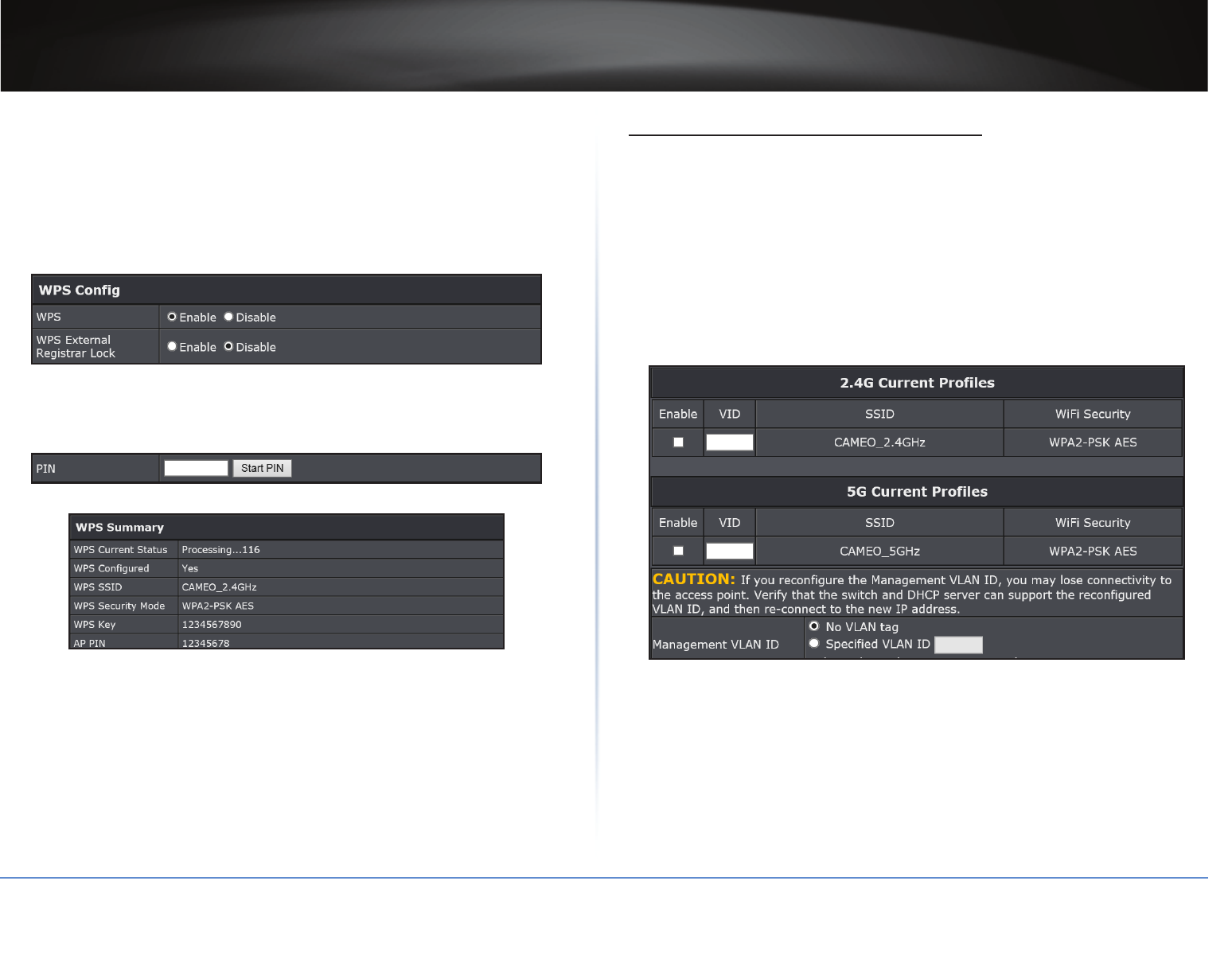
TRENDnet User’s Guide
TEW-821DAP
39
© Copyright 2015 TRENDnet. All Rights Reserved.
PIN (Personal Idencaon Number)
Wireless 2.4GHz > WPS
1 Log into your access point management page (refer to “Log in to Management Page”
on page 10).
2 Click Wireless 2.4GHz > WPS.
3 In WPS Cong secon enable the WPS feature.
4 Enable or disable the WPS External Registrar Lock.
5 In the WPS Acon secon, enter the 8-digit pin number and click Start Push Buon to
add a wireless device to your network.
ÍNote: The PIN number is listed in WPS Summary > AP PIN.
6 Wait for your access point to nish the WPS process.
The procedure is complete when the WPS Current Status in WPS Summary secon
becomes back “Idle”.
Congure Management VLAN Sengs
Management > Management VLAN
This feature is only available under Access Point or WDS AP mode and allows users
to congure the 802.1q VLAN sengs to for all wireless clients. A VLAN is a group of
computers on a network whose soware has been congured so that they behave as if
they were on a separate Local Area Network (LAN). Computers on VLAN do not have to
be physically located next to one another on the LAN.
To congure the management VLAN sengs, do the following:
1 Log into your access point management page (refer to “Log in to Management Page”
on page 10).
2 Click Management > Management VLAN.
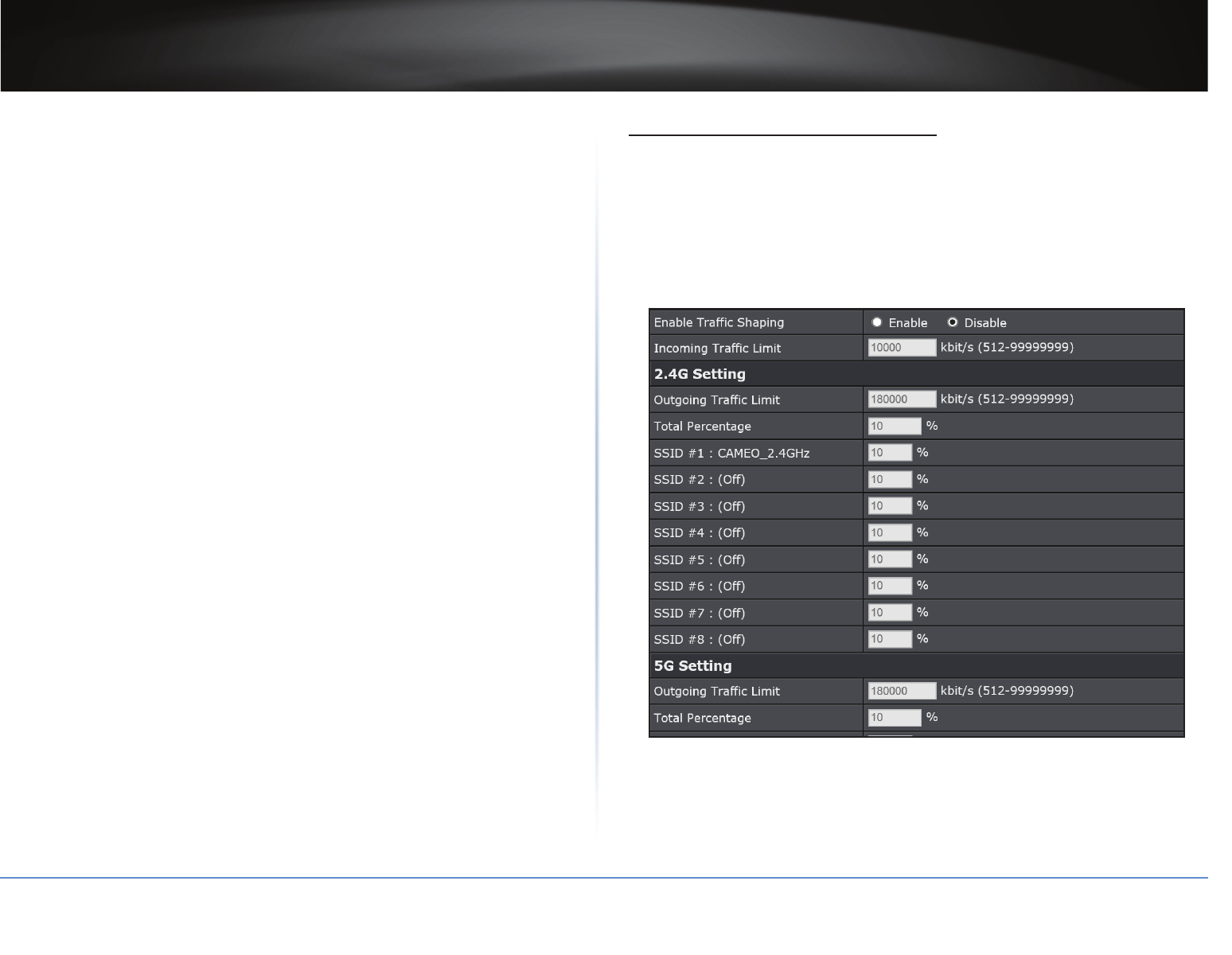
TRENDnet User’s Guide
TEW-821DAP
40
© Copyright 2015 TRENDnet. All Rights Reserved.
3 Congure or view any of the following parameters:
• Enable: Redundant control to enable or disable the parcular SSID.
• VID: Virtual LAN ID.
• No VLAN tag: Management VLAN packets are not tagged by default.
• Specied VLAN ID: Select this if you want to separate the management VLAN.
Enabling tagging will redirect all services, including web management and DHCP,
to a specic VLAN, specied in VLAN ID eld. (1 ~ 4094).
• SSID: Showing the human readable SSID.
• Wi Security: Wireless security set to the SSID.
4 Click Apply to save the management VLAN sengs or Cancel to discard the changes.
Congure Trac Shaping Sengs
Management > Wireless Trac Shaping
Trac shaping regulates the ow of packets leaving an interface to deliver improved
Quality of Service.
To congure the trac shaping sengs, do the following:
1 Log into your access point management page (refer to “Log in to Management Page”
on page 10).
2 Click Management > Wireless Trac Shaping.
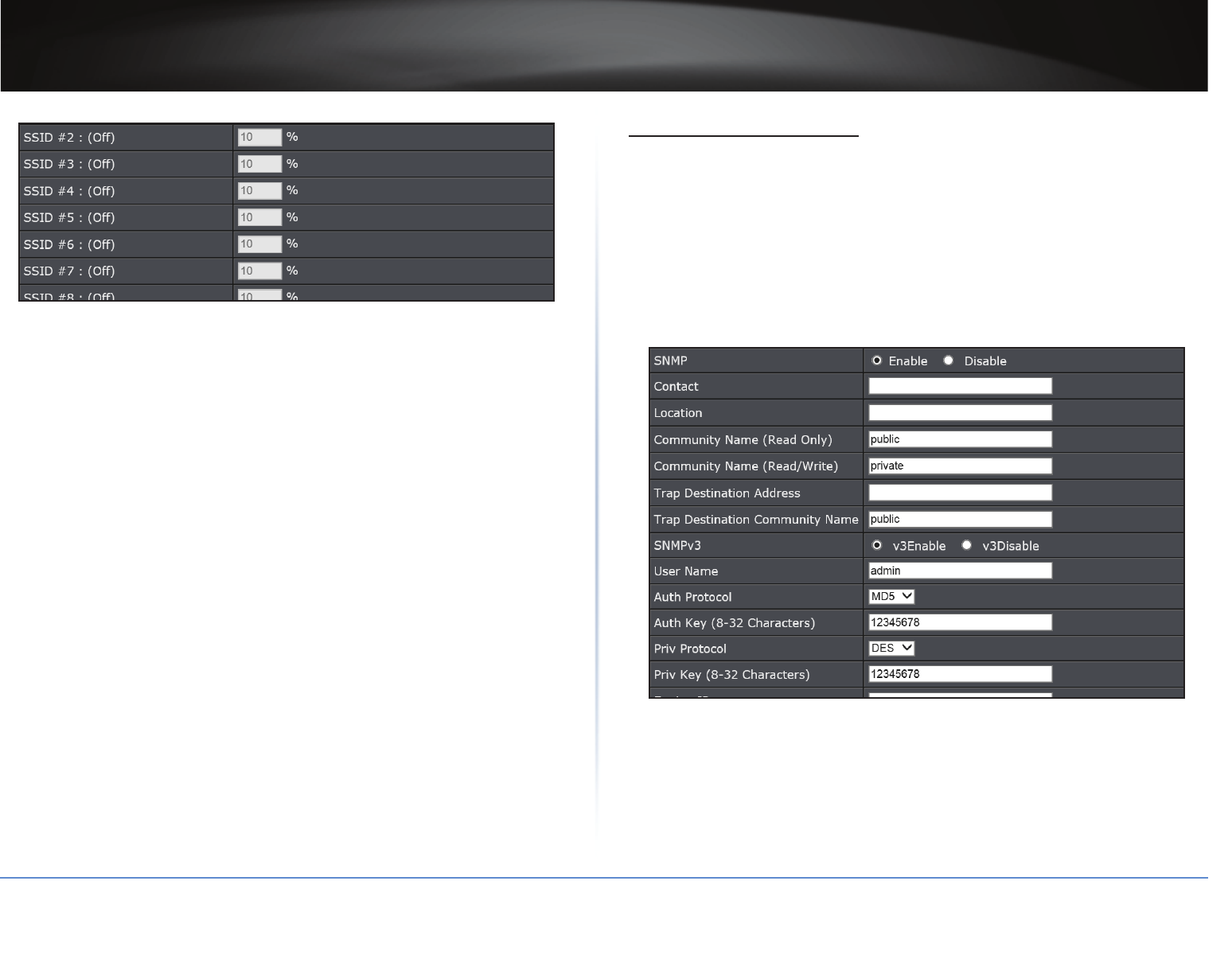
TRENDnet User’s Guide
TEW-821DAP
41
© Copyright 2015 TRENDnet. All Rights Reserved.
3 Congure any of the following parameters for 2.4G or 5G prole:
• Outgoing Trac Limit: Set the trac limitaon going through the wireless
interface. The default value is 180Mbps (180,000). The number can be set from
512 to 99,999,999. The trac will be limited by this value and physical speed
whichever is lower. (The TEW-821DAP wireless interfaces are capable of 300
Mbps, 300,000 kbps for 2.4GHz and 5GHz respecvely.)
• Incoming Trac Limit: Set the trac limitaon going through Ethernet port. The
default value is 10Mbps (10,000). The number can be set from 512 to 99,999,999.
The trac will be limited by this value and physical speed whichever is lower. (The
TEW-821DAP Ethernet port is capable of 1Gbps, 1,000,000 kbps.)
• Total Percentage: This value adds up all numbers in following 8 SSID percentage
sengs. This value may exceed 100, up to 800. The trac limit of this wireless
interface is calculated as: Outgoing Trac Limit * Total Percentage.
• SSID (1 - 8): Set the number you want to shape your trac for clients connects to
specic SSIDs by increasing or decreasing the value. The default value is 10 (%).
The number can be set from 0 to 100. The trac limit of this SSID is calculated as:
Outgoing Trac Limit * Total Percentage.
4 Click Apply to save the changes or Cancel to discard the changes.
Congure SNMP Sengs
Management > SNMP Sengs
SNMP Sengs allows you to assign the contact details, locaon, community name and
trap sengs for SNMP. This is a networking management protocol used to monitor
network-aached devices. SNMP allows messages (called protocol data units) to be sent
to various parts of a network. Upon receiving these messages, SNMP-compable devices
(called agents) return data stored in their Management Informaon Bases.
1 Log into your access point management page (refer to “Log in to Management Page”
on page 10).
2 Click Management > SNMP Sengs.
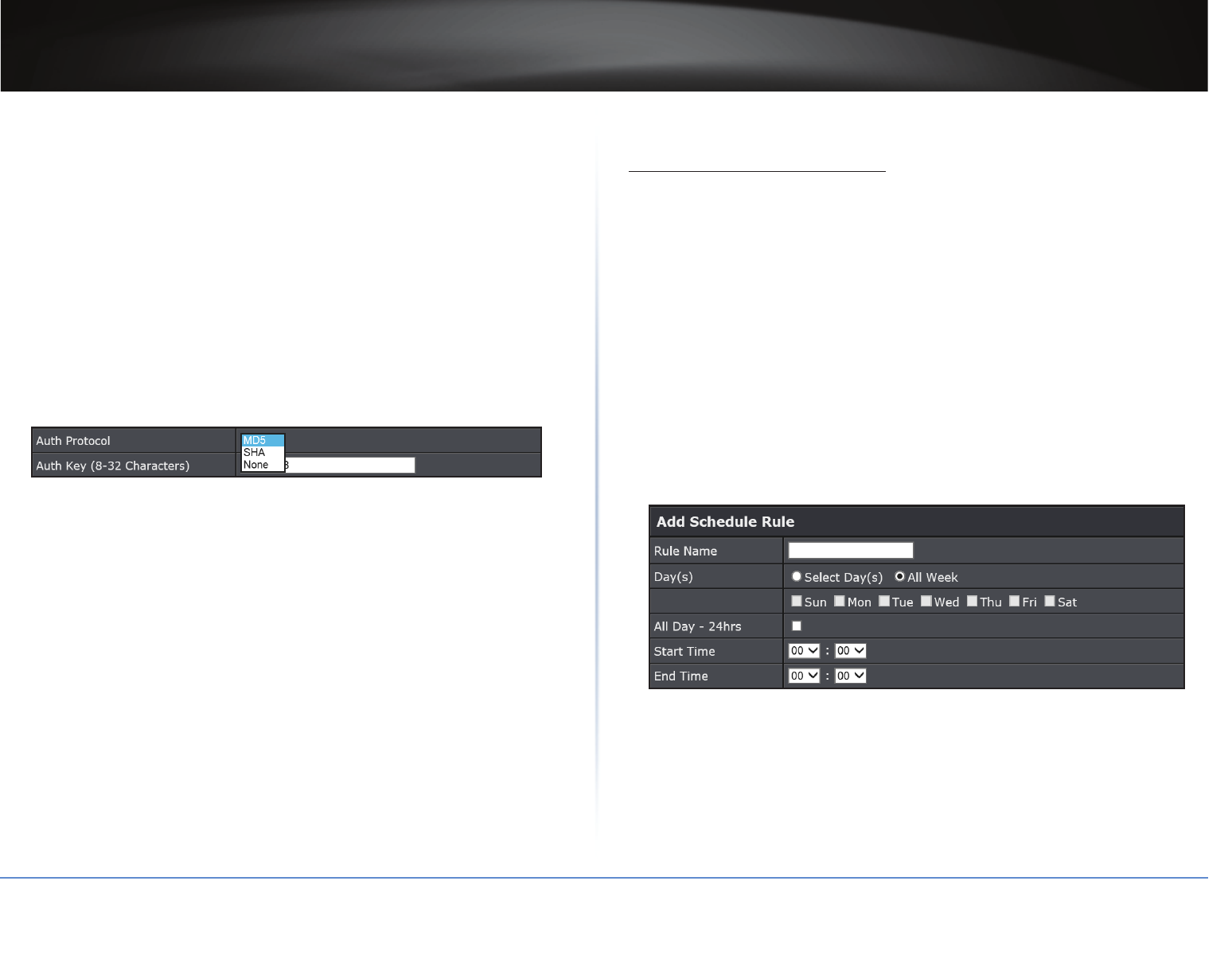
TRENDnet User’s Guide
TEW-821DAP
42
© Copyright 2015 TRENDnet. All Rights Reserved.
3 Congure or view any of the following parameters:
• SNMP: Choose to enable or disable the SNMP feature.
• Contact: Specify the contact details of the TEW-821DAP.
• Locaon: Specify the locaon of the TEW-821DAP.
• Community Name (Read Only): Specify the password for access the SNMP
community for read only access.
• Community Name (Read/Write): Specify the password for access to the SNMP
community with read/write access.
• Trap Desnaon Address: Specify the IP address for the SNMP trap community.
• Trap Desnaon Community Name: Specify the name of SNMP trap community.
• SNMP v3: Select enable or disable SNMP v3 protocol.
• User Name: SNMP v3 manager user name.
• Auth Protocol: Choose the authencaon method to verify the source of
informaon: MD5, SHA, or None.
• Auth Key (8-32 Characters): Specify the authencaon key between 8 to 32
leers.
• Priv Protocol: Choose the privacy key to encrypt SNMP messages: DES or None.
• Priv Key (8-32 Characters): Specify the privacy key between 8 to 32 leers.
• Engine ID: SNMPv3 engine ID.
4 Click Apply to save the changes or Cancel to discard the changes.
Congure Schedule Sengs
Management > Schedule
For addional security control, your access point allows you to create schedules to
specify a me period when a feature on your access point should be acvated and
deacvated. Before you use the scheduling feature on your access point, ensure that your
system me is congured correctly.
ÍNote: You can apply a predened schedule to the following features:
9Wireless (2.4GHz and 5GHz)
9Wireless Mulple SSID (2.4GHz and 5GHz)
9MAC Filters
Create a Schedule
To create a schedule, do the following:
1 Log into your access point management page (refer to “Log in to Management Page”
on page 10).
2 Click Management > Schedule.
3 Congure the following sengs:
• Rule Name: Enter a name for the schedule you would like to apply.
• Day(s): Check Select Day(s) to select the days in the Select Day(s) secon or select
All Week to set the schedule for all days.
• All Day – 24 hrs: Check this box to have the schedule acve the enre 24 hours on
the days specied.
• Start Time: Select the acvaon me of the schedule.
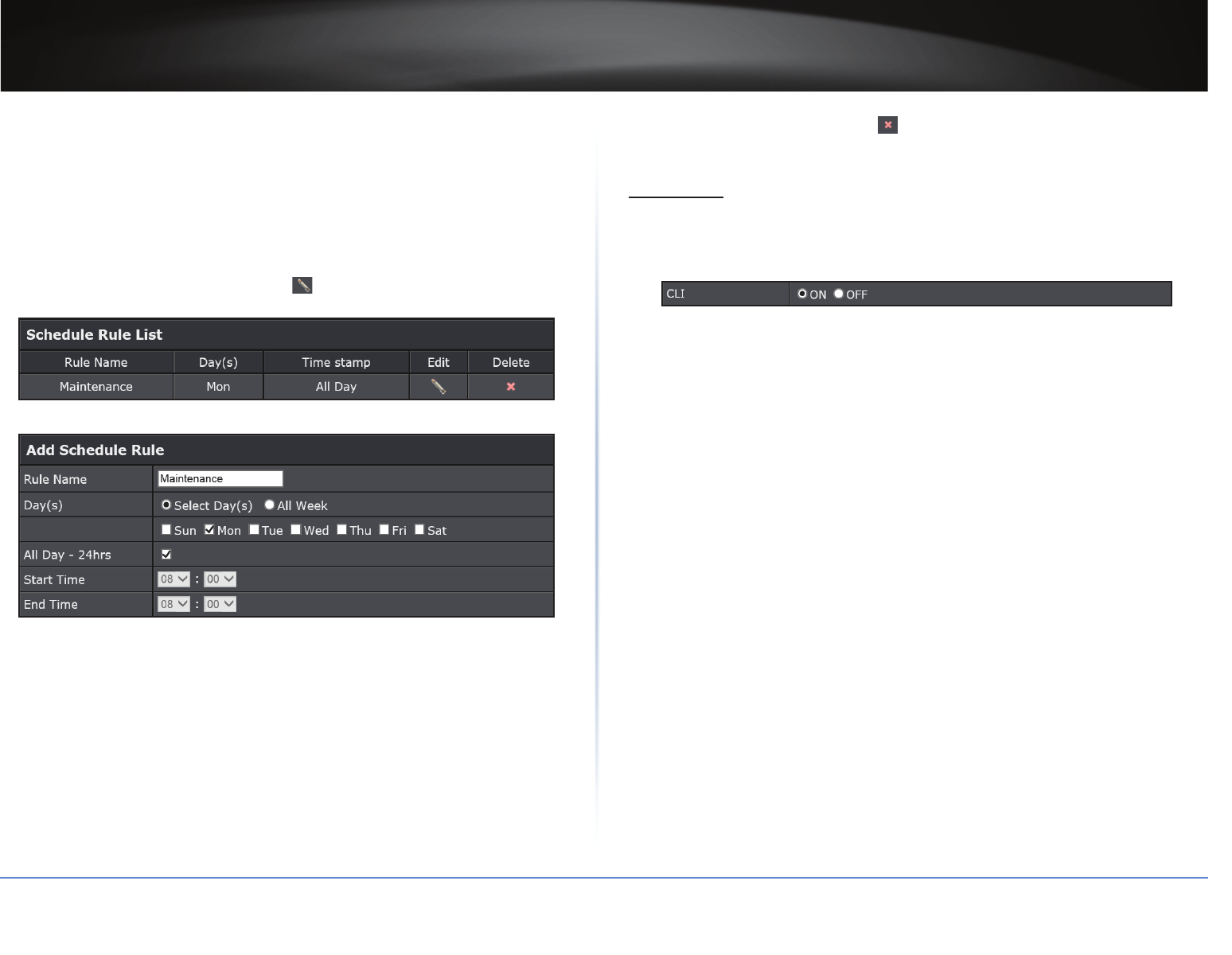
TRENDnet User’s Guide
TEW-821DAP
43
© Copyright 2015 TRENDnet. All Rights Reserved.
• End Time: Select the deacvaon me of the schedule.
4 Click Add to create a schedule or Clear to discard the changes.
Edit a Schedule
1 Log into your access point management page (refer to “Log in to Management Page” on
page 10).
2 Click Management > Schedule.
3 On the Schedule Rules List secon, click the icon next to the schedule that you want
to edit.
4 Adjust the necessary sengs.
5 Click Save to save the sengs.
ÍNote: To delete a schedule, click the icon next to the schedule that you want to
delete. A conrmaon message appears on the screen. Click Yes to conrm.
Enable CLI
Management > CLI Sengs
To enable the Command Line Interface for batch management or advanced conguraon,
select CLI ON and then click Apply.
Access the CLI interface using SSH with the administrator user name and password. For
example (in Linux):
$ ssh admin@192.168.10.100
The authenticity of host ‘192.168.10.100
(192.168.10.100)’ can’t be established.
RSA key ngerprint is b2:41:6e:0f:4b:2a:f3:03:18:60:
0b:c4:eb:74:9d:9c.
Are you sure you want to continue connecting (yes/
no)? yes
admin@192.168.10.100’s password:
*** Hi admin, welcome to use cli(V-1.7.6) ***
---========= Commands Help =========---
stat -- Status
sys -- System
wless2 -- 2.4G-Wireless
wless5 -- 5G-Wireless
mgmt -- Management
tree -- Tree
help -- Help
reboot -- Reboot
tew-753dap>
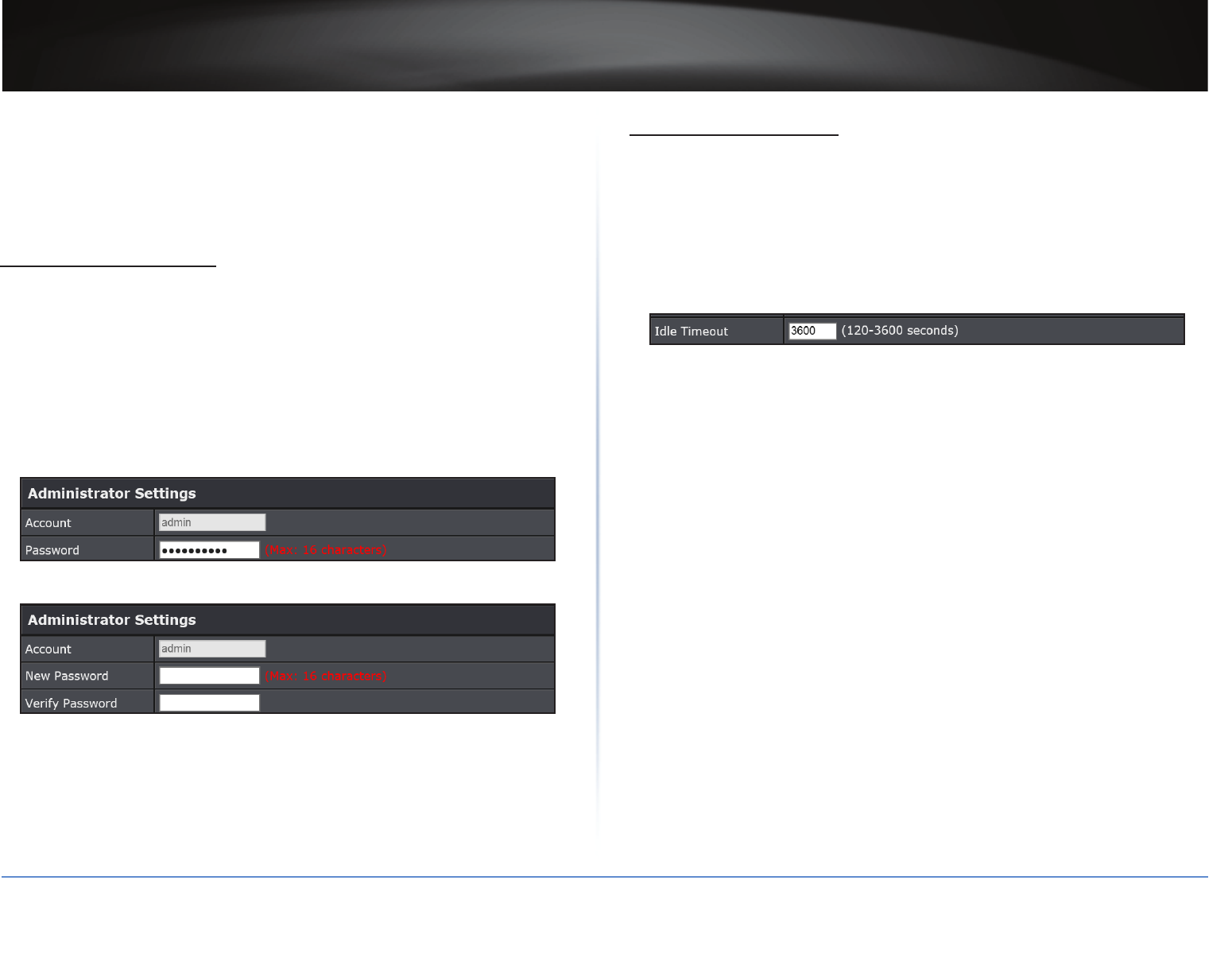
TRENDnet User’s Guide
TEW-821DAP
44
© Copyright 2015 TRENDnet. All Rights Reserved.
Management
This secon will guide you how to change login password, update the rmware,
export/import the system sengs, restore the default sengs, and other maintenance
operaons.
Change Login Password
Management > Administraon
For security purposes, it is recommended to change the login password periodically.
Passwords can contain 0 to 12 alphanumeric characters, and are case sensive.
You can change the password in Management > Administraon secon or through the
System > Wizard. The following instrucons includes both opons.
1 Log into your access point management page (refer to “Log in to Management Page” on
page 10).
2 Click one of the following:
• Management > Administraon
• System > Wizard.
3 Do one of the following:
Management > Administraon
a) Enter the new password in Password eld.
b) Click Apply to save the modicaon.
System > Wizard
a) Enter the new password in New Password eld.
b) To verify, enter the new password in Verify Password eld.
c) Click Next to save the changes.
Modify Menu Timeout
Management > Administraon
The menu idle meout seng controls how long the connecon can remain idle before
the system forces the remote user to log in again.
1 Log into your access point management page (refer to “Log in to Management Page”
on page 10).
2 Click Management > Administraon.
3 In Administrator Seng secon modify the idle meout in seconds.
4 Click Apply to save the idle meout sengs or Cancel to discard the modicaons.
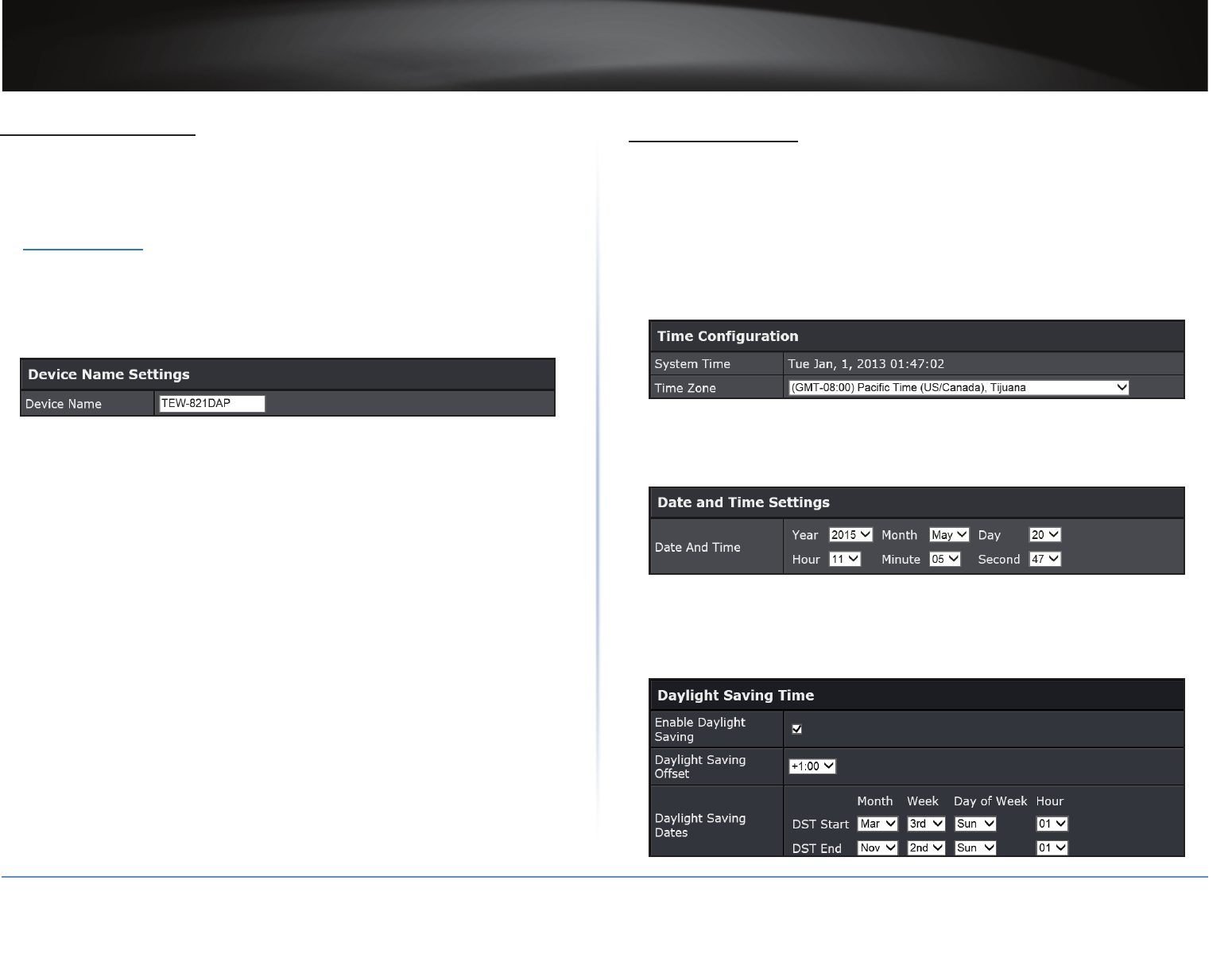
TRENDnet User’s Guide
TEW-821DAP
45
© Copyright 2015 TRENDnet. All Rights Reserved.
Change Device Name
Management > Administraon
For easy access, you can also enter the Management page using the domain name
(hp://device name) based on the device name that you have congured in this secon.
ÍNote: By default, the domain name is the same as your access point model name
(hp://tew-821dap).
1 Log into your access point management page (refer to “Log in to Management Page”
on page 10).
2 Click Management > Administraon.
3 On the Device Name Sengs secon, enter the new device name to display on your
network to idenfy the access point in the Device Name eld.
4 Click Apply to save the changes or Cancel to discard the changes.
Set Date and Time
Management > Time and Date Sengs
The accuracy of the system clock is important for scheduling and accurate logging. You
can synchronize the system me with your computer, or automacally check the me
accuracy with a network me server (NTP server).
1 Log into your access point management page (refer to “Log in to Management Page”
on page 10).
2 Click Management > Time and Date Sengs.
3 View or modify the following sengs in Time Conguraon secon:
• System Time: Current date and me.
ÍNote: If you do not want to use the automac me conguraon (enable NTP server)
then modify me manually in Date and Time Sengs secon.
• Time Zone: Select the me zone of the country or region you are currently in. The
TEW-821DAP will set its me based on your selecon.
4 Check Enable Daylight Saving if your me zone has daylight savings. Enter the start
me and end me of daylight savings.
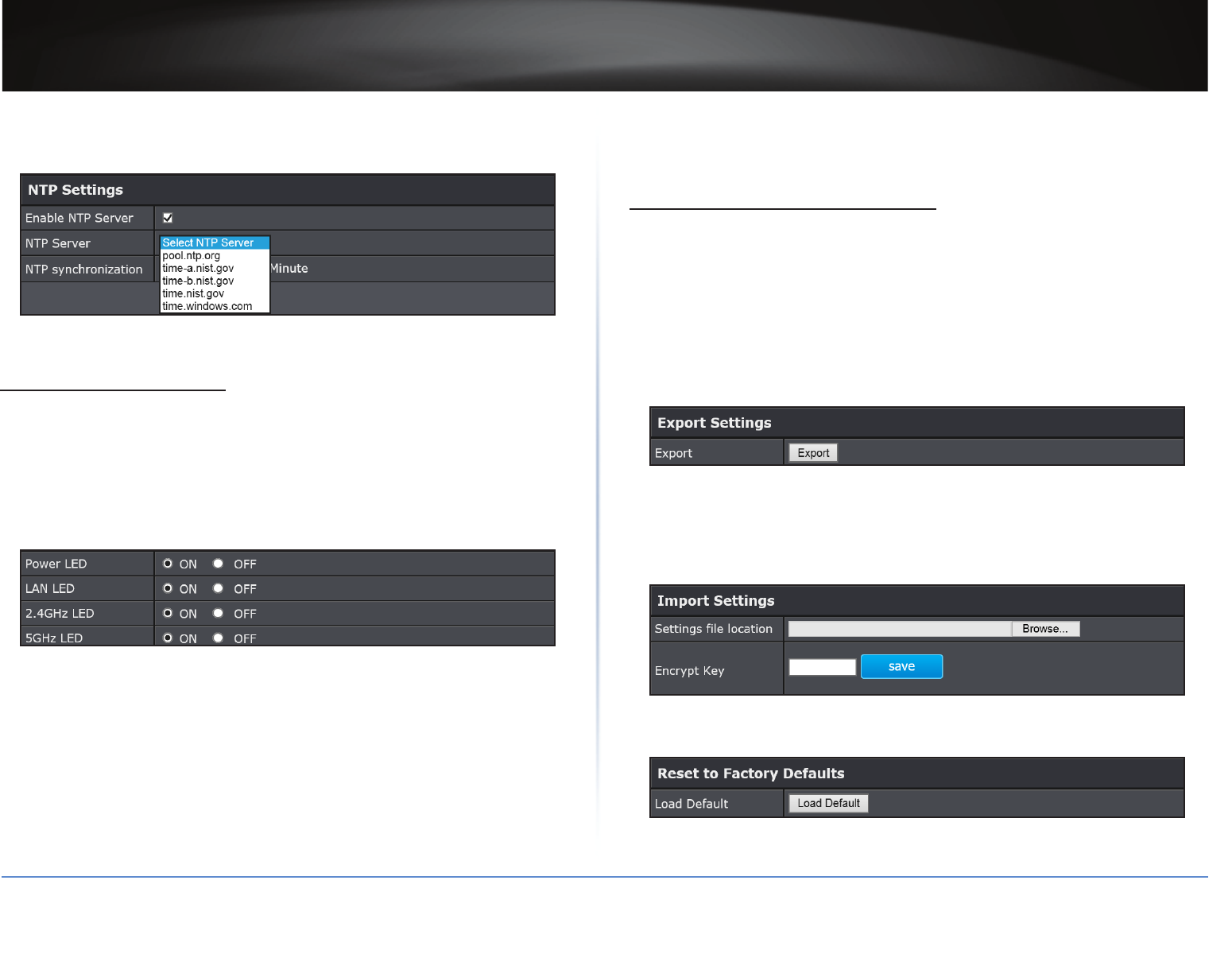
TRENDnet User’s Guide
TEW-821DAP
46
© Copyright 2015 TRENDnet. All Rights Reserved.
5 If you have a preferred NTP server, check the Enable NTP Server and enter the NTP
server IP address. Otherwise, leave it unchecked to use the TEW-821DAP’s default NTP
server.
6 Click Apply to save the changes or Cancel to discard the changes.
Congure LED Indicators
Management > LED Control
All LED indicators are turned on by default. You can turn any one of them or all of them
on or o.
1 Log into your access point management page (refer to “Log in to Management Page”
on page 10).
2 Click Management > LED Control.
3 Click the following LED to turn it on or o:
• Power LED:
OFF: Powered o.
Solid Orange: System is under Power-ON boong process.
Solid Green: System is ON. (Boong process is done.)
• Network LED (Orange: 10/100; Green: Giga bit):
OFF: No link.
Solid green: The device’s Ethernet port is connected to an acve router or
switch.
Blinking green: Data transmission.
• Wireless LED (Orange: 2.4GHz; Green: 5GHz):
OFF: No link.
Blinking green: Data transmission.
Backup / Restore System Sengs
Management > Backup/Restore Sengs
This page allows you to save the current conguraons, load previously saved
conguraons, and reset TEW-821DAP’s conguraons back to factory defaults.
1 Log into your access point management page (refer to “Log in to Management Page”
on page 10).
2 Click Management > Backup/Restore Sengs.
3 Do any of the following:
• Click Export to save the current conguraon of the AP.
• To load a conguraon le, do the following:
a) Click Browse to load the conguraon le.
b) Enter the encrypon key.
c) Click Import.
The new conguraon le will be saved and encrypted with this new key.
• Click Load Default if you want to reset TEW-821DAP’s conguraons back to
factory defaults.
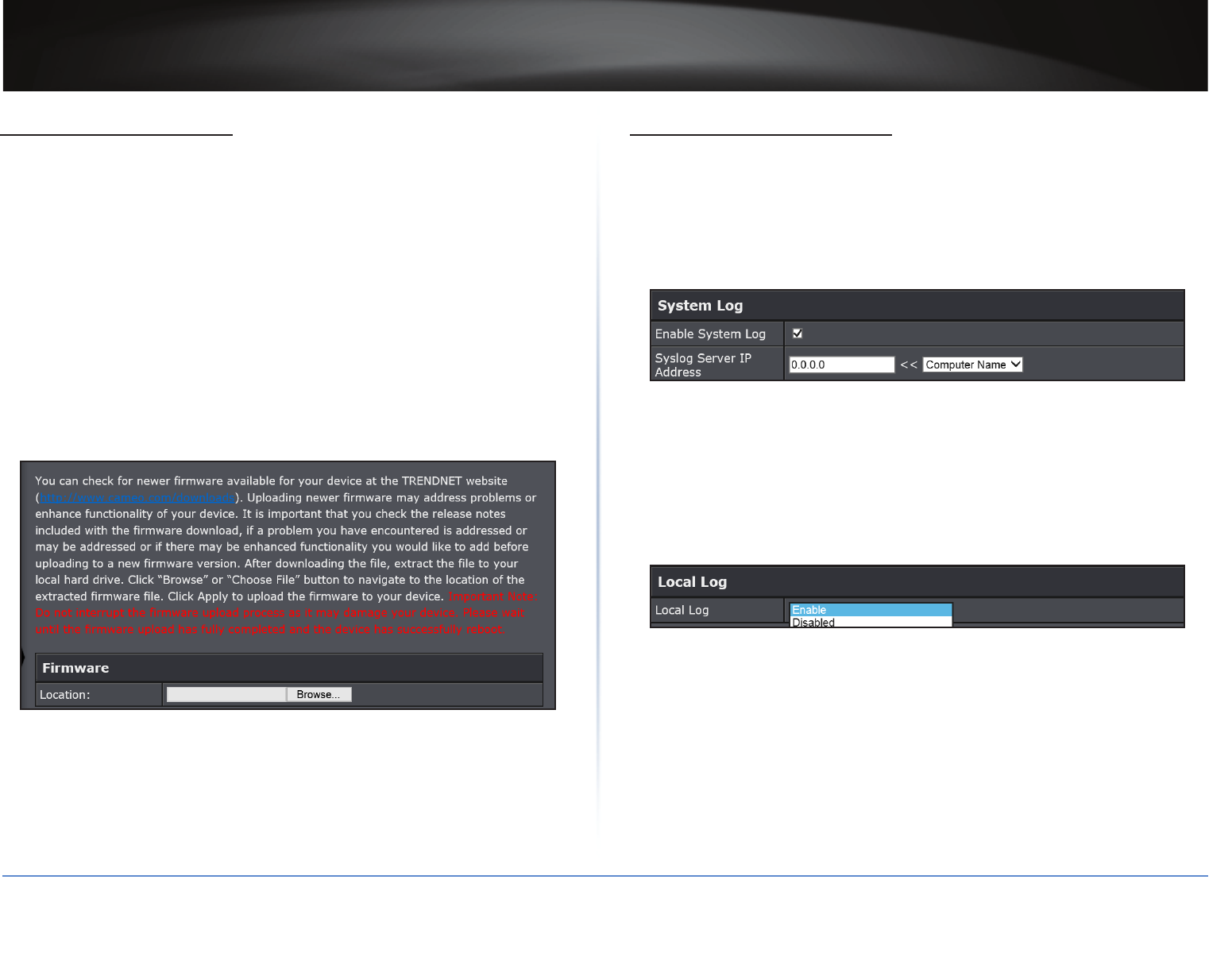
TRENDnet User’s Guide
TEW-821DAP
47
© Copyright 2015 TRENDnet. All Rights Reserved.
Update System Firmware
Management > Upload Firmware
TRENDnet may periodically release rmware upgrades that might add features or x
problems associated with your TRENDnet model and version. To nd out if there is a
rmware upgrade available for your device, please check your TRENDnet model and
version using the link.
hp://www.trendnet.com/downloads/
To update system rmware, do the following:
1 If a rmware upgrade is available, download the rmware to your computer.
2 Unzip the le to a folder on your computer.
3 Save the upgrade le on a ash disk.
4 Insert the ash disk into the AP.
5 Log into your access point management page (refer to “Log in to Management Page”
on page 10).
6 Click Management > Upload Firmware.
7 Click Browse to load the upgrade le from your computer.
8 Click Apply.
Congure System Log Server
Management > Log
To keep your system operang history, you can setup local and remote loggings.
To set up the remote loggings, do the following:
1 Log into your access point management page (refer to “Log in to Management Page”
on page 10).
2 Click Management > Log.
3 Check the Enable System Log checkbox.
4 Enter the log server IP address or URL.
5 Click Apply to save the sengs.
To set up the local loggins, do the following:
1 Log into your access point management page (refer to “Log in to Management Page”
on page 10).
2 Click Management > Log.
3 Select Enable to allow local logging.
You can view the log in Status > System Log.
4 Click Apply to save the sengs.
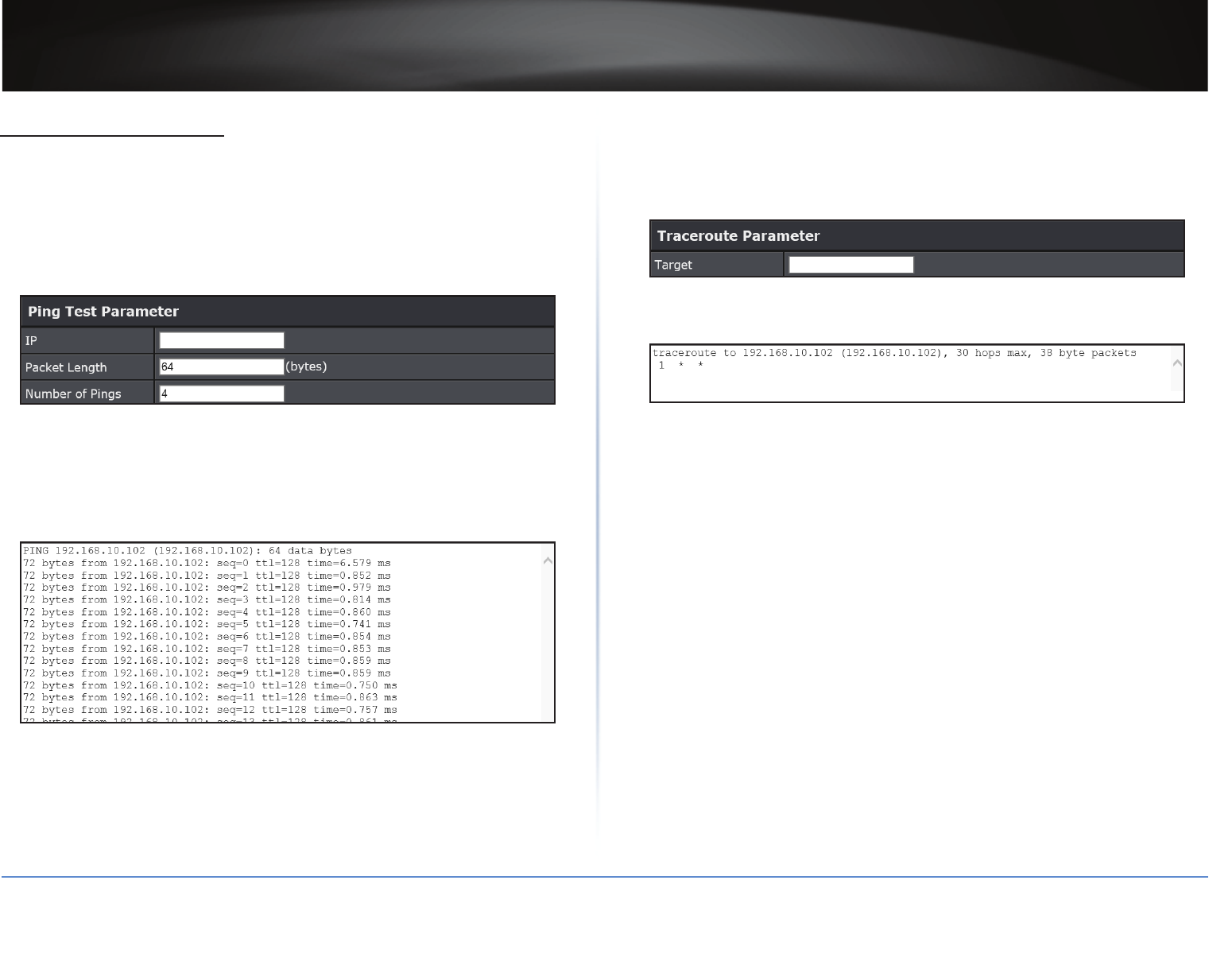
TRENDnet User’s Guide
TEW-821DAP
48
© Copyright 2015 TRENDnet. All Rights Reserved.
Execute Diagnoscs Test
Management > Diagnoscs
There are 2 network tools you can use on the TEW-821DAP: ping and traceroute.
To use ping test, do the following:
1 Log into your access point management page (refer to “Log in to Management Page”
on page 10).
2 Click Management > Diagnoscs.
3 Enter the following informaon:
• Target IP address to the IP eld.
• Ping packet size to the Packet Length eld.
• Number of pings to the Number of Pings eld.
4 Click Ping to start the test.
The result is displayed as shown on the following image:
To use the traceroute test, do the following:
1 Log into your access point management page (refer to “Log in to Management Page”
on page 10).
2 Click Management > Diagnoscs.
3 Enter the target machine IP address or domain name to the Target eld.
4 Click Traceroute to start the test.
The result is displayed as shown on the following image:
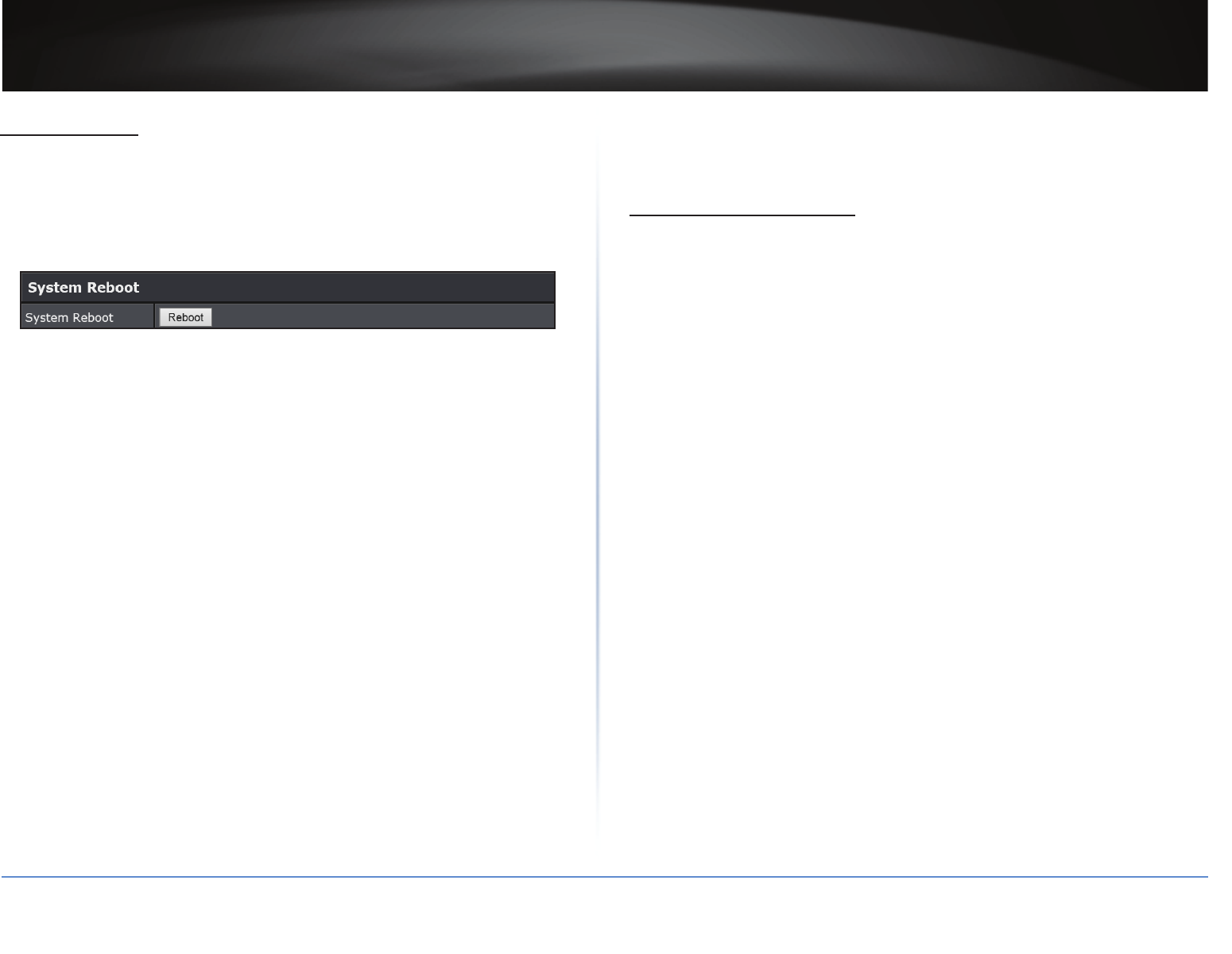
TRENDnet User’s Guide
TEW-821DAP
49
© Copyright 2015 TRENDnet. All Rights Reserved.
System Reboot
Management > Backup/Restore Sengs
To reboot the AP, do the following:
1 Log into your access point management page (refer to “Log in to Management Page”
on page 10).
2 Click Management > Backup/Restore Sengs.
3 Click Reboot.
SmartConsole
Use SmartConsole to view and edit the main parameters of the devices, such as product
name, IP address, MAC address, rmware version, etc.
Install the SmartConsole
To install the SmartConsole in your computer, do the following:
1 Download and install Adobe AIR soware to your computer.
2 From the supplied CD, copy the SmartConsole program to the local disk of your
computer.
3 Run “AP Ulity.exe” in SmartConsole folder.
The program main screen opens. Please refer to the next secon.
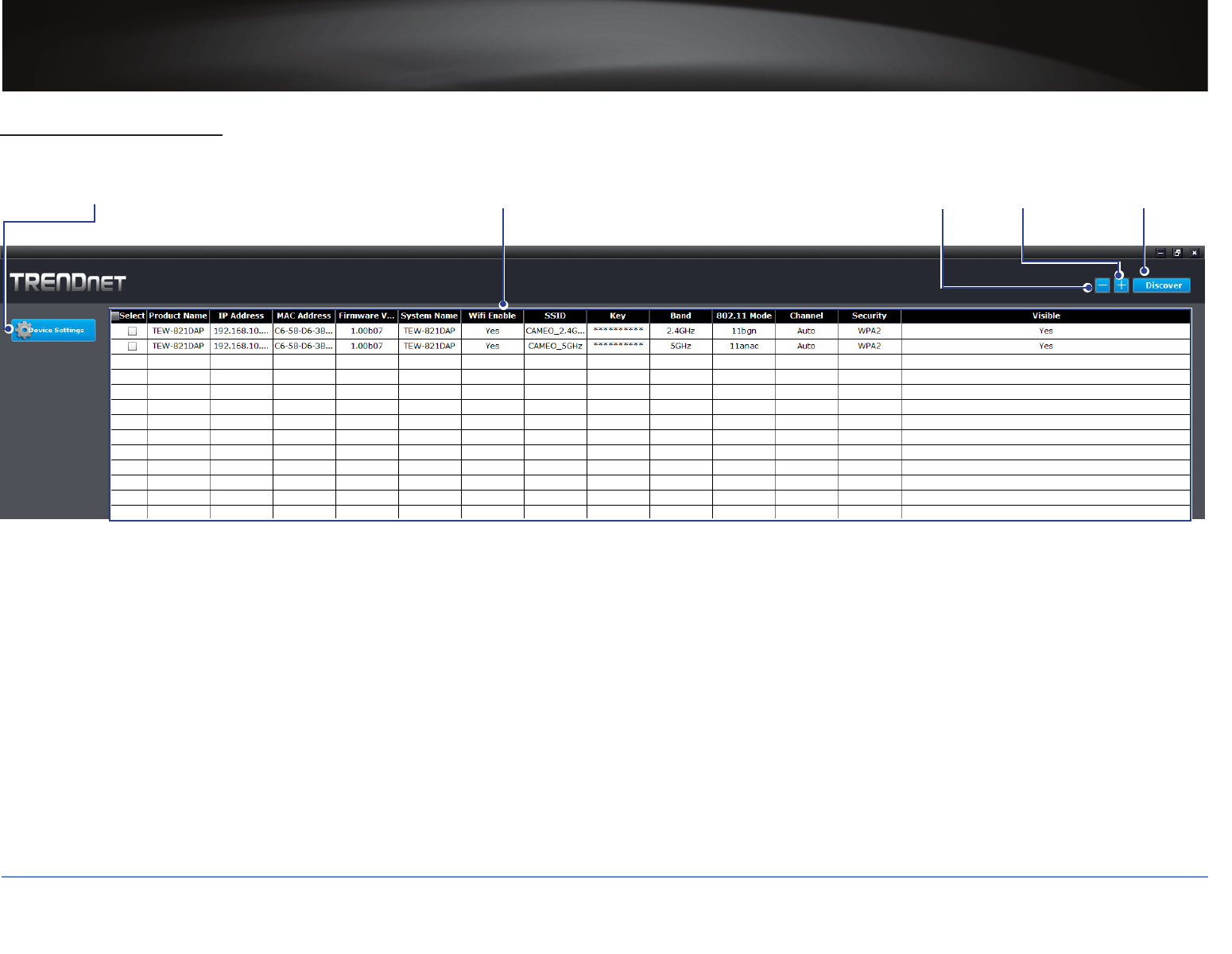
TRENDnet User’s Guide
TEW-821DAP
50
© Copyright 2015 TRENDnet. All Rights Reserved.
SmartConsole Overview
The following image displays the main page of the SmartConsole:
Opens device sengs page Discovered devices and their parameters Delete device
Add device
manually Find devices
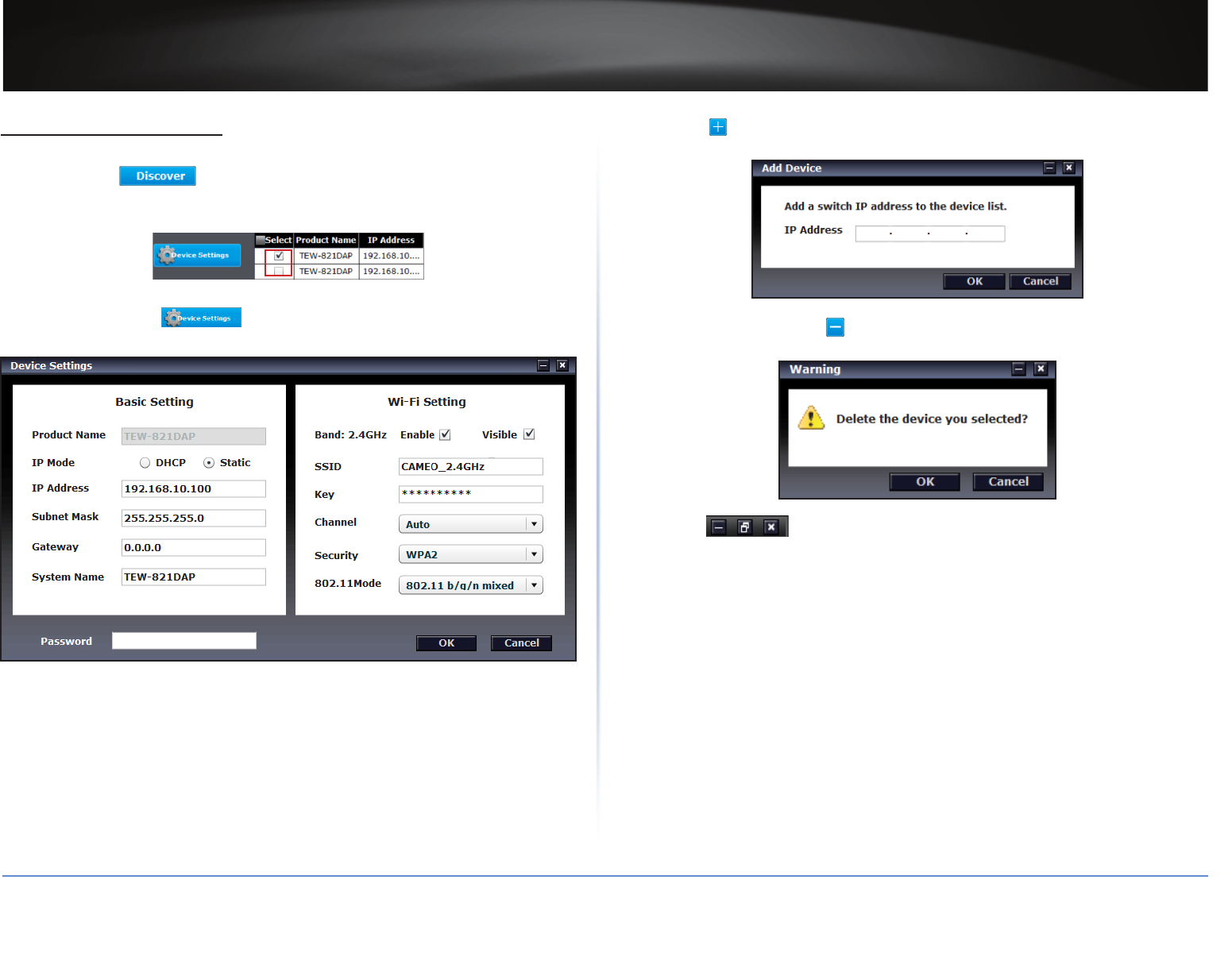
TRENDnet User’s Guide
TEW-821DAP
51
© Copyright 2015 TRENDnet. All Rights Reserved.
Using the SmartConsole
To start using the SmartConsole, do the following:
1 Click Discover ( ) to let the system automacally discover all available
devices in the network.
2 Click on the Select checkbox next to the device you wish to congure.
3 Click Device Sengs ( ) to open the selected device’s sengs page.
The Device Sengs page opens:
4 Modify the basic / wi- sengs and aer nished, click OK to save the changes or
Cancel to discard the changes.
5 Do any of the following:
• Repeat steps 1 to 4 to modify the sengs of another device.
• Click to insert the device connecon parameters manually. Then click OK and
repeat steps 2 to 4.
• Repeat step 2 and click to delete the device from the list. Click OK to the
conrmaon message.
• Use to minimize, restore, or close the main page respecvely.

TRENDnet User’s Guide
TEW-821DAP
52
© Copyright 2015 TRENDnet. All Rights Reserved.
Appendix
Specicaons
Item Specicaons
Chipset Qualcomm QCA9563+QCA9882
Standards • EEE 802.11b/g/n Wireless LAN 2.4GHz
• IEEE 802.11a/n/ac Wireless LAN 5GHz
• IEEE 802.3/IEEE 802.3z Gigabit Ethernet
• IEEE 802.3at PoE
• ANSI/IEEE 802.3 Auto negoaon
Radio Technology • IEEE 802.11g / IEEE 802.11n / IEEE 802.11a/n/ac
Orthogonal Frequency Division Mulplexing (OFDM)
• IEEE 802.11b: Direct Sequence Spread Spectrum (DSSS)
Transmission Rate • 802.11ac: up to 867Mbps
• 802.11an: up to 300Mbps
• 802.11a: up to 54Mbps
• 802.11n: up to 300Mbps
• 802.11g: up to 54Mbps
• 802.11b: up to 11Mbps
Receiver Sensivity • 11ac VHT80 MCS9: Typical - 51dBm @ 10% PER
• 11ac VHT40 MCS9: Typical - 54dBm @ 10% PER
• 11ac VHT20 MCS9: Typical - 57dBm @ 10% PER
• 11a/n HT40 MCS7/15/23: Typical - 61dBm @ 10% PER
• 11a/n HT20 MCS7/15/23: Typical - 64dBm @ 10% PER
• 11a/g 54Mbps: Typical - 65dBm @ 10% PER
• 11b 11Mbps: Typical - 83dBm @ 8% PER
Frequency • 2.4GHz: 2412 ~ 2472 MHz ISM band (channels 1 ~ 13)
• 5GHz: 5180 ~ 5825 MHz ISM band (channels 36 ~ 165)
Wireless Channel • 2.4GHz: Channel 1 ~ 11(FCC), Channel 1 ~ 13(ETSI)
• 5 GHz: 36, 40, 44, 48, 149, 153, 157, 161 and 165 (FCC),
36, 40, 44, 48(ETSI)
Modulaon • DBPSK/DQPSK/CCK for DSSS technique
• BPSK/QPSK/16-QAM/64-QAM/256-QAM for OFDM
technique
Item Specicaons
Media Access Protocol CSMA/CA with ACK
Wireless Output Power/
Receiving Sensivity (per
chain)
2.4G Mode
• FCC:23dBm, ETSI:10dBm (max) @ 802.11b
• FCC:19dBm, ETSI:12Bm (max) @ 802.11g
• FCC:19dBm, ETSI:12dBm (max) @ 802.11n HT20
• FCC:19dBm, ETSI:12dBm (max) @ 802.11n HT40
5G Mode
• FCC:24dBm, ETSI:22dBm (max) @ 802.11a
• FCC:24dBm, ETSI:22dBm (max) @ 802.11n HT20 /
802.11ac VHT20
• FCC:15dBm, ETSI:22dBm (max) @ 802.11ac VHT80
Antenna Type • 2.4 GHz: 2 x 4dBi (Peak) PIFA Antenna’s internal
• 5 GHz: 2 x 4dBi (Peak) PIFA Antenna’s internal
Antenna Gain • 2.4 GHz: 2 dBi (max.) / 0 dBi (Avg.) internal
• 5 GHz: 2 dBi (max.) / 0 dBi (Avg.) internal
Protocol TCP/IP
Hardware Interface • LAN: 1 x 10/100/1000Mbps Auto-MDIX Gigabit
Ethernet port
• Reset buon
• Power Jack
Operaon Modes • Access Point (AP), AP+WDS
SSID Up to 4 SSIDs per band (AP mode)
Supported Network
Protocols
• TCP/IP
• HTTP
DHCP Server/Client
Network Management
Web base conguraon ulity via Ethernet
Channel • 2.4GHz: Channel 1 ~ 11(FCC), Channel 1 ~ 13(ETSI)
• 5 GHz: 36, 40, 44, 48, 149, 153, 157, 161 and 165 (FCC),
36, 40, 44, 48(ETSI)
Security • 64/128-bits WEP Encrypon
• WPA, WPA2
• WPA-PSK, WPA2-PSK
• MAC address ltering
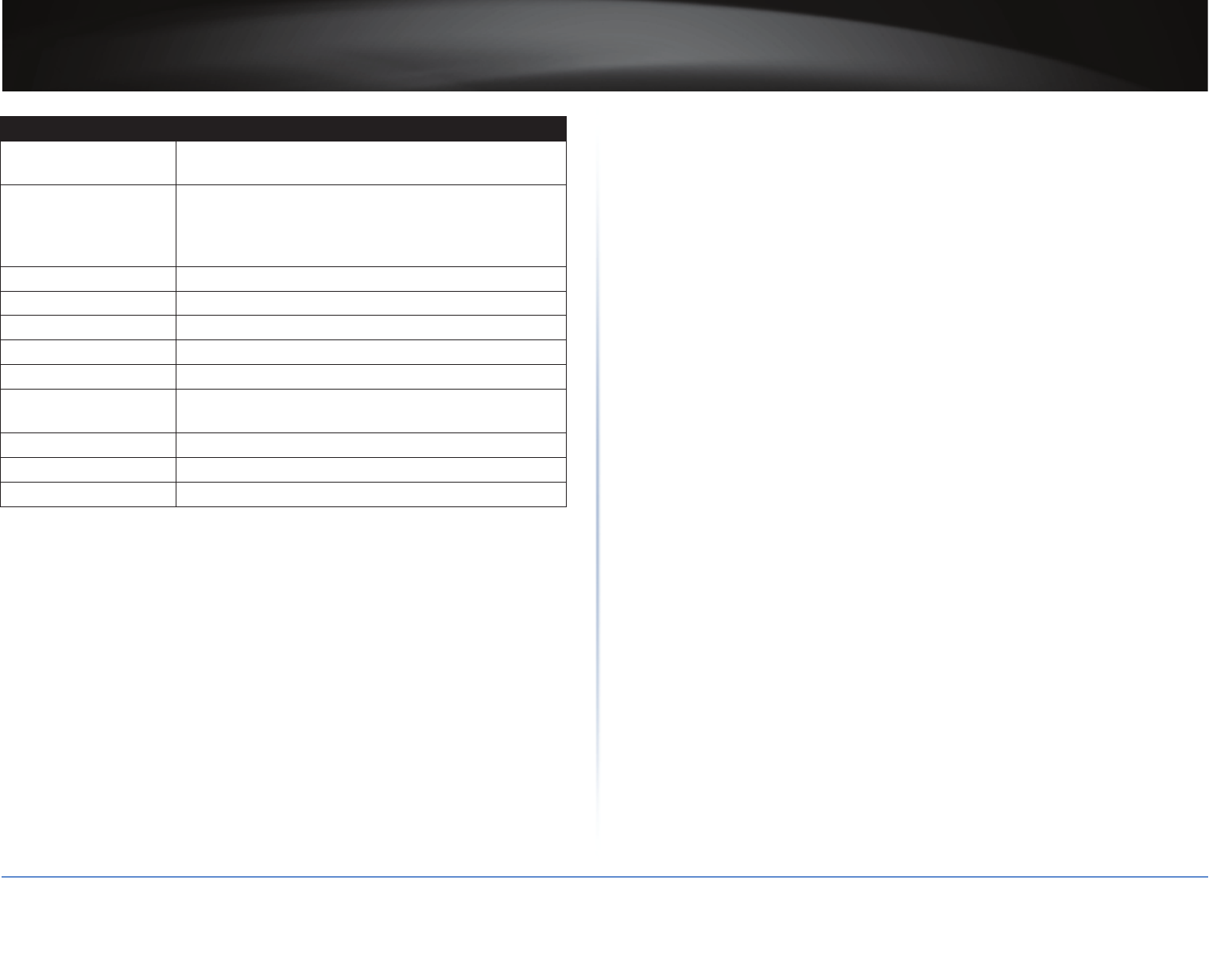
TRENDnet User’s Guide
TEW-821DAP
53
© Copyright 2015 TRENDnet. All Rights Reserved.
Item Specicaons
Range Coverage • Indoor: Up to 100 meters (depends on environment)
• Outdoor: Up to 300 meters (depends on environment)
Diagnosc LEDs • Power
• 2.4G Wireless
• 5G Wireless
• LAN
Power Adapter 12VDC / 1A external power adapter
Power Consumpon 9.6 Wa
Operaon Temperature 0 - 40°C (32 - 104°F)
Storage Temperature -10 ~ 70°C
Operang Humidity Maximum 10% ~ 95% 95%, no condensaon
Cercaons • FCC cercate for USA
• CE cercate for Europe
Dimensions (D x W x H) 187 x 187 x 46 mm (7.4 x 7.4 x 1.8 in.)
Weight 406g (12 oz.)
Warranty 3 years limited warranty

TRENDnet User’s Guide
TEW-821DAP
54
© Copyright 2015 TRENDnet. All Rights Reserved.
Europe – EU Declaraon of Conformity
This device complies with the essenal requirements of the R&TTE Direcve 1999/5/EC,
2006/95/EC and 2009/125/EC.
Regulaon (EC) No. 1275/2008
Regulaon (EC No. 278/2009
EN60950-1 : 2006 + A11 : 2009 + A1: 2010 + A12: 2011
Safety of Informaon Technology Equipment
EN 62311: 2008 :
Assessment of electronic and electrical equipment related to human exposure
restricons for electromagnec elds (0 Hz-300 GHz)
EN 300 328 V1.8.1 : (2012-06) Class B
Electromagnec compability and Radio spectrum Maers (ERM); Wideband
Transmission systems; Data transmission equipment operang in the 2,4 GHz ISM band
and using spread spectrum modulaon techniques; Harmonized EN covering essenal
requirements under arcle 3.2 of the R&TTE Direcve
EN 301 489-1 V1.9.2 : (2011-09)
Electromagnec compability and Radio Spectrum Maers (ERM); ElectroMagnec
Compability (EMC) standard for radio equipment and services; Part 1: Common
technical requirements
EN 301 489-17 V2.2.1 : (2012-09)
Electromagnec compability and Radio spectrum Maers (ERM); ElectroMagnec
Compability (EMC) standard for radio equipment; Part 17: Specic condions for 2,4
GHz wideband transmission systems, 5 GHz high performance RLAN equipment and 5,8
GHz Broadband Data Transming Systems
EN 301 893 V1.7.1 : (2012-06)
Broadband Radio Access Networks (BRAN);5 GHz high performance RLAN;Harmonized EN
covering the essenal requirements of arcle 3.2 of the R&TTE Direcve
This device is a 2.4/5G GHz wideband transmission system (transceiver), intended for use
in all EU member states and EFTA countries, except in France and Italy where restricve
use applies.
In Italy the end-user should apply for a license at the naonal spectrum authories in
order to obtain authorizaon to use the device for seng up outdoor radio links and/or
for supplying public access to telecommunicaons and/or network services.
This device may not be used for seng up outdoor radio links in France and in some
areas the RF output power may be limited to 10 mW EIRP in the frequency range of
2454 – 2483.5 MHz. For detailed informaon the end-user should contact the naonal
spectrum authority in France.
Federal Communicaon Commission Interference Statement
This device complies with Part 15 of the FCC Rules. Operaon is subject to the following
two condions: (1) This device may not cause harmful interference, and (2) this device
must accept any interference received, including interference that may cause undesired
operaon.
This equipment has been tested and found to comply with the limits for a Class B digital
device, pursuant to Part 15 of the FCC Rules. These limits are designed to provide
reasonable protecon against harmful interference in a residenal installaon. This
equipment generates, uses and can radiate radio frequency energy and, if not installed
and used in accordance with the instrucons, may cause harmful interference to radio
communicaons. However, there is no guarantee that interference will not occur in a
parcular installaon. If this equipment does cause harmful interference to radio or
television recepon, which can be determined by turning the equipment o and on, the
user is encouraged to try to correct the interference by one of the following measures:
• Reorient or relocate the receiving antenna.
• Increase the separaon between the equipment and receiver.
• Connect the equipment into an outlet on a circuit dierent from that to which the
receiver is connected.
• Consult the dealer or an experienced radio/TV technician for help.
FCC Cauon: Any changes or modicaons not expressly approved by the party
responsible for compliance could void the user’s authority to operate this equipment.
This device complies with Part 15 of the FCC Rules. Operaon is subject to the following
two condions: (1) This device may not cause harmful interference, and (2) this device
must accept any interference received, including interference that may cause undesired
operaon.
Operaon of this device is restricted to indoor use only.
IMPORTANT NOTE:
FCC Radiaon Exposure Statement:
This equipment complies with FCC radiaon exposure limits set forth for an uncontrolled
environment. This equipment should be installed and operated with minimum distance
20cm between the radiator & your body.
This transmier must not be co-located or operang in conjuncon with any other
antenna or transmier.
Country Code selecon feature to be disabled for products marketed to the US/CANADA
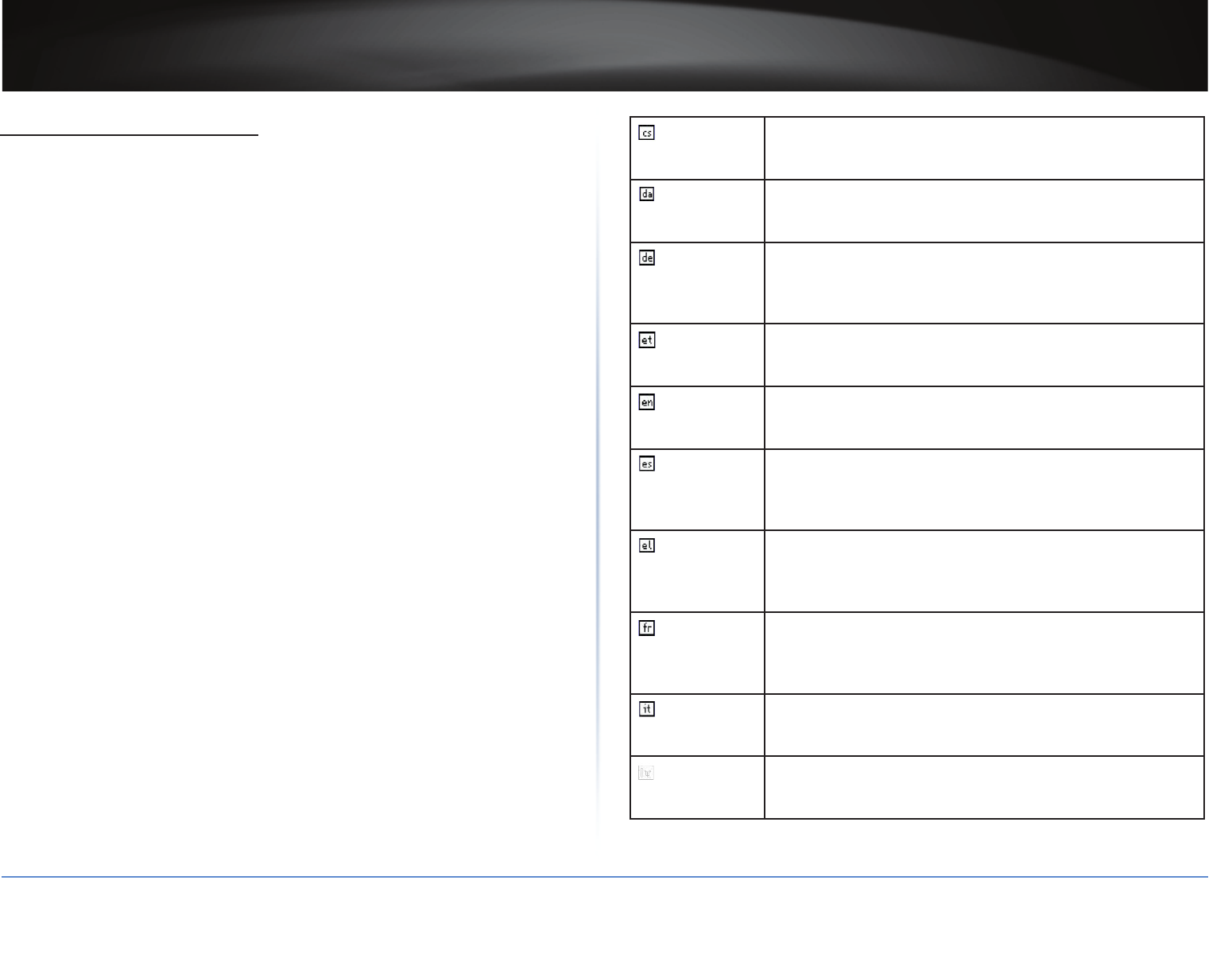
TRENDnet User’s Guide
TEW-821DAP
55
© Copyright 2015 TRENDnet. All Rights Reserved.
Industry Canada Statement:
This device complies with Industry Canada’s licence-exempt RSSs. Operaon is subject to
the following two condions:
(1) This device may not cause interference; and (2) This device must accept any
interference, including interference that may cause undesired operaon of the device.
Cet appareil est conforme aux CNR exemptes de licence d’Industrie Canada. Son
fonconnement est soumis aux deux condions suivantes:
(1) Ce disposif ne peut causer d’interférences; et(2) Ce disposif doit accepter toute
interférence, y compris les interférences qui peuvent causer un mauvais fonconnement
de l’appareil.
Cauon:
(i) the device for operaon in the band 5150-5250 MHz is only for indoor use to reduce
the potenal for harmful interference to co-channel mobile satellite systems;
Averssement:
(i) les disposifs fonconnant dans la bande 5150-5250 MHz sont réservés uniquement
pour une ulisaon à l’intérieur an de réduire les risques de brouillage préjudiciable aux
systèmes de satellites mobiles ulisant les mêmes canaux;
Radiaon Exposure Statement:
This equipment complies with IC radiaon exposure limits set forth for an uncontrolled
environment. This equipment should be installed and operated with minimum distance
20cm between the radiator & your body.
Déclaraon d’exposion aux radiaons:
Cet équipement est conforme aux limites d’exposion aux rayonnements IC établies
pour un environnement non contrôlé. Cet équipement doit être installé et ulisé avec un
minimum de 20 cm de distance entre la source de rayonnement et votre corps.
Česky [Czech] TRENDnet mto prohlašuje, že tento TEW-814DAP je ve shodě
se základními požadavky a dalšími příslušnými ustanoveními
směrnice 1999/5/ES, 2006/95/ES, a 2009/125/ES.
Dansk
[Danish]
Undertegnede TRENDnet erklærer herved, at følgende udstyr
TEW-814DAP overholder de væsentlige krav og øvrige relevante
krav i direkv 1999/5/EF, 2006/95/EF, og 2009/125/EF.
Deutsch
[German]
Hiermit erklärt TRENDnet, dass sich das Gerät TEW-814DAP in
Übereinsmmung mit den grundlegenden Anforderungen und
den übrigen einschlägigen Besmmungen der Richtlinie 1999/5/
EG, 2006/95/EG und 2009/125/EG bendet.
Ees
[Estonian]
Käesolevaga kinnitab TRENDnet seadme TEW814DAP vastavust
direkivi 1999/5/EÜ, 2006/95/EÜ ja 2009/125/EÜ põhinõuetele ja
nimetatud direkivist tulenevatele teistele asjakohastele sätetele.
English Hereby, TRENDnet, declares that this TEW-814DAP is in
compliance with the essenal requirements and other relevant
provisions of Direcve 1999/5/EC, 2006/95/EC, and 2009/125/EC.
Español
[Spanish]
Por medio de la presente TRENDnet declara que el TEW-814DAP
cumple con los requisitos esenciales y cualesquiera otras
disposiciones aplicables o exigibles de la Direcva 1999/5/CE,
2006/95/CE, 2009/125/CE y.
Ελληνική
[Greek]
ΜΕ ΤΗΝ ΠΑΡΟΥΣΑTRENDnet ΔΗΛΩΝΕΙ ΟΤΙ TEW-814DAP
ΣΥΜΜΟΡΦΩΝΕΤΑΙ ΠΡΟΣ ΤΙΣ ΟΥΣΙΩΔΕΙΣ ΑΠΑΙΤΗΣΕΙΣ ΚΑΙ ΤΙΣ
ΛΟΙΠΕΣ ΣΧΕΤΙΚΕΣ ΔΙΑΤΑΞΕΙΣ ΤΗΣ ΟΔΗΓΙΑΣ 1999/5/ΕΚ, 2006/95/ΕΚ,
2009/125/ΕΚ και.
Français
[French]
Par la présente TRENDnet déclare que l’appareil TEW-814DAP est
conforme aux exigences essenelles et aux autres disposions
pernentes de la direcve 1999/5/CE, 2006/95/CE, 2009/125/CE
et.
Italiano
[Italian]
Con la presente TRENDnet dichiara che questo TEW-814DAP è
conforme ai requisi essenziali ed alle altre disposizioni pernen
stabilite dalla direva 1999/5/CE, 2006/95/CE e 2009/125/CE.
Latviski
[Latvian]
AršoTRENDnetdeklarē, ka TEW-814DAP atbilstDirekvas 1999/5/
EK, 2006/95/EK, un 2009/125/EK būskajāmprasībām un ciemar
to saistajiemnoteikumiem.
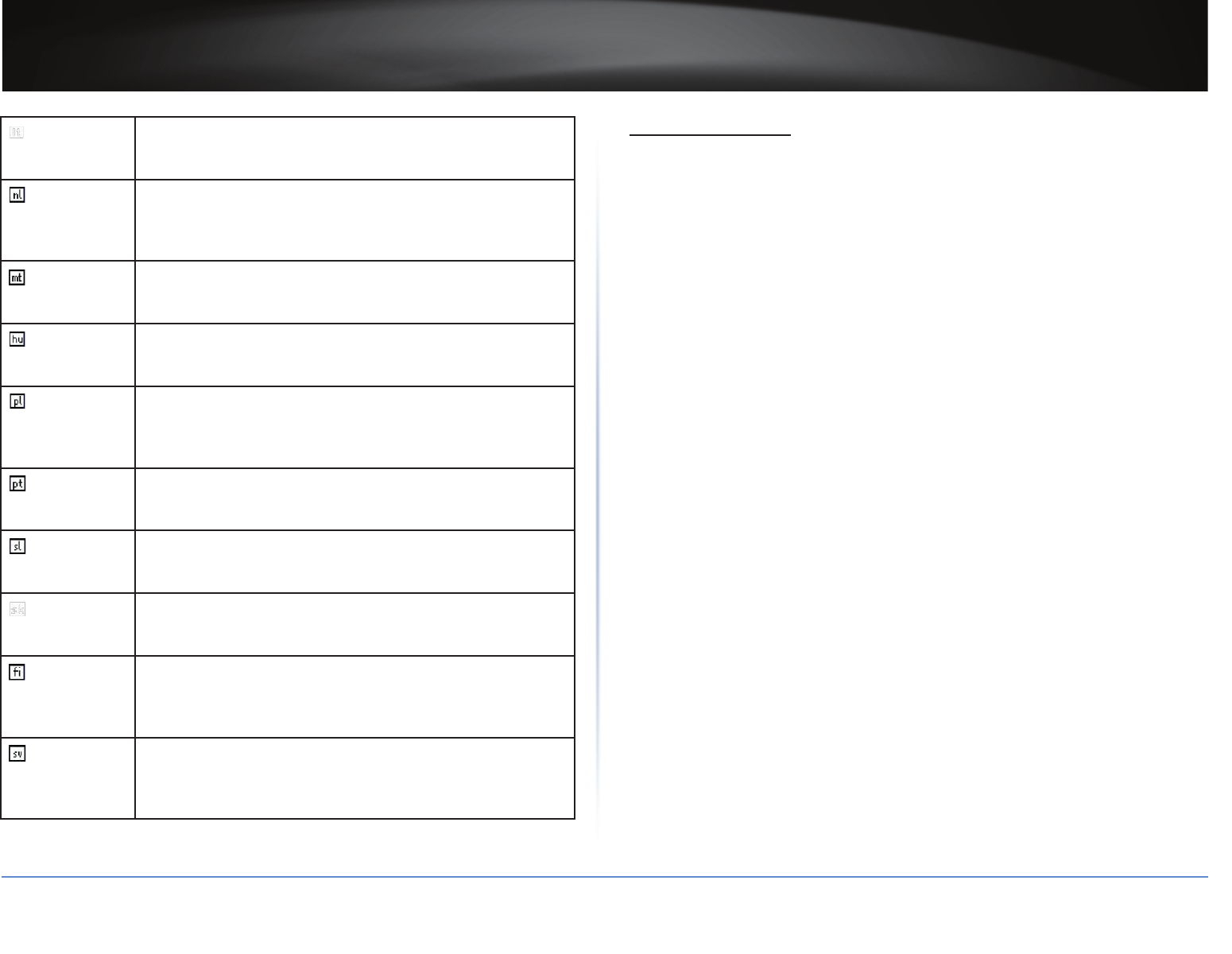
TRENDnet User’s Guide
TEW-821DAP
56
© Copyright 2015 TRENDnet. All Rights Reserved.
Lietuvių
[Lithuanian]
Šiuo TRENDnet deklaruoja, kad šis TEW-814DAP anka esminius
reikalavimus ir kitas 1999/5/EB, 2006/95/EB ir 2009/125/EB
Direktyvos nuostatas.
Nederlands
[Dutch]
Hierbij verklaart TRENDnet dat het toestel TEW-814DAP in
overeenstemming is met de essenële eisen en de andere
relevante bepalingen van richtlijn 1999/5/EG, 2006/95/EG, en
2009/125/EG.
Mal
[Maltese]
Hawnhekk, TRENDnet, jiddikjara li dan TEW-814DAP jikkonforma
mal-ħġijiet essenzjali u ma provvedimen oħrajn relevan li
hemm d-Dirreva 1999/5/KE, 2006/95/KE, u 2009/125/KE.
Magyar
[Hungarian]
Alulíro, TRENDnet nyilatkozom, hogy a TEW-814DAP megfelel a
vonatkozó alapvetõ követelményeknek és az 1999/5/EK irányelv, a
2006/95/EK és a 2009/125/EK irányelv egyéb elõírásainak.
Polski [Polish] Niniejszym TRENDnet oświadcza, że TEW-814DAP jest zgodny
z zasadniczymi wymogami oraz pozostałymi stosownymi
postanowieniami Dyrektywy 1999/5/WE, 2006/95/WE i
2009/125/WE.
Português
[Portuguese]
TRENDnet declara que este TEW-814DAP está conforme com os
requisitos essenciais e outras disposições da Direcva 1999/5/CE,
2006/95/CE e 2009/125/CE.
Slovensko
[Slovenian]
TRENDnet izjavlja, da je ta TEW-814DAP v skladu z bistvenimi
zahtevami in ostalimi relevantnimi določili direkve 1999/5/ES,
2006/95/ES in 2009/125/ES.
Slovensky
[Slovak]
TRENDneýmtovyhlasuje, že TEW-814DAP
spĺňazákladnépožiadavky a všetkypríslušnéustanoveniaSmernice
1999/5/ES, 2006/95/ES, a 2009/125/ES.
Suomi
[Finnish]
TRENDnet vakuuaa täten eä TEW-814DAP tyyppinen laite on
direkivin 1999/5/EY, 2006/95/EY ja 2009/125/EY oleellisten
vaamusten ja sitä koskevien direkivin muiden ehtojen
mukainen.
Svenska
[Swedish]
Härmed intygar TRENDnet a denna TEW-814DAP står I
överensstämmelse med de väsentliga egenskapskrav och övriga
relevanta bestämmelser som framgår av direkv 1999/5/EG,
2006/95/EG och 2009/125/EG.
Limited Warranty
TRENDnet warrants its products against defects in material and workmanship, under
normal use and service, for the following lengths of me from the date of purchase.
• TEW-821DAP – 3 Years Warranty
• AC/DC Power Adapter, Cooling Fan, and Power Supply carry 1 year warranty.
If a product does not operate as warranted during the applicable warranty period,
TRENDnet shall reserve the right, at its expense, to repair or replace the defecve
product or part and deliver an equivalent product or part to the customer. The
repair/replacement unit’s warranty connues from the original date of purchase. All
products that are replaced become the property of TRENDnet. Replacement products
may be new or recondioned. TRENDnet does not issue refunds or credit. Please
contact the point-of-purchase for their return policies.
TRENDnet shall not be responsible for any soware, rmware, informaon, or
memory data of customer contained in, stored on, or integrated with any products
returned to TRENDnet pursuant to any warranty.
There are no user serviceable parts inside the product. Do not remove or aempt to
service the product by any unauthorized service center. This warranty is voided if (i)
the product has been modied or repaired by any unauthorized service center, (ii) the
product was subject to accident, abuse, or improper use (iii) the product was subject
to condions more severe than those specied in the manual.
Warranty service may be obtained by contacng TRENDnet within the applicable
warranty period and providing a copy of the dated proof of the purchase. Upon
proper submission of required documentaon a Return Material Authorizaon (RMA)
number will be issued. An RMA number is required in order to iniate warranty
service support for all TRENDnet products. Products that are sent to TRENDnet for
RMA service must have the RMA number marked on the outside of return packages
and sent to TRENDnet prepaid, insured and packaged appropriately for safe shipment.
Customers shipping from outside of the USA and Canada are responsible for return
shipping fees. Customers shipping from outside of the USA are responsible for custom
charges, including but not limited to, duty, tax, and other fees.

TRENDnet User’s Guide
TEW-821DAP
57
© Copyright 2015 TRENDnet. All Rights Reserved.
WARRANTIES EXCLUSIVE: IF THE TRENDNET PRODUCT DOES NOT OPERATE AS
WARRANTED ABOVE, THE CUSTOMER’S SOLE REMEDY SHALL BE, AT TRENDNET’S
OPTION, REPAIR OR REPLACE. THE FOREGOING WARRANTIES AND REMEDIES ARE
EXCLUSIVE AND ARE IN LIEU OF ALL OTHER WARRANTIES, EXPRESSED OR IMPLIED,
EITHER IN FACT OR BY OPERATION OF LAW, STATUTORY OR OTHERWISE, INCLUDING
WARRANTIES OF MERCHANTABILITY AND FITNESS FOR A PARTICULAR PURPOSE.
TRENDNET NEITHER ASSUMES NOR AUTHORIZES ANY OTHER PERSON TO ASSUME
FOR IT ANY OTHER LIABILITY IN CONNECTION WITH THE SALE, INSTALLATION
MAINTENANCE OR USE OF TRENDNET’S PRODUCTS.
TRENDNET SHALL NOT BE LIABLE UNDER THIS WARRANTY IF ITS TESTING AND
EXAMINATION DISCLOSE THAT THE ALLEGED DEFECT IN THE PRODUCT DOES NOT
EXIST OR WAS CAUSED BY CUSTOMER’S OR ANY THIRD PERSON’S MISUSE, NEGLECT,
IMPROPER INSTALLATION OR TESTING, UNAUTHORIZED ATTEMPTS TO REPAIR OR
MODIFY, OR ANY OTHER CAUSE BEYOND THE RANGE OF THE INTENDED USE, OR BY
ACCIDENT, FIRE, LIGHTNING, OR OTHER HAZARD.
LIMITATION OF LIABILITY: TO THE FULL EXTENT ALLOWED BY LAW TRENDNET ALSO
EXCLUDES FOR ITSELF AND ITS SUPPLIERS ANY LIABILITY, WHETHER BASED IN
CONTRACT OR TORT (INCLUDING NEGLIGENCE), FOR INCIDENTAL, CONSEQUENTIAL,
INDIRECT, SPECIAL, OR PUNITIVE DAMAGES OF ANY KIND, OR FOR LOSS OF
REVENUE OR PROFITS, LOSS OF BUSINESS, LOSS OF INFORMATION OR DATE, OR
OTHER FINANCIAL LOSS ARISING OUT OF OR IN CONNECTION WITH THE SALE,
INSTALLATION, MAINTENANCE, USE, PERFORMANCE, FAILURE, OR INTERRUPTION
OF THE POSSIBILITY OF SUCH DAMAGES, AND LIMITS ITS LIABILITY TO REPAIR,
REPLACEMENT, OR REFUND OF THE PURCHASE PRICE PAID, AT TRENDNET’S OPTION.
THIS DISCLAIMER OF LIABILITY FOR DAMAGES WILL NOT BE AFFECTED IF ANY REMEDY
PROVIDED HEREIN SHALL FAIL OF ITS ESSENTIAL PURPOSE.
Governing Law: This Limited Warranty shall be governed by the laws of the state of
California.
Some TRENDnet products include soware code wrien by third party developers.
These codes are subject to the GNU General Public License (“GPL”) or GNU Lesser
General Public License (“LGPL”).
Go to hp://www.trendnet.com/gpl or hp://www.trendnet.com Download secon
and look for the desired TRENDnet product to access to the GPL Code or LGPL Code.
These codes are distributed WITHOUT WARRANTY and are subject to the copyrights
of the developers. TRENDnet does not provide technical support for these codes.
Please go to hp://www.gnu.org/licenses/gpl.txt or
hp://www.gnu.org/licenses/lgpl.txt for specic terms of each license.

Product Warranty Registration
Please take a moment to register your product online.
Go to TRENDnet’s website at http://www.trendent.com/register
TRENDnet
20675 Manhattan Place
Torrance, CA 90501. USA
Copyright ©2015. All Rights Reserved.TRENDnet.